

Compact Muon Solenoid
LHC, CERN
| CMS-PAS-TOP-17-014 | ||
| Measurements of differential cross sections for $\mathrm{t \bar t}$ production in proton-proton collisions at $\sqrt{s}= $ 13 TeV using events containing two leptons | ||
| CMS Collaboration | ||
| June 2018 | ||
| Abstract: Measurements are presented of differential top quark pair ($\mathrm{t \bar t}$) production cross sections using events containing two leptons produced in proton-proton collisions at a centre-of-mass energy of 13 TeV. The data were recorded by the CMS experiment at the CERN LHC in 2016 and correspond to an integrated luminosity of 35.9 fb$^{-1}$. The differential cross sections are presented as functions of kinematic observables of the top quarks and their decay products, the $\mathrm{t \bar t}$ system, and the total number of jets in the event. The differential cross sections are defined both with particle-level objects in a fiducial phase space close to that of the detector acceptance and with parton-level top quarks in the full phase space. All results are compared with standard model predictions from Monte Carlo simulations with next-to-leading-order (NLO) accuracy in quantum chromodynamics (QCD) at matrix-element level interfaced to parton-shower simulations. Where possible, parton-level results are compared to calculations with beyond NLO precision in QCD. Significant disagreement is observed between data and predictions for numerous observables. The measurements are used to constrain the top quark chromomagnetic dipole moment in an effective field theory framework at NLO in QCD and to extract $\mathrm{t \bar t}$ and leptonic charge asymmetries. | ||
|
Links:
CDS record (PDF) ;
inSPIRE record ;
CADI line (restricted) ;
These preliminary results are superseded in this paper, JHEP 02 (2019) 149. The superseded preliminary plots can be found here. |
||
| Figures | |
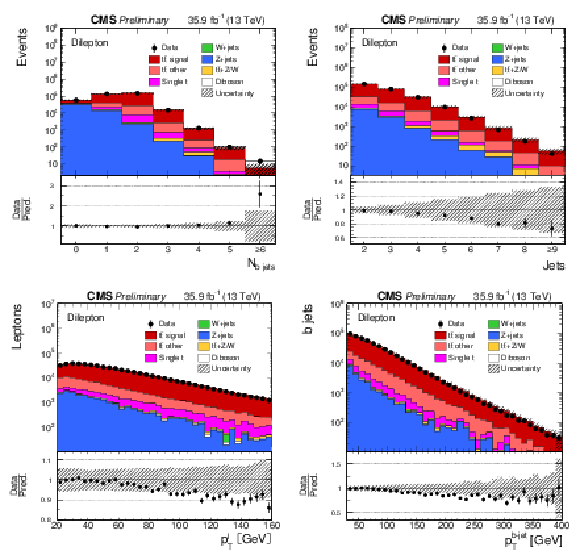
png pdf |
Figure 1:
Distributions of the multiplicity of b jets (upper left), the multiplicity of jets (upper right), the $ {p_{\mathrm {T}}} $ of the selected isolated leptons (lower left), and the $ {p_{\mathrm {T}}} $ of the reconstructed b jets (lower right) are shown from data (points) and simulation (histograms). The vertical bars on the points represent the statistical uncertainties in the data. The hatched regions correspond to the systematic uncertainties in the signal and backgrounds described in Section xxxxx. The lower panel of each plot shows the ratio of the data to the predictions from simulation. |
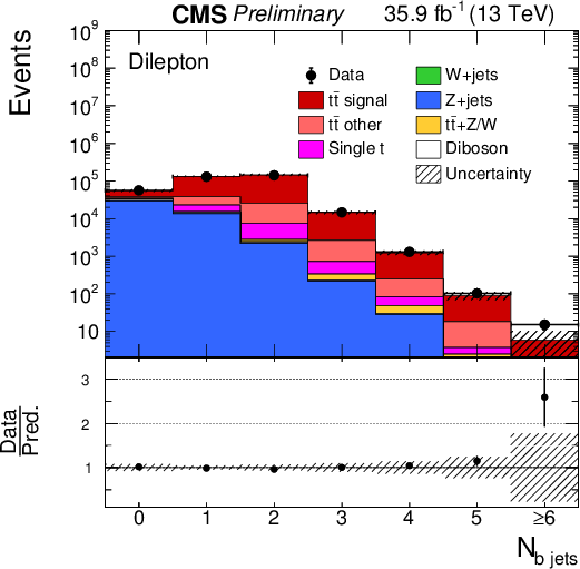
png pdf |
Figure 1-a:
Distributions of the multiplicity of b jets (upper left), the multiplicity of jets (upper right), the $ {p_{\mathrm {T}}} $ of the selected isolated leptons (lower left), and the $ {p_{\mathrm {T}}} $ of the reconstructed b jets (lower right) are shown from data (points) and simulation (histograms). The vertical bars on the points represent the statistical uncertainties in the data. The hatched regions correspond to the systematic uncertainties in the signal and backgrounds described in Section xxxxx. The lower panel of each plot shows the ratio of the data to the predictions from simulation. |
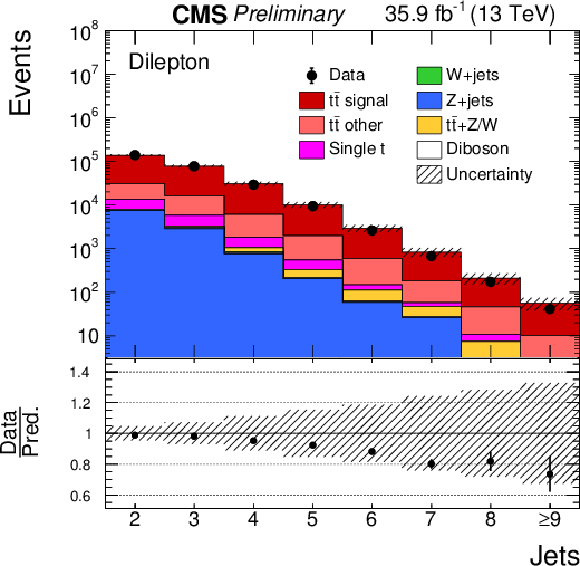
png pdf |
Figure 1-b:
Distributions of the multiplicity of b jets (upper left), the multiplicity of jets (upper right), the $ {p_{\mathrm {T}}} $ of the selected isolated leptons (lower left), and the $ {p_{\mathrm {T}}} $ of the reconstructed b jets (lower right) are shown from data (points) and simulation (histograms). The vertical bars on the points represent the statistical uncertainties in the data. The hatched regions correspond to the systematic uncertainties in the signal and backgrounds described in Section xxxxx. The lower panel of each plot shows the ratio of the data to the predictions from simulation. |
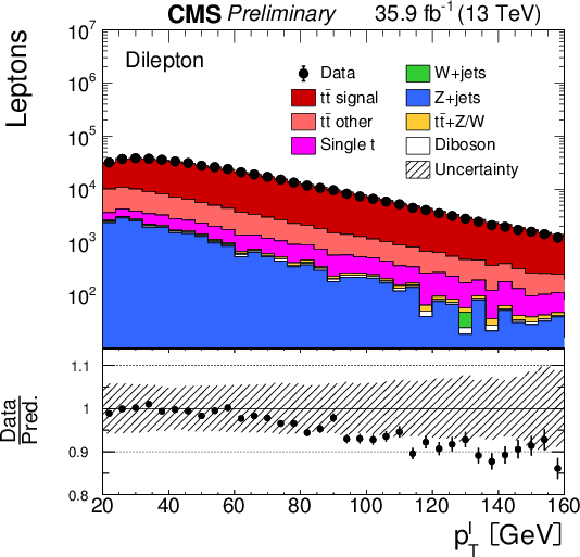
png pdf |
Figure 1-c:
Distributions of the multiplicity of b jets (upper left), the multiplicity of jets (upper right), the $ {p_{\mathrm {T}}} $ of the selected isolated leptons (lower left), and the $ {p_{\mathrm {T}}} $ of the reconstructed b jets (lower right) are shown from data (points) and simulation (histograms). The vertical bars on the points represent the statistical uncertainties in the data. The hatched regions correspond to the systematic uncertainties in the signal and backgrounds described in Section xxxxx. The lower panel of each plot shows the ratio of the data to the predictions from simulation. |
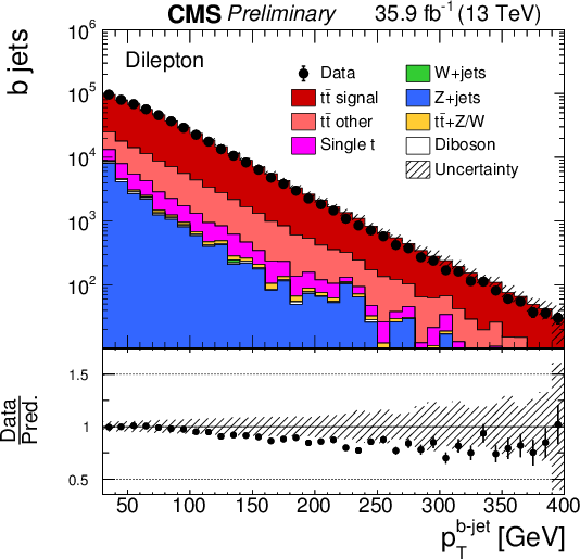
png pdf |
Figure 1-d:
Distributions of the multiplicity of b jets (upper left), the multiplicity of jets (upper right), the $ {p_{\mathrm {T}}} $ of the selected isolated leptons (lower left), and the $ {p_{\mathrm {T}}} $ of the reconstructed b jets (lower right) are shown from data (points) and simulation (histograms). The vertical bars on the points represent the statistical uncertainties in the data. The hatched regions correspond to the systematic uncertainties in the signal and backgrounds described in Section xxxxx. The lower panel of each plot shows the ratio of the data to the predictions from simulation. |
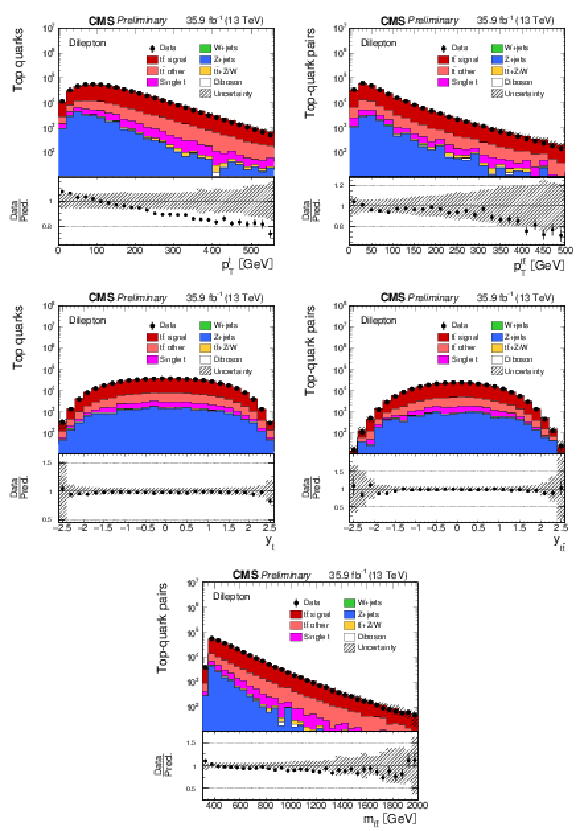
png pdf |
Figure 2:
Distributions of the $ {p_{\mathrm {T}}} $ (upper row) and rapidities (middle row), at detector level for the top quarks (left column), and $ {\text {t}\bar{\text {t}}} $ system (right column), and $m_{{\text {t}\bar{\text {t}}}}$ (lower plot) are shown from data (points) and simulation (histograms). The vertical bars on the points represent the statistical uncertainties in the data. The hatched regions correspond to the systematic uncertainties in the signal and backgrounds described in Section xxxxx. The lower panel of each plot shows the ratio of the data to the predictions from simulation. |

png pdf |
Figure 2-a:
Distributions of the $ {p_{\mathrm {T}}} $ (upper row) and rapidities (middle row), at detector level for the top quarks (left column), and $ {\text {t}\bar{\text {t}}} $ system (right column), and $m_{{\text {t}\bar{\text {t}}}}$ (lower plot) are shown from data (points) and simulation (histograms). The vertical bars on the points represent the statistical uncertainties in the data. The hatched regions correspond to the systematic uncertainties in the signal and backgrounds described in Section xxxxx. The lower panel of each plot shows the ratio of the data to the predictions from simulation. |
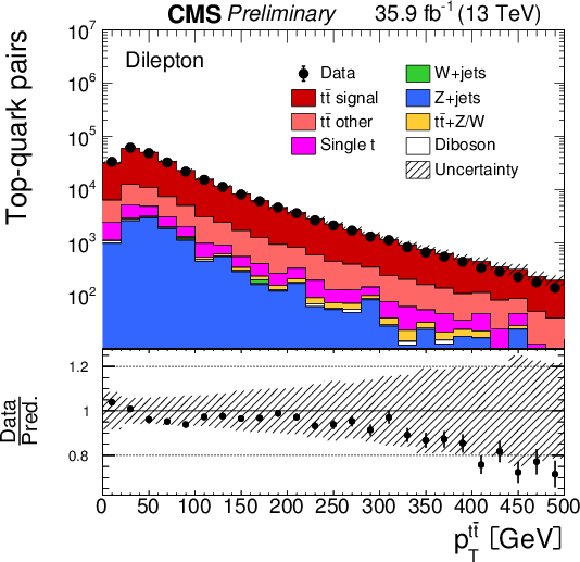
png pdf |
Figure 2-b:
Distributions of the $ {p_{\mathrm {T}}} $ (upper row) and rapidities (middle row), at detector level for the top quarks (left column), and $ {\text {t}\bar{\text {t}}} $ system (right column), and $m_{{\text {t}\bar{\text {t}}}}$ (lower plot) are shown from data (points) and simulation (histograms). The vertical bars on the points represent the statistical uncertainties in the data. The hatched regions correspond to the systematic uncertainties in the signal and backgrounds described in Section xxxxx. The lower panel of each plot shows the ratio of the data to the predictions from simulation. |
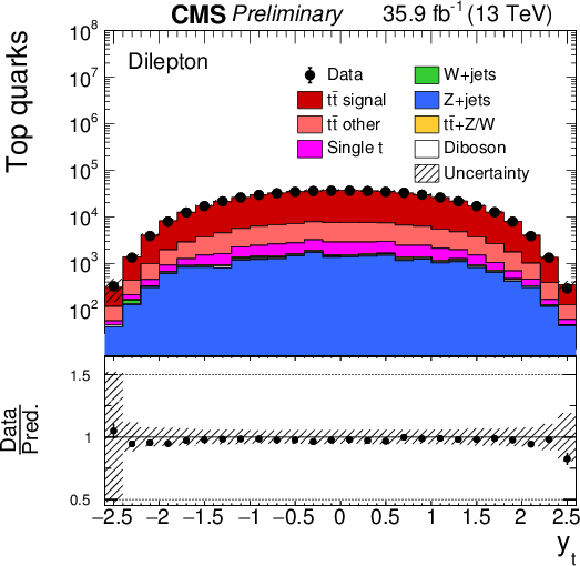
png pdf |
Figure 2-c:
Distributions of the $ {p_{\mathrm {T}}} $ (upper row) and rapidities (middle row), at detector level for the top quarks (left column), and $ {\text {t}\bar{\text {t}}} $ system (right column), and $m_{{\text {t}\bar{\text {t}}}}$ (lower plot) are shown from data (points) and simulation (histograms). The vertical bars on the points represent the statistical uncertainties in the data. The hatched regions correspond to the systematic uncertainties in the signal and backgrounds described in Section xxxxx. The lower panel of each plot shows the ratio of the data to the predictions from simulation. |
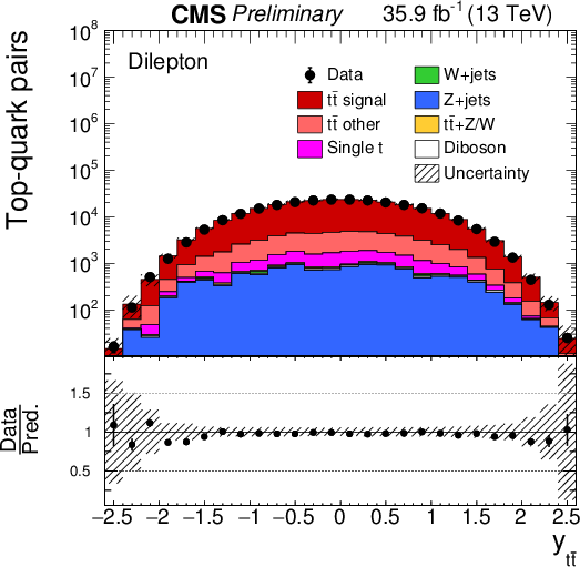
png pdf |
Figure 2-d:
Distributions of the $ {p_{\mathrm {T}}} $ (upper row) and rapidities (middle row), at detector level for the top quarks (left column), and $ {\text {t}\bar{\text {t}}} $ system (right column), and $m_{{\text {t}\bar{\text {t}}}}$ (lower plot) are shown from data (points) and simulation (histograms). The vertical bars on the points represent the statistical uncertainties in the data. The hatched regions correspond to the systematic uncertainties in the signal and backgrounds described in Section xxxxx. The lower panel of each plot shows the ratio of the data to the predictions from simulation. |

png pdf |
Figure 2-e:
Distributions of the $ {p_{\mathrm {T}}} $ (upper row) and rapidities (middle row), at detector level for the top quarks (left column), and $ {\text {t}\bar{\text {t}}} $ system (right column), and $m_{{\text {t}\bar{\text {t}}}}$ (lower plot) are shown from data (points) and simulation (histograms). The vertical bars on the points represent the statistical uncertainties in the data. The hatched regions correspond to the systematic uncertainties in the signal and backgrounds described in Section xxxxx. The lower panel of each plot shows the ratio of the data to the predictions from simulation. |
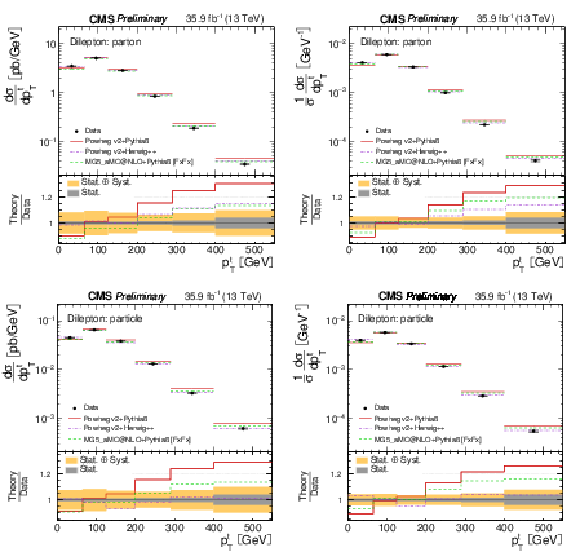
png pdf |
Figure 3:
The differential $ {\text {t}\bar{\text {t}}} $ production cross sections at parton level in full phase space as a function of $ {p_{\mathrm {T}}} ^{\text {t}} $ are shown. The left and right columns correspond to absolute and normalised measurements, respectively. The upper row corresponds to measurements at parton level in the full phase space and the lower row to particle level in a fiducial phase space. The lower panel in each plot shows the ratio of the theoretical prediction to the data. |
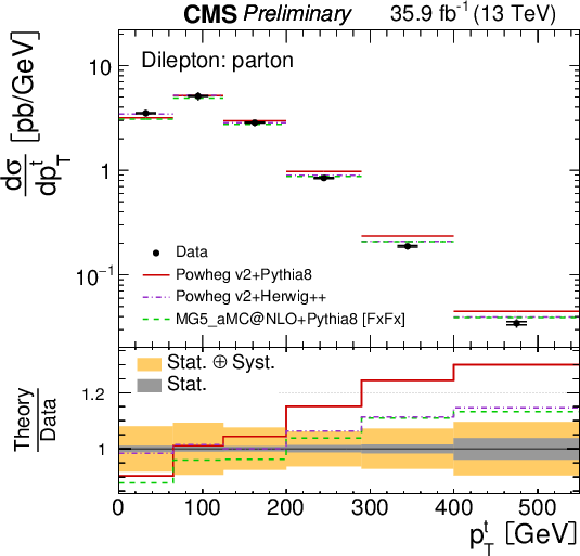
png pdf |
Figure 3-a:
The differential $ {\text {t}\bar{\text {t}}} $ production cross sections at parton level in full phase space as a function of $ {p_{\mathrm {T}}} ^{\text {t}} $ are shown. The left and right columns correspond to absolute and normalised measurements, respectively. The upper row corresponds to measurements at parton level in the full phase space and the lower row to particle level in a fiducial phase space. The lower panel in each plot shows the ratio of the theoretical prediction to the data. |
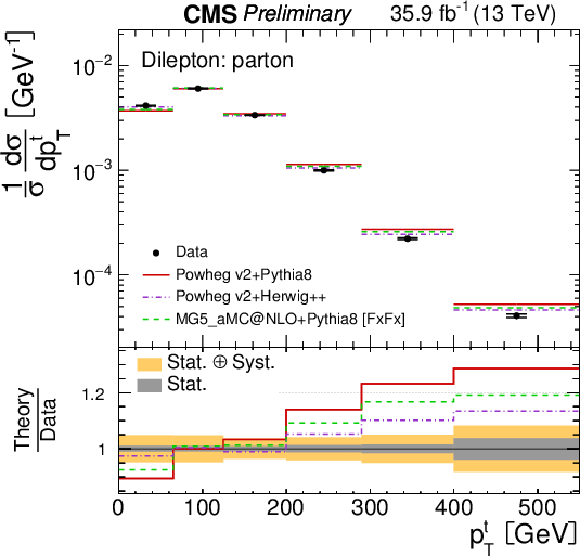
png pdf |
Figure 3-b:
The differential $ {\text {t}\bar{\text {t}}} $ production cross sections at parton level in full phase space as a function of $ {p_{\mathrm {T}}} ^{\text {t}} $ are shown. The left and right columns correspond to absolute and normalised measurements, respectively. The upper row corresponds to measurements at parton level in the full phase space and the lower row to particle level in a fiducial phase space. The lower panel in each plot shows the ratio of the theoretical prediction to the data. |

png pdf |
Figure 3-c:
The differential $ {\text {t}\bar{\text {t}}} $ production cross sections at parton level in full phase space as a function of $ {p_{\mathrm {T}}} ^{\text {t}} $ are shown. The left and right columns correspond to absolute and normalised measurements, respectively. The upper row corresponds to measurements at parton level in the full phase space and the lower row to particle level in a fiducial phase space. The lower panel in each plot shows the ratio of the theoretical prediction to the data. |
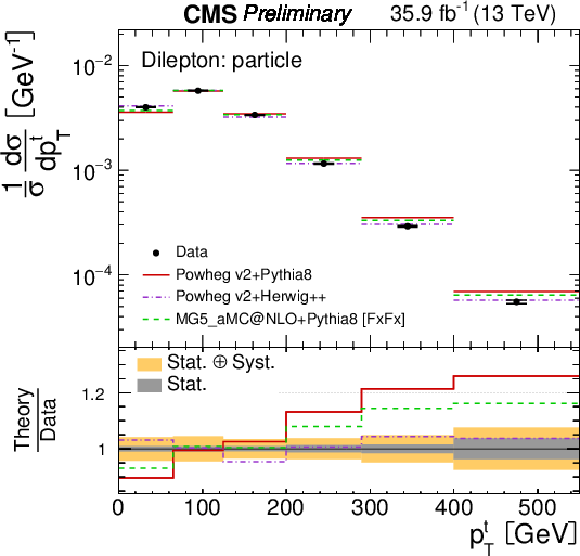
png pdf |
Figure 3-d:
The differential $ {\text {t}\bar{\text {t}}} $ production cross sections at parton level in full phase space as a function of $ {p_{\mathrm {T}}} ^{\text {t}} $ are shown. The left and right columns correspond to absolute and normalised measurements, respectively. The upper row corresponds to measurements at parton level in the full phase space and the lower row to particle level in a fiducial phase space. The lower panel in each plot shows the ratio of the theoretical prediction to the data. |
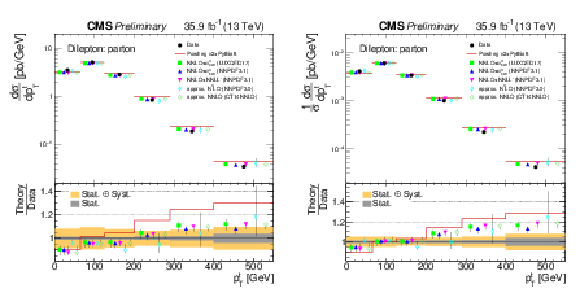
png pdf |
Figure 4:
The differential $ {\text {t}\bar{\text {t}}} $ production cross sections at parton level in full phase space as a function of $ {p_{\mathrm {T}}} ^{\text {t}}$ are compared to theoretical predictions with beyond NLO precision. The left and right plots correspond to absolute and normalised measurements, respectively. The lower panel in each plot shows the ratio of the theoretical prediction to the data. |
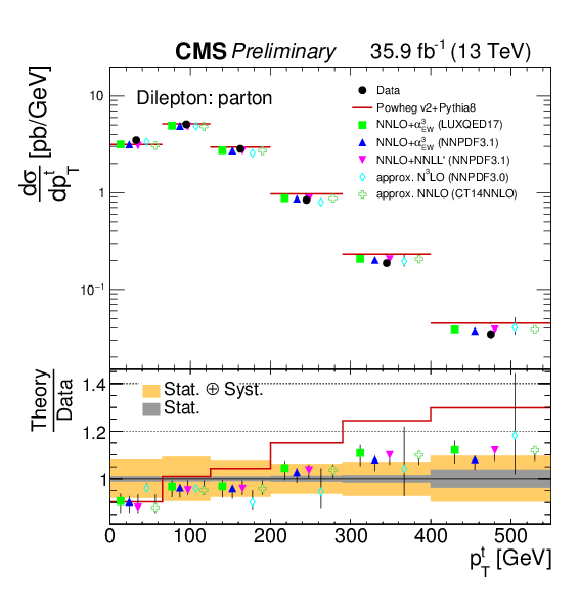
png pdf |
Figure 4-a:
The differential $ {\text {t}\bar{\text {t}}} $ production cross sections at parton level in full phase space as a function of $ {p_{\mathrm {T}}} ^{\text {t}}$ are compared to theoretical predictions with beyond NLO precision. The left and right plots correspond to absolute and normalised measurements, respectively. The lower panel in each plot shows the ratio of the theoretical prediction to the data. |
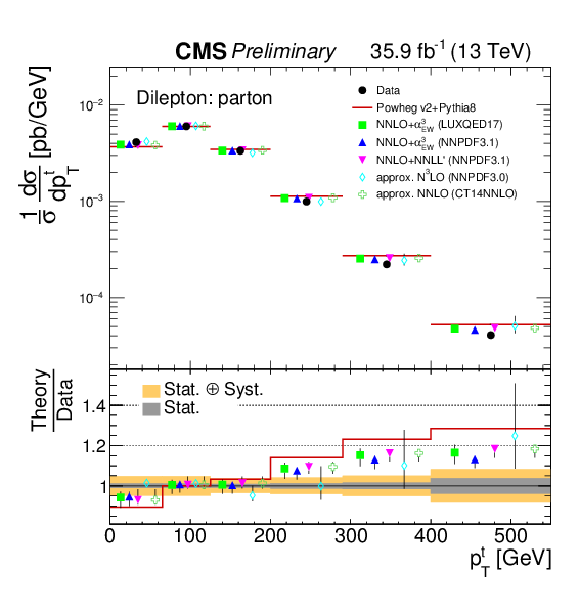
png pdf |
Figure 4-b:
The differential $ {\text {t}\bar{\text {t}}} $ production cross sections at parton level in full phase space as a function of $ {p_{\mathrm {T}}} ^{\text {t}}$ are compared to theoretical predictions with beyond NLO precision. The left and right plots correspond to absolute and normalised measurements, respectively. The lower panel in each plot shows the ratio of the theoretical prediction to the data. |
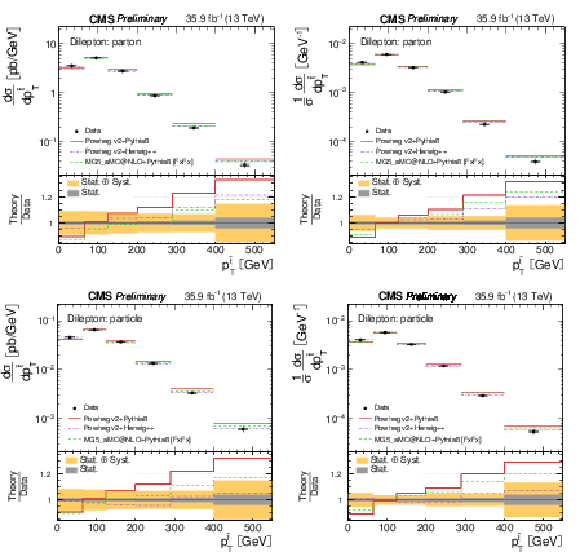
png pdf |
Figure 5:
The differential $ {\text {t}\bar{\text {t}}} $ production cross sections as a function of $ {p_{\mathrm {T}}} ^{ {\bar{\text {t}}} } $ are shown. The left and right columns correspond to absolute and normalised measurements, respectively. The upper row corresponds to measurements at parton level in the full phase space and the lower row to particle level in a fiducial phase space. The lower panel in each plot shows the ratio of the theoretical prediction to the data. |
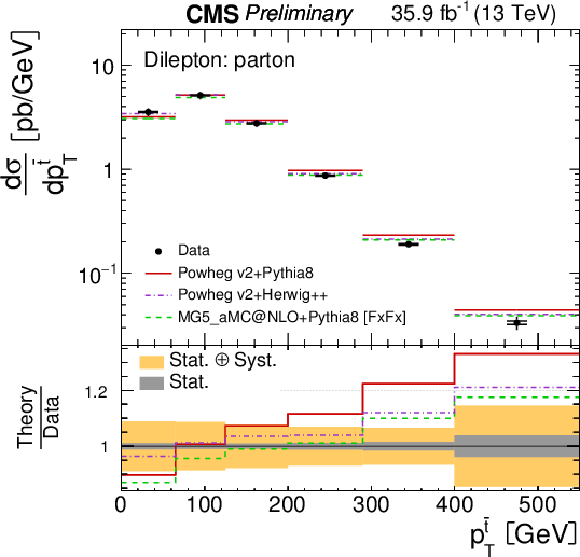
png pdf |
Figure 5-a:
The differential $ {\text {t}\bar{\text {t}}} $ production cross sections as a function of $ {p_{\mathrm {T}}} ^{ {\bar{\text {t}}} } $ are shown. The left and right columns correspond to absolute and normalised measurements, respectively. The upper row corresponds to measurements at parton level in the full phase space and the lower row to particle level in a fiducial phase space. The lower panel in each plot shows the ratio of the theoretical prediction to the data. |
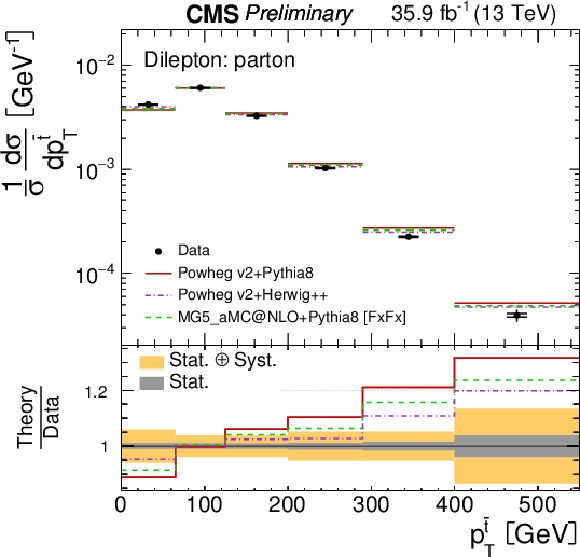
png pdf |
Figure 5-b:
The differential $ {\text {t}\bar{\text {t}}} $ production cross sections as a function of $ {p_{\mathrm {T}}} ^{ {\bar{\text {t}}} } $ are shown. The left and right columns correspond to absolute and normalised measurements, respectively. The upper row corresponds to measurements at parton level in the full phase space and the lower row to particle level in a fiducial phase space. The lower panel in each plot shows the ratio of the theoretical prediction to the data. |
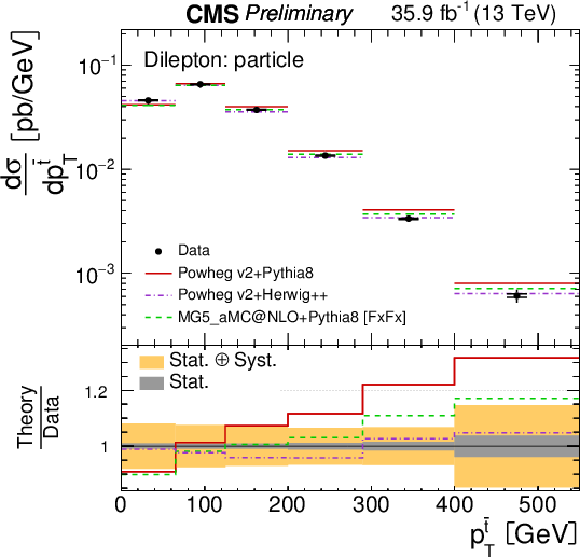
png pdf |
Figure 5-c:
The differential $ {\text {t}\bar{\text {t}}} $ production cross sections as a function of $ {p_{\mathrm {T}}} ^{ {\bar{\text {t}}} } $ are shown. The left and right columns correspond to absolute and normalised measurements, respectively. The upper row corresponds to measurements at parton level in the full phase space and the lower row to particle level in a fiducial phase space. The lower panel in each plot shows the ratio of the theoretical prediction to the data. |
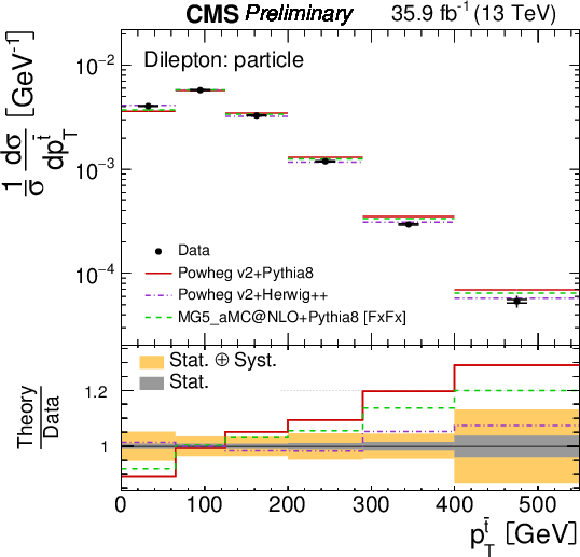
png pdf |
Figure 5-d:
The differential $ {\text {t}\bar{\text {t}}} $ production cross sections as a function of $ {p_{\mathrm {T}}} ^{ {\bar{\text {t}}} } $ are shown. The left and right columns correspond to absolute and normalised measurements, respectively. The upper row corresponds to measurements at parton level in the full phase space and the lower row to particle level in a fiducial phase space. The lower panel in each plot shows the ratio of the theoretical prediction to the data. |
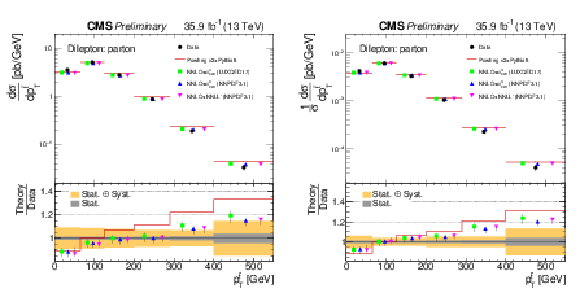
png pdf |
Figure 6:
The differential $ {\text {t}\bar{\text {t}}} $ production cross sections at parton level in full phase space as a function of $ {p_{\mathrm {T}}} ^{{\bar{\text {t}}}}$ are compared to theoretical predictions with beyond NLO precision. The left and right plots correspond to absolute and normalised measurements, respectively. The lower panel in each plot shows the ratio of the theoretical prediction to the data. |
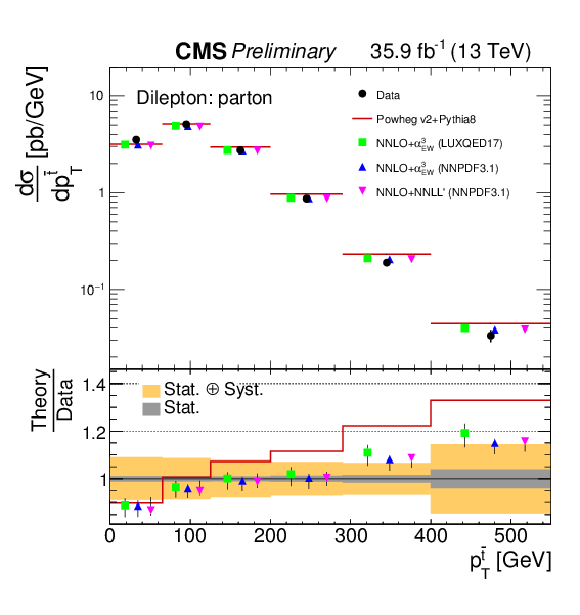
png pdf |
Figure 6-a:
The differential $ {\text {t}\bar{\text {t}}} $ production cross sections at parton level in full phase space as a function of $ {p_{\mathrm {T}}} ^{{\bar{\text {t}}}}$ are compared to theoretical predictions with beyond NLO precision. The left and right plots correspond to absolute and normalised measurements, respectively. The lower panel in each plot shows the ratio of the theoretical prediction to the data. |

png pdf |
Figure 6-b:
The differential $ {\text {t}\bar{\text {t}}} $ production cross sections at parton level in full phase space as a function of $ {p_{\mathrm {T}}} ^{{\bar{\text {t}}}}$ are compared to theoretical predictions with beyond NLO precision. The left and right plots correspond to absolute and normalised measurements, respectively. The lower panel in each plot shows the ratio of the theoretical prediction to the data. |
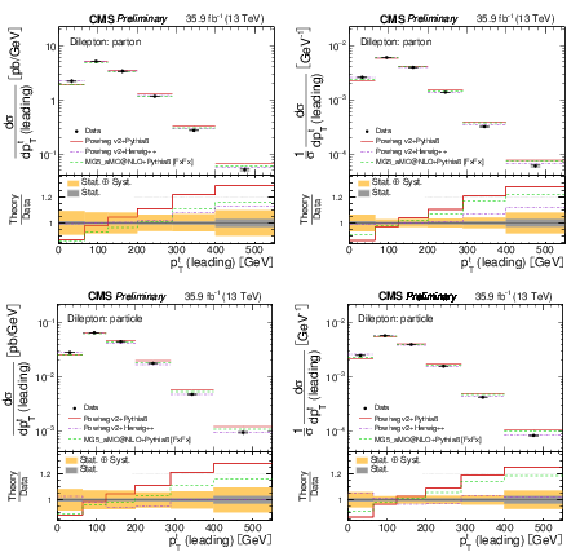
png pdf |
Figure 7:
The differential $ {\text {t}\bar{\text {t}}} $ production cross sections as a function of $ {p_{\mathrm {T}}} ^{\text {t}}$ (leading) are shown. The left and right columns correspond to absolute and normalised measurements, respectively. The upper row corresponds to measurements at parton level in the full phase space and the lower row to particle level in a fiducial phase space. The lower panel in each plot shows the ratio of the theoretical prediction to the data. |
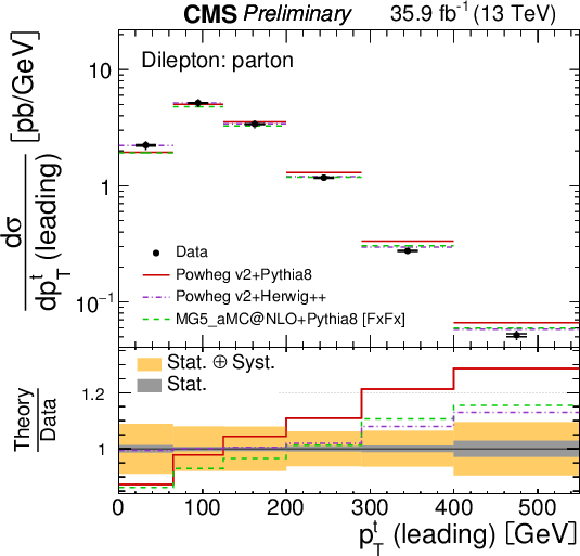
png pdf |
Figure 7-a:
The differential $ {\text {t}\bar{\text {t}}} $ production cross sections as a function of $ {p_{\mathrm {T}}} ^{\text {t}}$ (leading) are shown. The left and right columns correspond to absolute and normalised measurements, respectively. The upper row corresponds to measurements at parton level in the full phase space and the lower row to particle level in a fiducial phase space. The lower panel in each plot shows the ratio of the theoretical prediction to the data. |
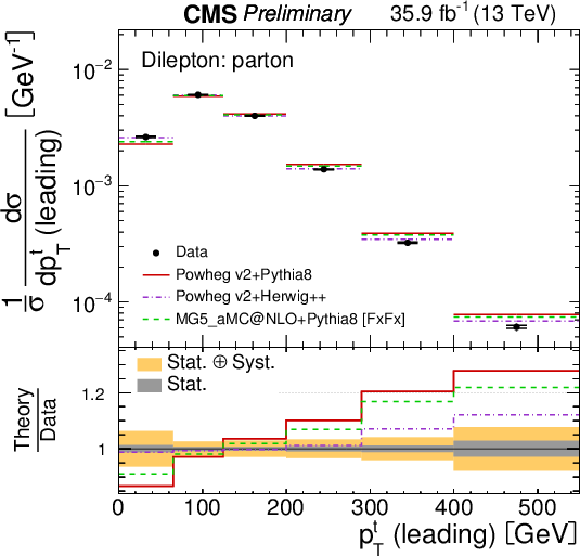
png pdf |
Figure 7-b:
The differential $ {\text {t}\bar{\text {t}}} $ production cross sections as a function of $ {p_{\mathrm {T}}} ^{\text {t}}$ (leading) are shown. The left and right columns correspond to absolute and normalised measurements, respectively. The upper row corresponds to measurements at parton level in the full phase space and the lower row to particle level in a fiducial phase space. The lower panel in each plot shows the ratio of the theoretical prediction to the data. |
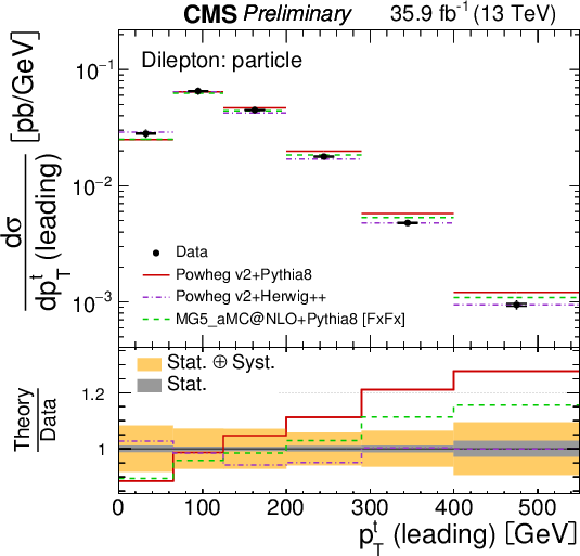
png pdf |
Figure 7-c:
The differential $ {\text {t}\bar{\text {t}}} $ production cross sections as a function of $ {p_{\mathrm {T}}} ^{\text {t}}$ (leading) are shown. The left and right columns correspond to absolute and normalised measurements, respectively. The upper row corresponds to measurements at parton level in the full phase space and the lower row to particle level in a fiducial phase space. The lower panel in each plot shows the ratio of the theoretical prediction to the data. |
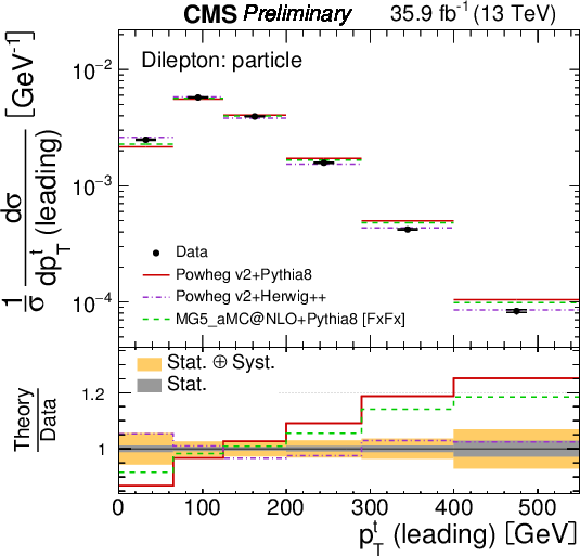
png pdf |
Figure 7-d:
The differential $ {\text {t}\bar{\text {t}}} $ production cross sections as a function of $ {p_{\mathrm {T}}} ^{\text {t}}$ (leading) are shown. The left and right columns correspond to absolute and normalised measurements, respectively. The upper row corresponds to measurements at parton level in the full phase space and the lower row to particle level in a fiducial phase space. The lower panel in each plot shows the ratio of the theoretical prediction to the data. |
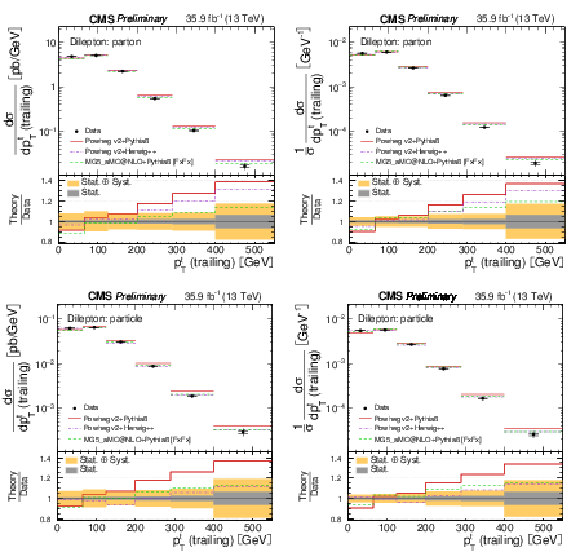
png pdf |
Figure 8:
The differential $ {\text {t}\bar{\text {t}}} $ production cross sections as a function of $ {p_{\mathrm {T}}} ^{\text {t}}$ (trailing) are shown. The left and right columns correspond to absolute and normalised measurements, respectively. The upper row corresponds to measurements at parton level in the full phase space and the lower row to particle level in a fiducial phase space. The lower panel in each plot shows the ratio of the theoretical prediction to the data. |
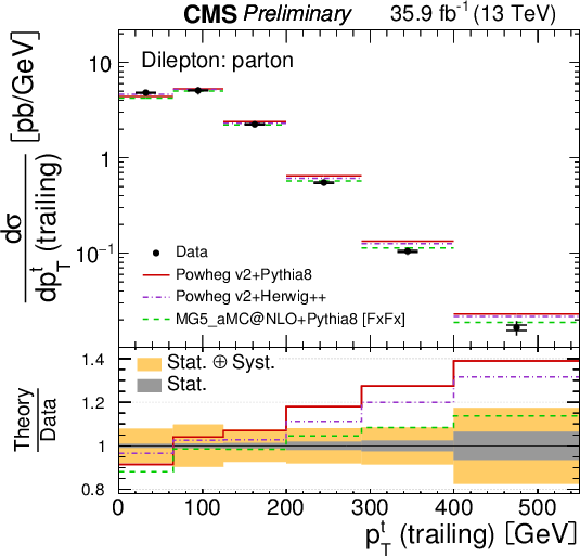
png pdf |
Figure 8-a:
The differential $ {\text {t}\bar{\text {t}}} $ production cross sections as a function of $ {p_{\mathrm {T}}} ^{\text {t}}$ (trailing) are shown. The left and right columns correspond to absolute and normalised measurements, respectively. The upper row corresponds to measurements at parton level in the full phase space and the lower row to particle level in a fiducial phase space. The lower panel in each plot shows the ratio of the theoretical prediction to the data. |
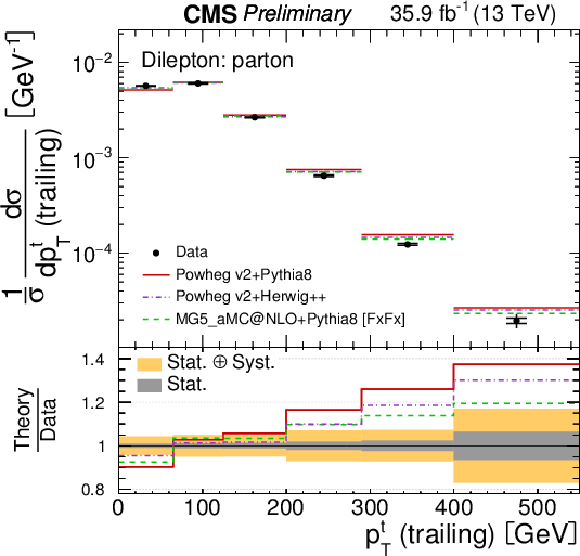
png pdf |
Figure 8-b:
The differential $ {\text {t}\bar{\text {t}}} $ production cross sections as a function of $ {p_{\mathrm {T}}} ^{\text {t}}$ (trailing) are shown. The left and right columns correspond to absolute and normalised measurements, respectively. The upper row corresponds to measurements at parton level in the full phase space and the lower row to particle level in a fiducial phase space. The lower panel in each plot shows the ratio of the theoretical prediction to the data. |
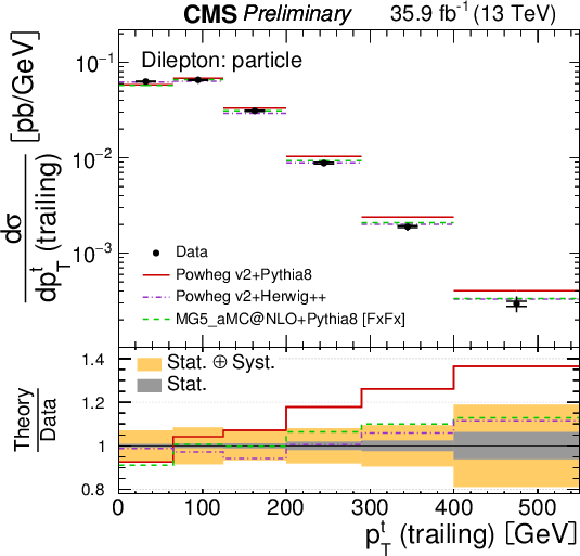
png pdf |
Figure 8-c:
The differential $ {\text {t}\bar{\text {t}}} $ production cross sections as a function of $ {p_{\mathrm {T}}} ^{\text {t}}$ (trailing) are shown. The left and right columns correspond to absolute and normalised measurements, respectively. The upper row corresponds to measurements at parton level in the full phase space and the lower row to particle level in a fiducial phase space. The lower panel in each plot shows the ratio of the theoretical prediction to the data. |
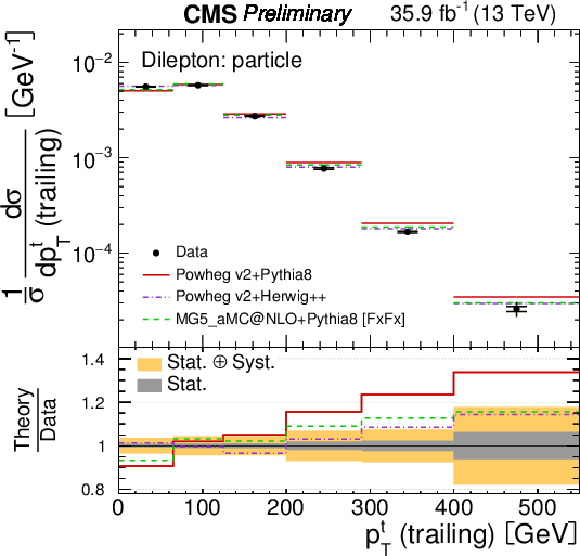
png pdf |
Figure 8-d:
The differential $ {\text {t}\bar{\text {t}}} $ production cross sections as a function of $ {p_{\mathrm {T}}} ^{\text {t}}$ (trailing) are shown. The left and right columns correspond to absolute and normalised measurements, respectively. The upper row corresponds to measurements at parton level in the full phase space and the lower row to particle level in a fiducial phase space. The lower panel in each plot shows the ratio of the theoretical prediction to the data. |
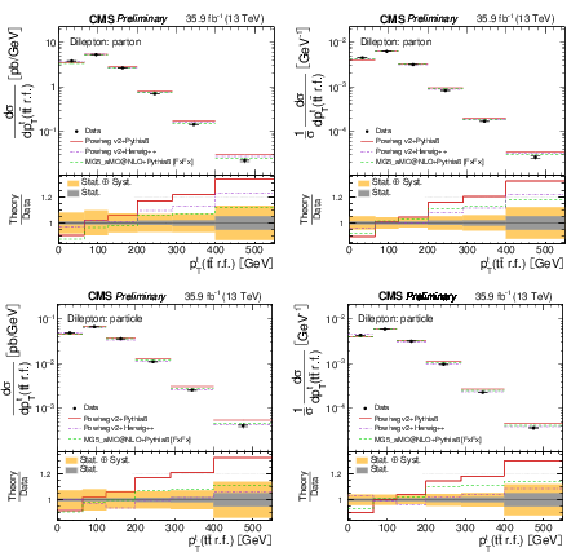
png pdf |
Figure 9:
The differential $ {\text {t}\bar{\text {t}}} $ production cross sections as a function of $ {p_{\mathrm {T}}} ^{\text {t}}$($ {\text {t}\bar{\text {t}}} $ r.f.) system are shown. The left and right columns correspond to absolute and normalised measurements, respectively. The upper row corresponds to measurements at parton level in the full phase space and the lower row to particle level in a fiducial phase space. The lower panel in each plot shows the ratio of the theoretical prediction to the data. |

png pdf |
Figure 9-a:
The differential $ {\text {t}\bar{\text {t}}} $ production cross sections as a function of $ {p_{\mathrm {T}}} ^{\text {t}}$($ {\text {t}\bar{\text {t}}} $ r.f.) system are shown. The left and right columns correspond to absolute and normalised measurements, respectively. The upper row corresponds to measurements at parton level in the full phase space and the lower row to particle level in a fiducial phase space. The lower panel in each plot shows the ratio of the theoretical prediction to the data. |

png pdf |
Figure 9-b:
The differential $ {\text {t}\bar{\text {t}}} $ production cross sections as a function of $ {p_{\mathrm {T}}} ^{\text {t}}$($ {\text {t}\bar{\text {t}}} $ r.f.) system are shown. The left and right columns correspond to absolute and normalised measurements, respectively. The upper row corresponds to measurements at parton level in the full phase space and the lower row to particle level in a fiducial phase space. The lower panel in each plot shows the ratio of the theoretical prediction to the data. |
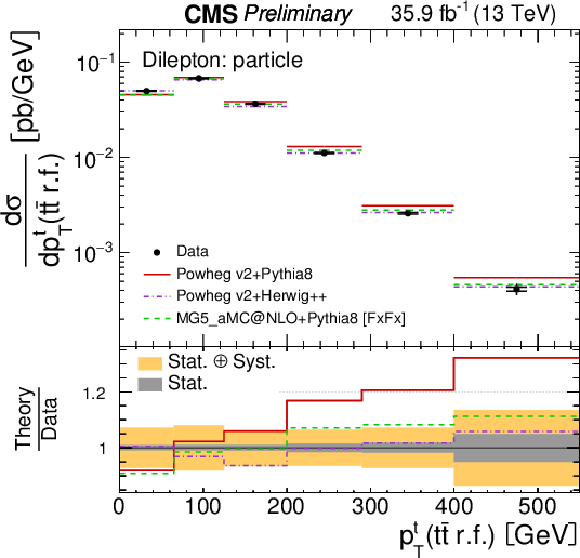
png pdf |
Figure 9-c:
The differential $ {\text {t}\bar{\text {t}}} $ production cross sections as a function of $ {p_{\mathrm {T}}} ^{\text {t}}$($ {\text {t}\bar{\text {t}}} $ r.f.) system are shown. The left and right columns correspond to absolute and normalised measurements, respectively. The upper row corresponds to measurements at parton level in the full phase space and the lower row to particle level in a fiducial phase space. The lower panel in each plot shows the ratio of the theoretical prediction to the data. |
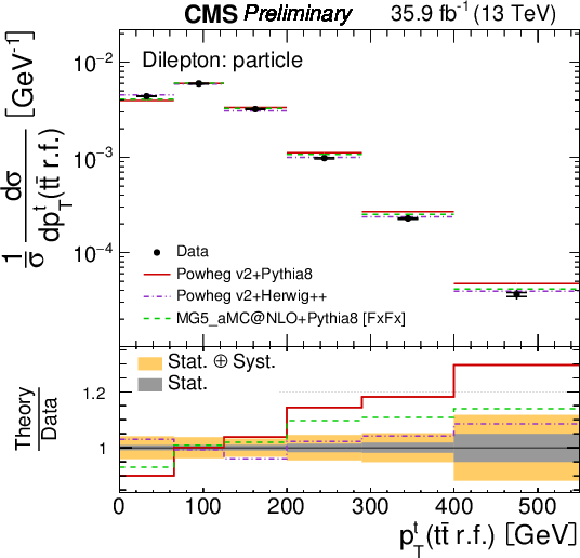
png pdf |
Figure 9-d:
The differential $ {\text {t}\bar{\text {t}}} $ production cross sections as a function of $ {p_{\mathrm {T}}} ^{\text {t}}$($ {\text {t}\bar{\text {t}}} $ r.f.) system are shown. The left and right columns correspond to absolute and normalised measurements, respectively. The upper row corresponds to measurements at parton level in the full phase space and the lower row to particle level in a fiducial phase space. The lower panel in each plot shows the ratio of the theoretical prediction to the data. |
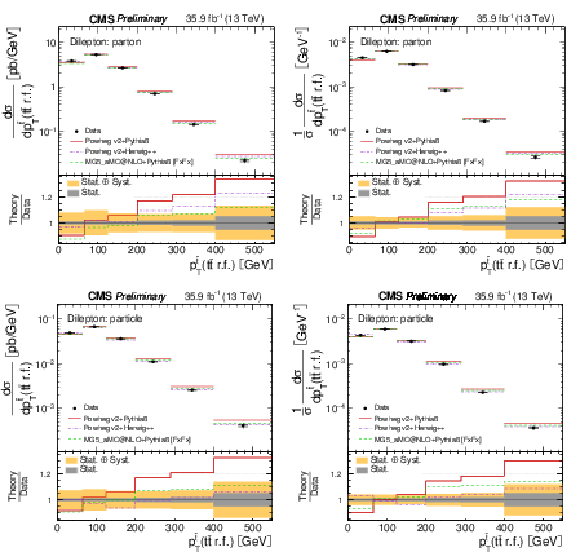
png pdf |
Figure 10:
The differential $ {\text {t}\bar{\text {t}}} $ production cross sections as a function of $ {p_{\mathrm {T}}} ^{{\bar{\text {t}}}}$($ {\text {t}\bar{\text {t}}} $ r.f.) are shown. The left and right columns correspond to absolute and normalised measurements, respectively. The upper row corresponds to measurements at parton level in the full phase space and the lower row to particle level in a fiducial phase space. The lower panel in each plot shows the ratio of the theoretical prediction to the data. |

png pdf |
Figure 10-a:
The differential $ {\text {t}\bar{\text {t}}} $ production cross sections as a function of $ {p_{\mathrm {T}}} ^{{\bar{\text {t}}}}$($ {\text {t}\bar{\text {t}}} $ r.f.) are shown. The left and right columns correspond to absolute and normalised measurements, respectively. The upper row corresponds to measurements at parton level in the full phase space and the lower row to particle level in a fiducial phase space. The lower panel in each plot shows the ratio of the theoretical prediction to the data. |
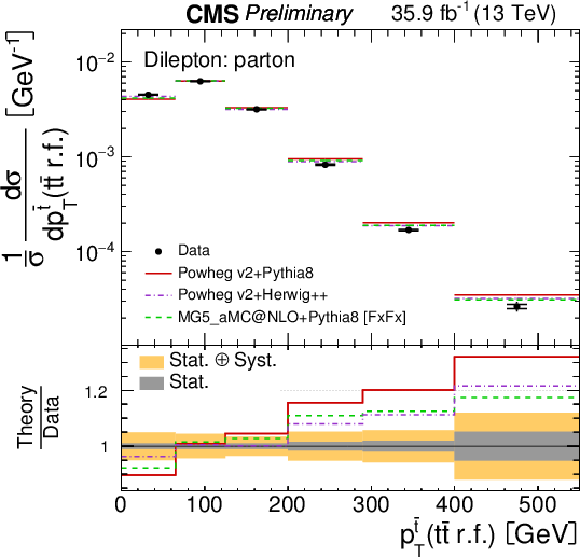
png pdf |
Figure 10-b:
The differential $ {\text {t}\bar{\text {t}}} $ production cross sections as a function of $ {p_{\mathrm {T}}} ^{{\bar{\text {t}}}}$($ {\text {t}\bar{\text {t}}} $ r.f.) are shown. The left and right columns correspond to absolute and normalised measurements, respectively. The upper row corresponds to measurements at parton level in the full phase space and the lower row to particle level in a fiducial phase space. The lower panel in each plot shows the ratio of the theoretical prediction to the data. |
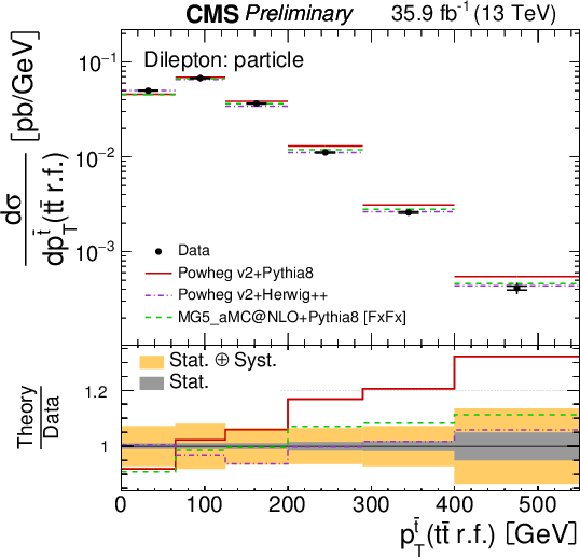
png pdf |
Figure 10-c:
The differential $ {\text {t}\bar{\text {t}}} $ production cross sections as a function of $ {p_{\mathrm {T}}} ^{{\bar{\text {t}}}}$($ {\text {t}\bar{\text {t}}} $ r.f.) are shown. The left and right columns correspond to absolute and normalised measurements, respectively. The upper row corresponds to measurements at parton level in the full phase space and the lower row to particle level in a fiducial phase space. The lower panel in each plot shows the ratio of the theoretical prediction to the data. |
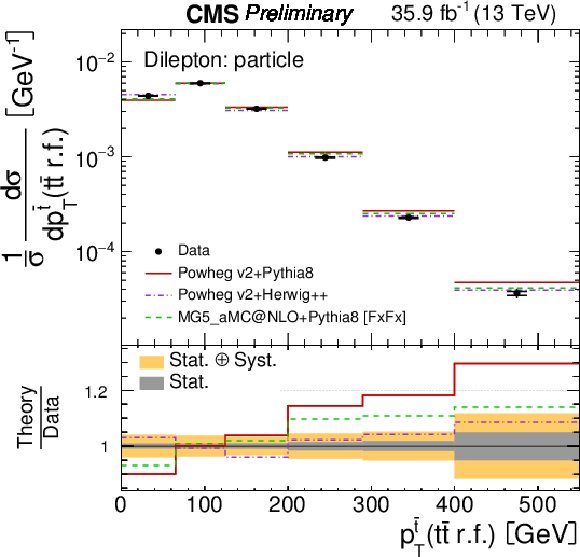
png pdf |
Figure 10-d:
The differential $ {\text {t}\bar{\text {t}}} $ production cross sections as a function of $ {p_{\mathrm {T}}} ^{{\bar{\text {t}}}}$($ {\text {t}\bar{\text {t}}} $ r.f.) are shown. The left and right columns correspond to absolute and normalised measurements, respectively. The upper row corresponds to measurements at parton level in the full phase space and the lower row to particle level in a fiducial phase space. The lower panel in each plot shows the ratio of the theoretical prediction to the data. |
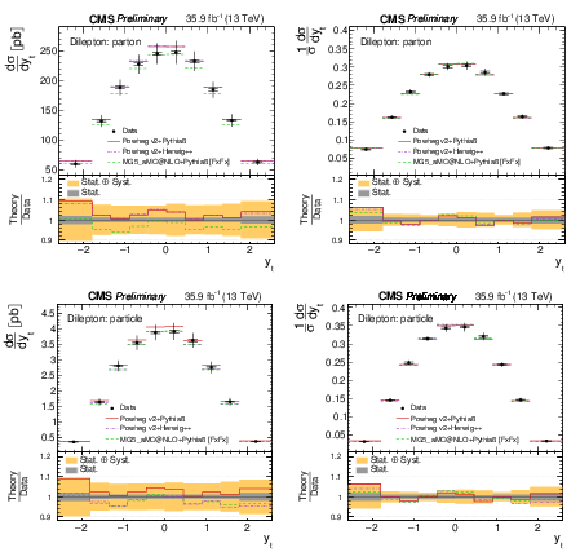
png pdf |
Figure 11:
The differential $ {\text {t}\bar{\text {t}}} $ production cross sections as a function of $y_{\text {t}}$ are shown. The left and right columns correspond to absolute and normalised measurements, respectively. The upper row corresponds to measurements at parton level in the full phase space and the lower row to particle level in a fiducial phase space. The lower panel in each plot shows the ratio of the theoretical prediction to the data. |
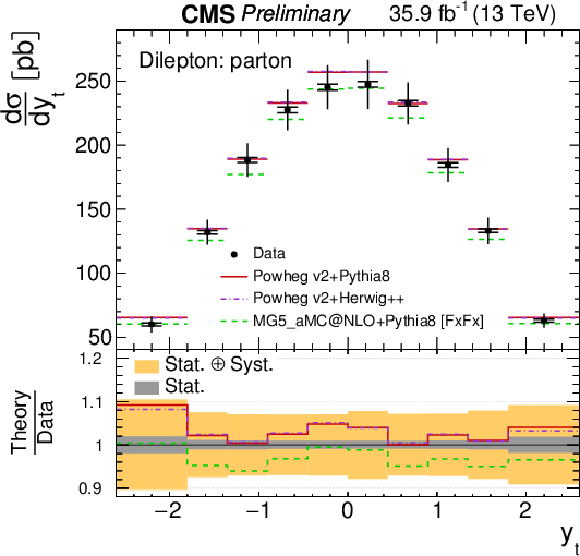
png pdf |
Figure 11-a:
The differential $ {\text {t}\bar{\text {t}}} $ production cross sections as a function of $y_{\text {t}}$ are shown. The left and right columns correspond to absolute and normalised measurements, respectively. The upper row corresponds to measurements at parton level in the full phase space and the lower row to particle level in a fiducial phase space. The lower panel in each plot shows the ratio of the theoretical prediction to the data. |

png pdf |
Figure 11-b:
The differential $ {\text {t}\bar{\text {t}}} $ production cross sections as a function of $y_{\text {t}}$ are shown. The left and right columns correspond to absolute and normalised measurements, respectively. The upper row corresponds to measurements at parton level in the full phase space and the lower row to particle level in a fiducial phase space. The lower panel in each plot shows the ratio of the theoretical prediction to the data. |
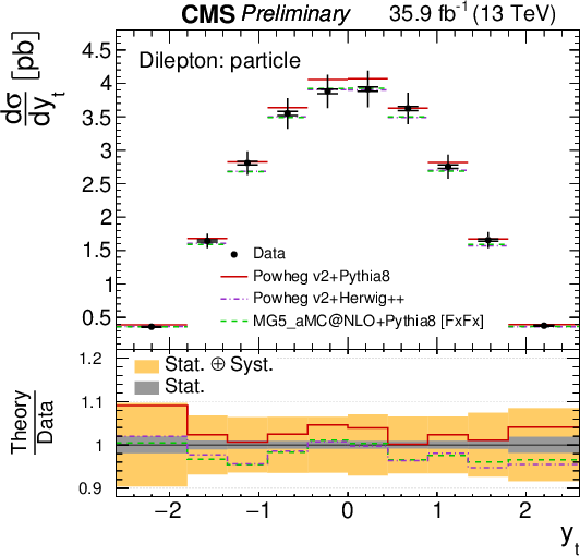
png pdf |
Figure 11-c:
The differential $ {\text {t}\bar{\text {t}}} $ production cross sections as a function of $y_{\text {t}}$ are shown. The left and right columns correspond to absolute and normalised measurements, respectively. The upper row corresponds to measurements at parton level in the full phase space and the lower row to particle level in a fiducial phase space. The lower panel in each plot shows the ratio of the theoretical prediction to the data. |
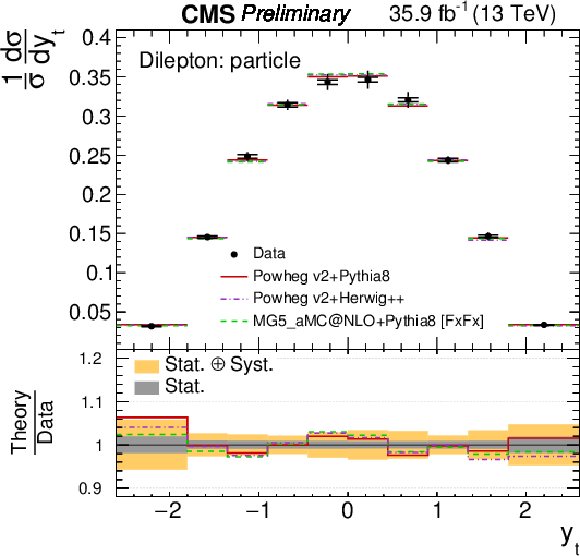
png pdf |
Figure 11-d:
The differential $ {\text {t}\bar{\text {t}}} $ production cross sections as a function of $y_{\text {t}}$ are shown. The left and right columns correspond to absolute and normalised measurements, respectively. The upper row corresponds to measurements at parton level in the full phase space and the lower row to particle level in a fiducial phase space. The lower panel in each plot shows the ratio of the theoretical prediction to the data. |
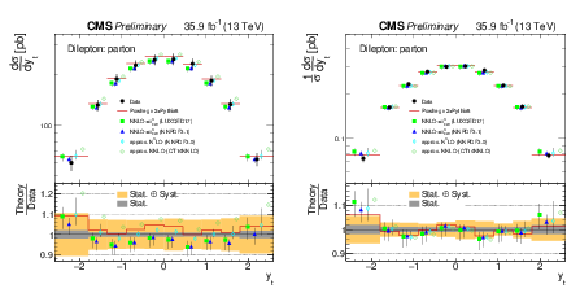
png pdf |
Figure 12:
The differential $ {\text {t}\bar{\text {t}}} $ production cross sections at parton level in full phase space as a function of $y_{\text {t}}$ are compared to theoretical predictions with beyond NLO precision. The left and right plots correspond to absolute and normalised measurements, respectively. The lower panel in each plot shows the ratio of the theoretical prediction to the data. |

png pdf |
Figure 12-a:
The differential $ {\text {t}\bar{\text {t}}} $ production cross sections at parton level in full phase space as a function of $y_{\text {t}}$ are compared to theoretical predictions with beyond NLO precision. The left and right plots correspond to absolute and normalised measurements, respectively. The lower panel in each plot shows the ratio of the theoretical prediction to the data. |

png pdf |
Figure 12-b:
The differential $ {\text {t}\bar{\text {t}}} $ production cross sections at parton level in full phase space as a function of $y_{\text {t}}$ are compared to theoretical predictions with beyond NLO precision. The left and right plots correspond to absolute and normalised measurements, respectively. The lower panel in each plot shows the ratio of the theoretical prediction to the data. |
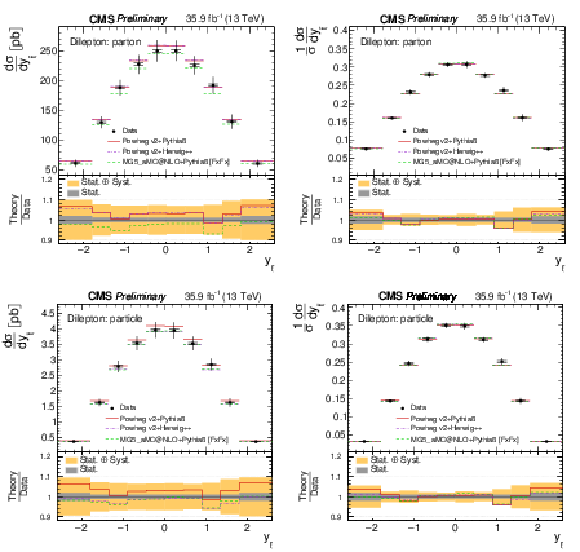
png pdf |
Figure 13:
The differential $ {\text {t}\bar{\text {t}}} $ production cross sections as a function of $y_{{\bar{\text {t}}}}$ are shown. The left and right columns correspond to absolute and normalised measurements, respectively. The upper row corresponds to measurements at parton level in the full phase space and the lower row to particle level in a fiducial phase space. The lower panel in each plot shows the ratio of the theoretical prediction to the data. |
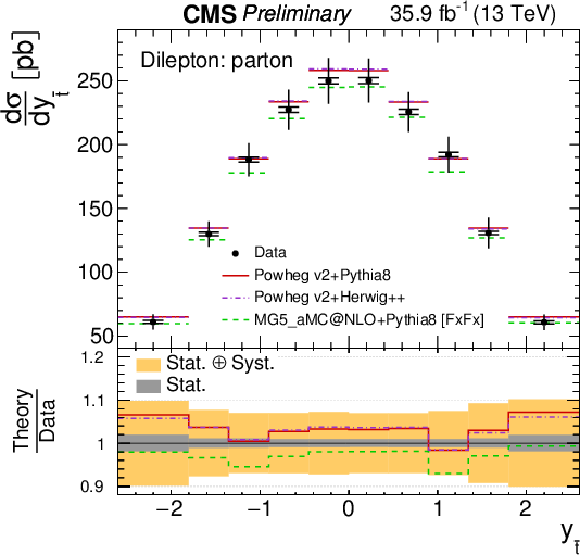
png pdf |
Figure 13-a:
The differential $ {\text {t}\bar{\text {t}}} $ production cross sections as a function of $y_{{\bar{\text {t}}}}$ are shown. The left and right columns correspond to absolute and normalised measurements, respectively. The upper row corresponds to measurements at parton level in the full phase space and the lower row to particle level in a fiducial phase space. The lower panel in each plot shows the ratio of the theoretical prediction to the data. |
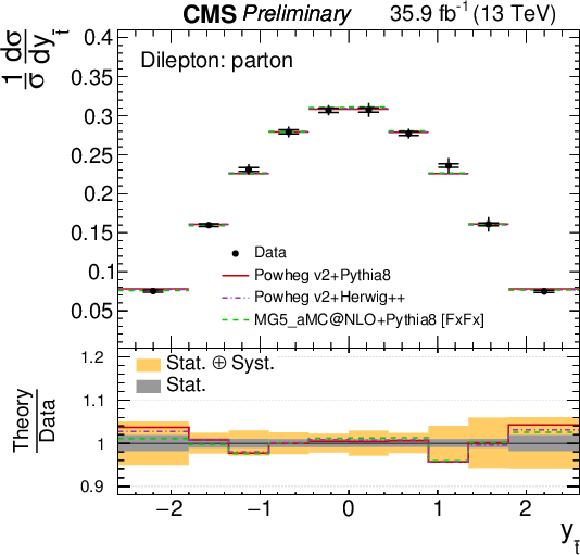
png pdf |
Figure 13-b:
The differential $ {\text {t}\bar{\text {t}}} $ production cross sections as a function of $y_{{\bar{\text {t}}}}$ are shown. The left and right columns correspond to absolute and normalised measurements, respectively. The upper row corresponds to measurements at parton level in the full phase space and the lower row to particle level in a fiducial phase space. The lower panel in each plot shows the ratio of the theoretical prediction to the data. |
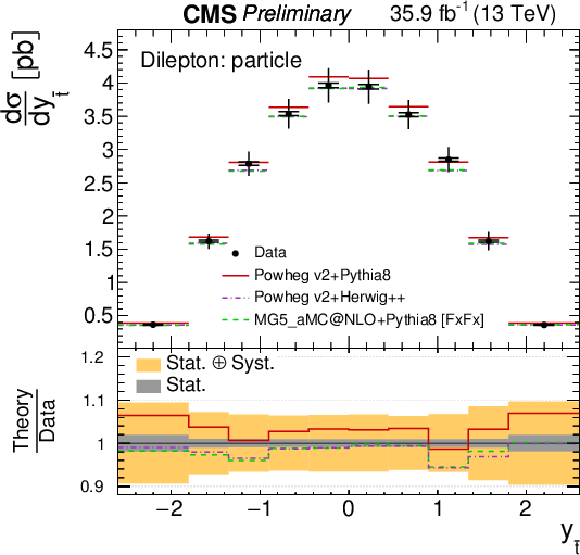
png pdf |
Figure 13-c:
The differential $ {\text {t}\bar{\text {t}}} $ production cross sections as a function of $y_{{\bar{\text {t}}}}$ are shown. The left and right columns correspond to absolute and normalised measurements, respectively. The upper row corresponds to measurements at parton level in the full phase space and the lower row to particle level in a fiducial phase space. The lower panel in each plot shows the ratio of the theoretical prediction to the data. |
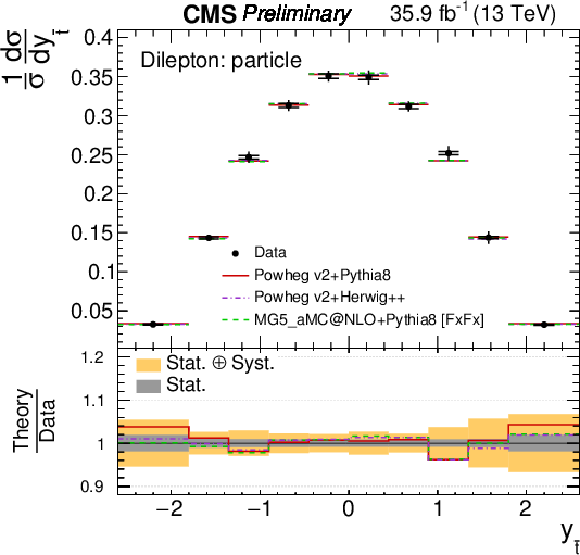
png pdf |
Figure 13-d:
The differential $ {\text {t}\bar{\text {t}}} $ production cross sections as a function of $y_{{\bar{\text {t}}}}$ are shown. The left and right columns correspond to absolute and normalised measurements, respectively. The upper row corresponds to measurements at parton level in the full phase space and the lower row to particle level in a fiducial phase space. The lower panel in each plot shows the ratio of the theoretical prediction to the data. |

png pdf |
Figure 14:
The differential $ {\text {t}\bar{\text {t}}} $ production cross sections at parton level in full phase space as a function of $y_{{\bar{\text {t}}}}$ are compared to theoretical predictions with beyond NLO precision. The left and right plots correspond to absolute and normalised measurements, respectively. The lower panel in each plot shows the ratio of the theoretical prediction to the data. |
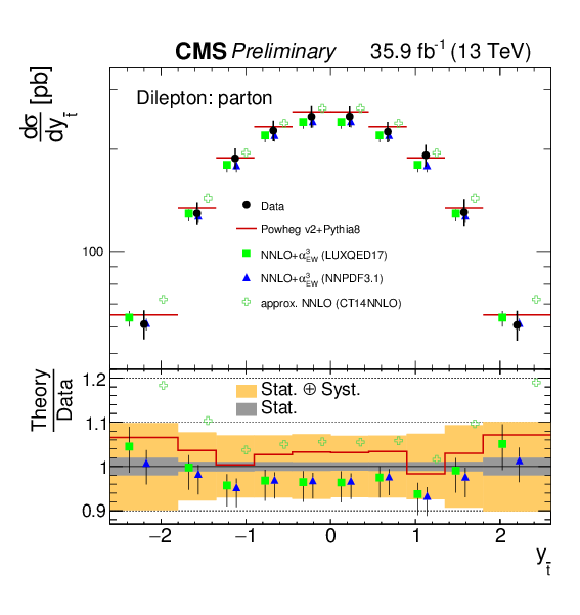
png pdf |
Figure 14-a:
The differential $ {\text {t}\bar{\text {t}}} $ production cross sections at parton level in full phase space as a function of $y_{{\bar{\text {t}}}}$ are compared to theoretical predictions with beyond NLO precision. The left and right plots correspond to absolute and normalised measurements, respectively. The lower panel in each plot shows the ratio of the theoretical prediction to the data. |

png pdf |
Figure 14-b:
The differential $ {\text {t}\bar{\text {t}}} $ production cross sections at parton level in full phase space as a function of $y_{{\bar{\text {t}}}}$ are compared to theoretical predictions with beyond NLO precision. The left and right plots correspond to absolute and normalised measurements, respectively. The lower panel in each plot shows the ratio of the theoretical prediction to the data. |
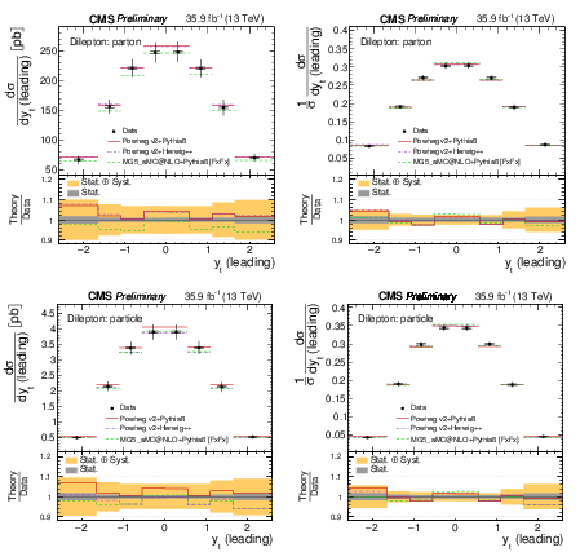
png pdf |
Figure 15:
The differential $ {\text {t}\bar{\text {t}}} $ production cross sections as a function of $y_{\text {t}}$ (leading) are shown. The left and right columns correspond to absolute and normalised measurements, respectively. The upper row corresponds to measurements at parton level in the full phase space and the lower row to particle level in a fiducial phase space. The lower panel in each plot shows the ratio of the theoretical prediction to the data. |
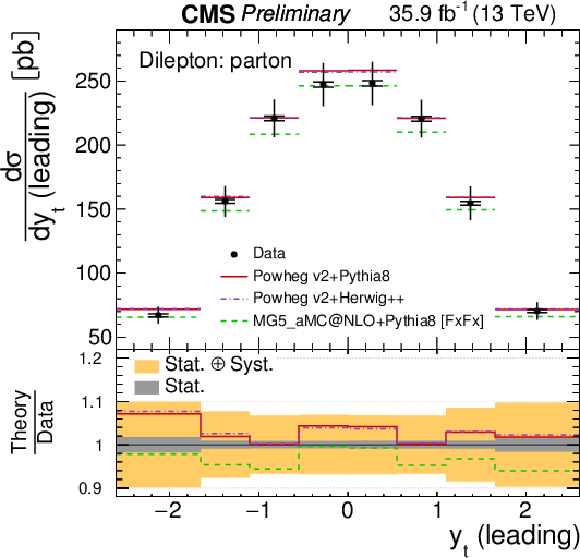
png pdf |
Figure 15-a:
The differential $ {\text {t}\bar{\text {t}}} $ production cross sections as a function of $y_{\text {t}}$ (leading) are shown. The left and right columns correspond to absolute and normalised measurements, respectively. The upper row corresponds to measurements at parton level in the full phase space and the lower row to particle level in a fiducial phase space. The lower panel in each plot shows the ratio of the theoretical prediction to the data. |
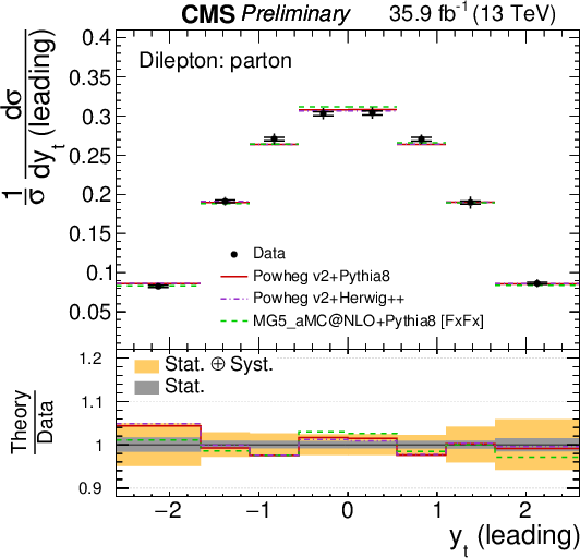
png pdf |
Figure 15-b:
The differential $ {\text {t}\bar{\text {t}}} $ production cross sections as a function of $y_{\text {t}}$ (leading) are shown. The left and right columns correspond to absolute and normalised measurements, respectively. The upper row corresponds to measurements at parton level in the full phase space and the lower row to particle level in a fiducial phase space. The lower panel in each plot shows the ratio of the theoretical prediction to the data. |
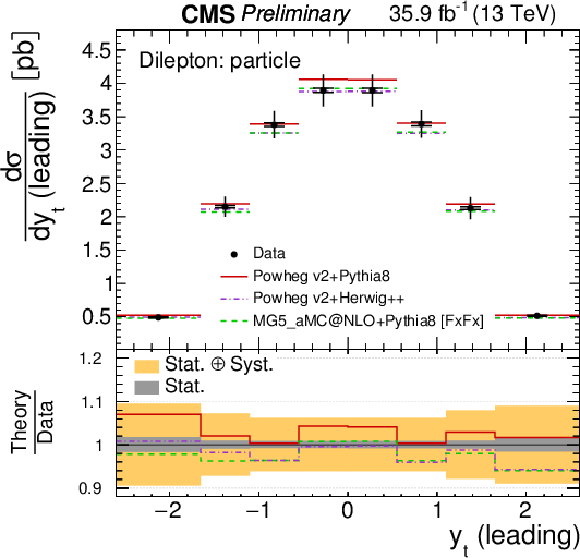
png pdf |
Figure 15-c:
The differential $ {\text {t}\bar{\text {t}}} $ production cross sections as a function of $y_{\text {t}}$ (leading) are shown. The left and right columns correspond to absolute and normalised measurements, respectively. The upper row corresponds to measurements at parton level in the full phase space and the lower row to particle level in a fiducial phase space. The lower panel in each plot shows the ratio of the theoretical prediction to the data. |

png pdf |
Figure 15-d:
The differential $ {\text {t}\bar{\text {t}}} $ production cross sections as a function of $y_{\text {t}}$ (leading) are shown. The left and right columns correspond to absolute and normalised measurements, respectively. The upper row corresponds to measurements at parton level in the full phase space and the lower row to particle level in a fiducial phase space. The lower panel in each plot shows the ratio of the theoretical prediction to the data. |
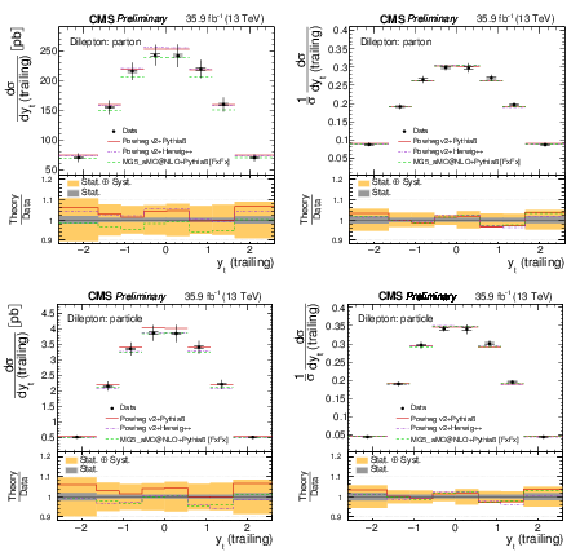
png pdf |
Figure 16:
The differential $ {\text {t}\bar{\text {t}}} $ production cross sections at parton level in full phase space as a function of $y_{\text {t}}$ (trailing) are shown. The left and right columns correspond to absolute and normalised measurements, respectively. The upper row corresponds to measurements at parton level in the full phase space and the lower row to particle level in a fiducial phase space. The lower panel in each plot shows the ratio of the theoretical prediction to the data. |

png pdf |
Figure 16-a:
The differential $ {\text {t}\bar{\text {t}}} $ production cross sections at parton level in full phase space as a function of $y_{\text {t}}$ (trailing) are shown. The left and right columns correspond to absolute and normalised measurements, respectively. The upper row corresponds to measurements at parton level in the full phase space and the lower row to particle level in a fiducial phase space. The lower panel in each plot shows the ratio of the theoretical prediction to the data. |
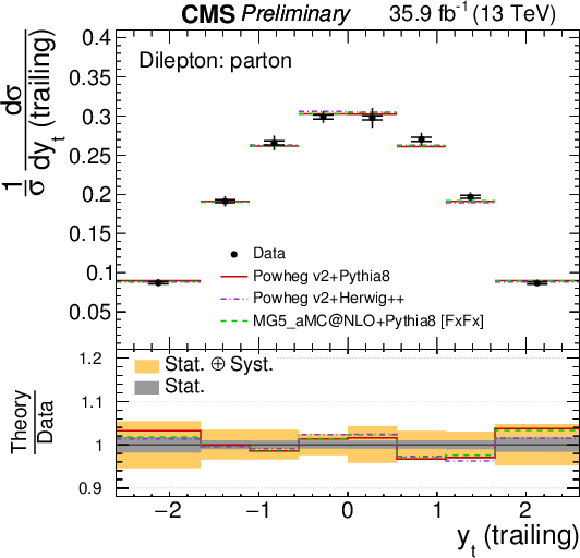
png pdf |
Figure 16-b:
The differential $ {\text {t}\bar{\text {t}}} $ production cross sections at parton level in full phase space as a function of $y_{\text {t}}$ (trailing) are shown. The left and right columns correspond to absolute and normalised measurements, respectively. The upper row corresponds to measurements at parton level in the full phase space and the lower row to particle level in a fiducial phase space. The lower panel in each plot shows the ratio of the theoretical prediction to the data. |
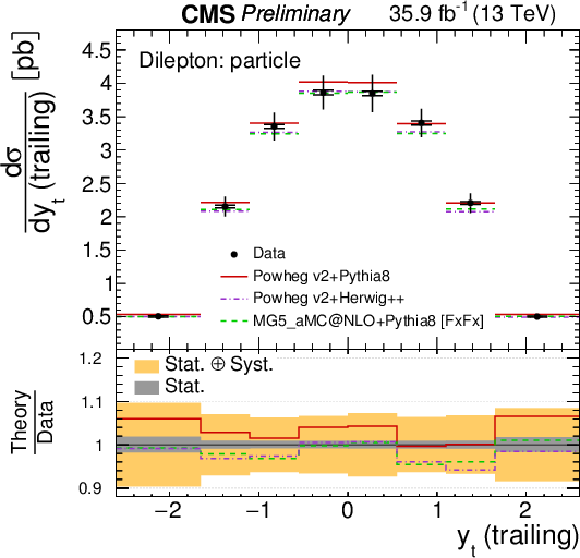
png pdf |
Figure 16-c:
The differential $ {\text {t}\bar{\text {t}}} $ production cross sections at parton level in full phase space as a function of $y_{\text {t}}$ (trailing) are shown. The left and right columns correspond to absolute and normalised measurements, respectively. The upper row corresponds to measurements at parton level in the full phase space and the lower row to particle level in a fiducial phase space. The lower panel in each plot shows the ratio of the theoretical prediction to the data. |
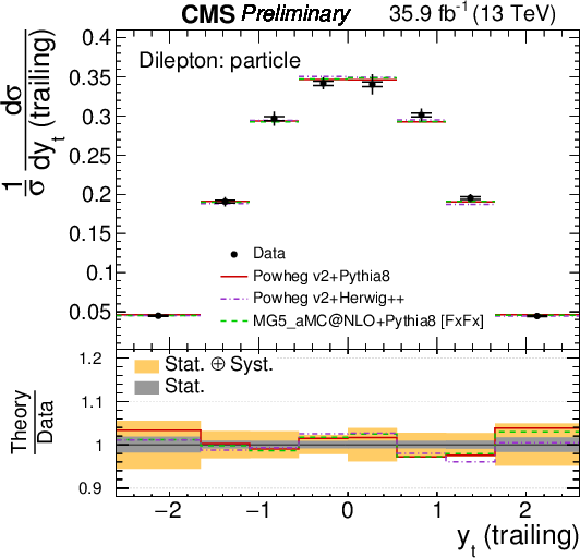
png pdf |
Figure 16-d:
The differential $ {\text {t}\bar{\text {t}}} $ production cross sections at parton level in full phase space as a function of $y_{\text {t}}$ (trailing) are shown. The left and right columns correspond to absolute and normalised measurements, respectively. The upper row corresponds to measurements at parton level in the full phase space and the lower row to particle level in a fiducial phase space. The lower panel in each plot shows the ratio of the theoretical prediction to the data. |
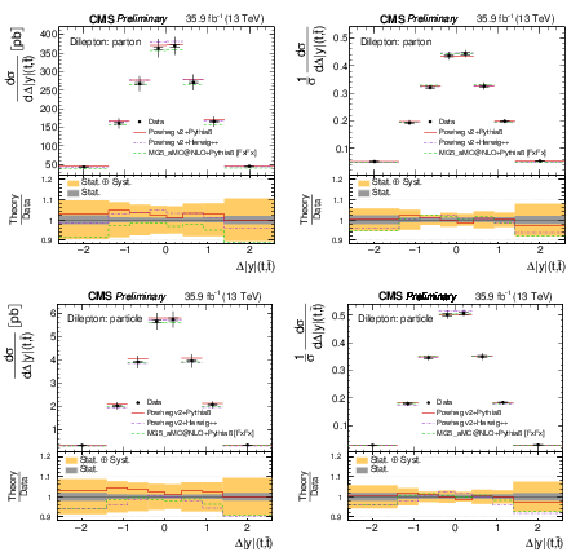
png pdf |
Figure 17:
The differential $ {\text {t}\bar{\text {t}}} $ production cross sections as a function of $\Delta |y|$(t, $ {\bar{\text {t}}} $) are shown. The left and right columns correspond to absolute and normalised measurements, respectively. The upper row corresponds to measurements at parton level in the full phase space and the lower row to particle level in a fiducial phase space. The lower panel in each plot shows the ratio of the theoretical prediction to the data. |
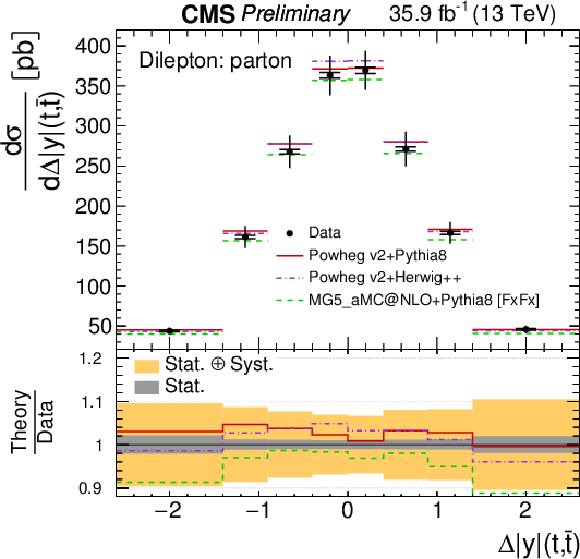
png pdf |
Figure 17-a:
The differential $ {\text {t}\bar{\text {t}}} $ production cross sections as a function of $\Delta |y|$(t, $ {\bar{\text {t}}} $) are shown. The left and right columns correspond to absolute and normalised measurements, respectively. The upper row corresponds to measurements at parton level in the full phase space and the lower row to particle level in a fiducial phase space. The lower panel in each plot shows the ratio of the theoretical prediction to the data. |
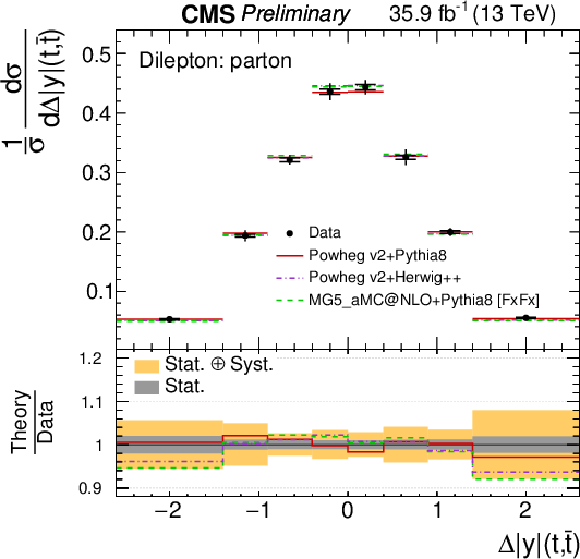
png pdf |
Figure 17-b:
The differential $ {\text {t}\bar{\text {t}}} $ production cross sections as a function of $\Delta |y|$(t, $ {\bar{\text {t}}} $) are shown. The left and right columns correspond to absolute and normalised measurements, respectively. The upper row corresponds to measurements at parton level in the full phase space and the lower row to particle level in a fiducial phase space. The lower panel in each plot shows the ratio of the theoretical prediction to the data. |
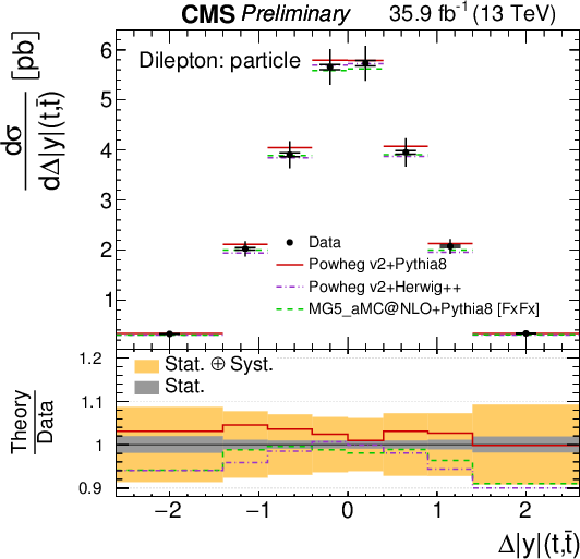
png pdf |
Figure 17-c:
The differential $ {\text {t}\bar{\text {t}}} $ production cross sections as a function of $\Delta |y|$(t, $ {\bar{\text {t}}} $) are shown. The left and right columns correspond to absolute and normalised measurements, respectively. The upper row corresponds to measurements at parton level in the full phase space and the lower row to particle level in a fiducial phase space. The lower panel in each plot shows the ratio of the theoretical prediction to the data. |
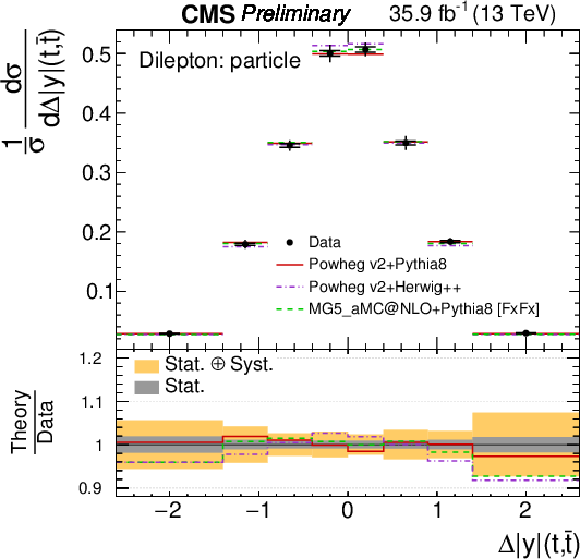
png pdf |
Figure 17-d:
The differential $ {\text {t}\bar{\text {t}}} $ production cross sections as a function of $\Delta |y|$(t, $ {\bar{\text {t}}} $) are shown. The left and right columns correspond to absolute and normalised measurements, respectively. The upper row corresponds to measurements at parton level in the full phase space and the lower row to particle level in a fiducial phase space. The lower panel in each plot shows the ratio of the theoretical prediction to the data. |
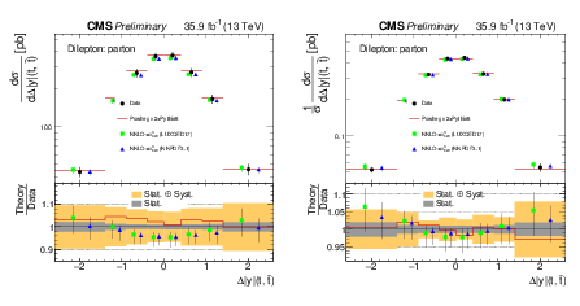
png pdf |
Figure 18:
The differential $ {\text {t}\bar{\text {t}}} $ production cross sections at parton level in full phase space as a function of $\Delta |y|$(t, $ {\bar{\text {t}}} $) are compared to theoretical predictions with beyond NLO precision. The left and right plots correspond to absolute and normalised measurements, respectively. The lower panel in each plot shows the ratio of the theoretical prediction to the data. |
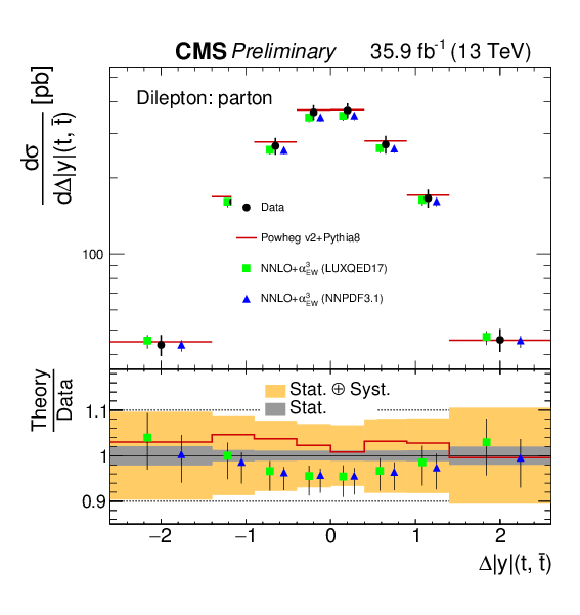
png pdf |
Figure 18-a:
The differential $ {\text {t}\bar{\text {t}}} $ production cross sections at parton level in full phase space as a function of $\Delta |y|$(t, $ {\bar{\text {t}}} $) are compared to theoretical predictions with beyond NLO precision. The left and right plots correspond to absolute and normalised measurements, respectively. The lower panel in each plot shows the ratio of the theoretical prediction to the data. |
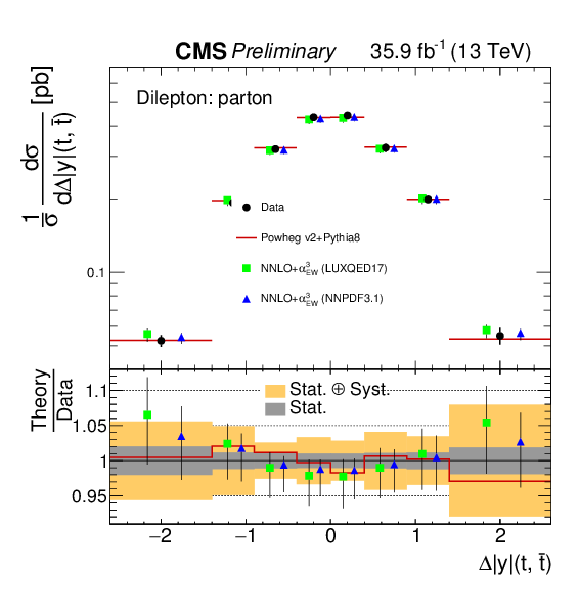
png pdf |
Figure 18-b:
The differential $ {\text {t}\bar{\text {t}}} $ production cross sections at parton level in full phase space as a function of $\Delta |y|$(t, $ {\bar{\text {t}}} $) are compared to theoretical predictions with beyond NLO precision. The left and right plots correspond to absolute and normalised measurements, respectively. The lower panel in each plot shows the ratio of the theoretical prediction to the data. |
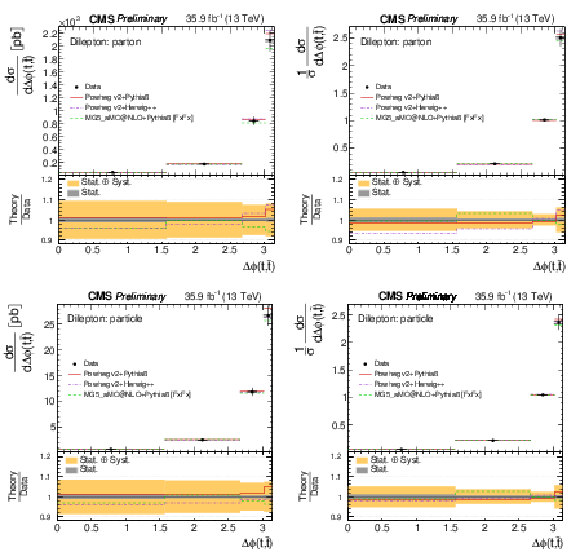
png pdf |
Figure 19:
The differential $ {\text {t}\bar{\text {t}}} $ production cross sections as a function of $\Delta \phi $(t, $ {\bar{\text {t}}} $) are shown. The left and right columns correspond to absolute and normalised measurements, respectively. The upper row corresponds to measurements at parton level in the full phase space and the lower row to particle level in a fiducial phase space. The lower panel in each plot shows the ratio of the theoretical prediction to the data. |
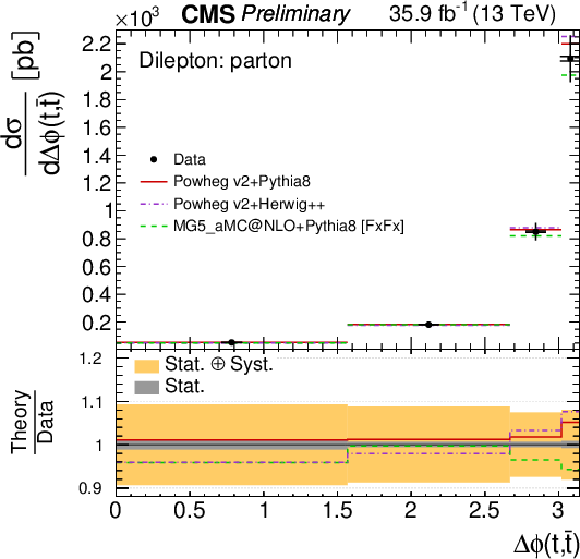
png pdf |
Figure 19-a:
The differential $ {\text {t}\bar{\text {t}}} $ production cross sections as a function of $\Delta \phi $(t, $ {\bar{\text {t}}} $) are shown. The left and right columns correspond to absolute and normalised measurements, respectively. The upper row corresponds to measurements at parton level in the full phase space and the lower row to particle level in a fiducial phase space. The lower panel in each plot shows the ratio of the theoretical prediction to the data. |
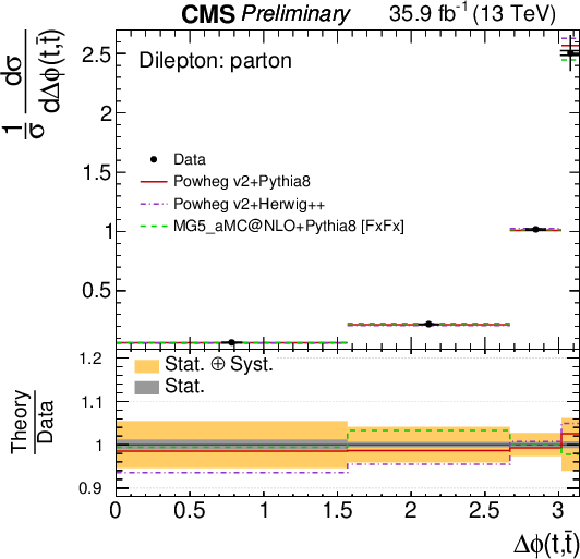
png pdf |
Figure 19-b:
The differential $ {\text {t}\bar{\text {t}}} $ production cross sections as a function of $\Delta \phi $(t, $ {\bar{\text {t}}} $) are shown. The left and right columns correspond to absolute and normalised measurements, respectively. The upper row corresponds to measurements at parton level in the full phase space and the lower row to particle level in a fiducial phase space. The lower panel in each plot shows the ratio of the theoretical prediction to the data. |
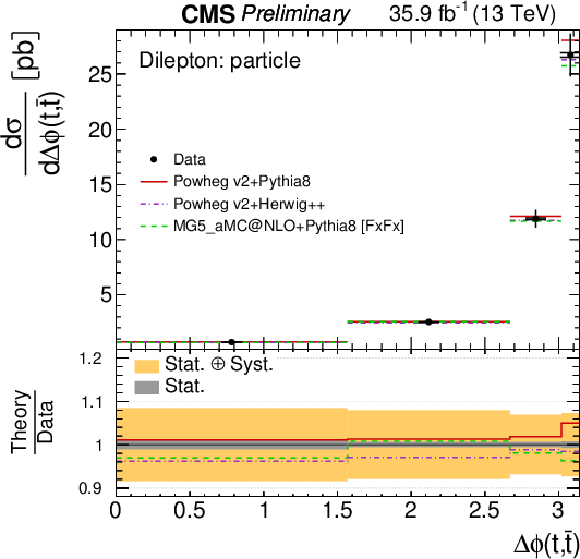
png pdf |
Figure 19-c:
The differential $ {\text {t}\bar{\text {t}}} $ production cross sections as a function of $\Delta \phi $(t, $ {\bar{\text {t}}} $) are shown. The left and right columns correspond to absolute and normalised measurements, respectively. The upper row corresponds to measurements at parton level in the full phase space and the lower row to particle level in a fiducial phase space. The lower panel in each plot shows the ratio of the theoretical prediction to the data. |
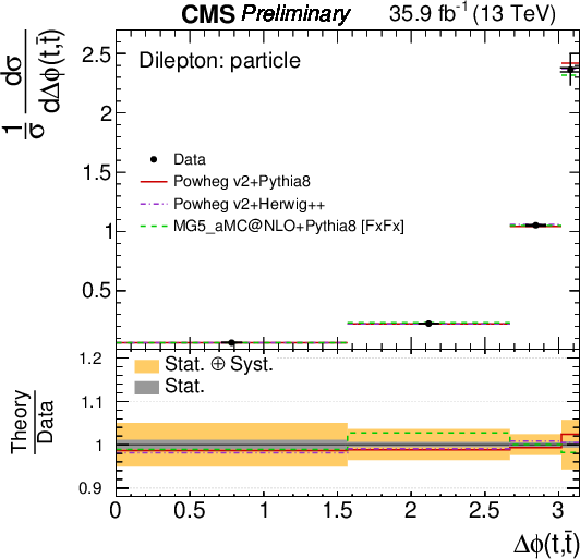
png pdf |
Figure 19-d:
The differential $ {\text {t}\bar{\text {t}}} $ production cross sections as a function of $\Delta \phi $(t, $ {\bar{\text {t}}} $) are shown. The left and right columns correspond to absolute and normalised measurements, respectively. The upper row corresponds to measurements at parton level in the full phase space and the lower row to particle level in a fiducial phase space. The lower panel in each plot shows the ratio of the theoretical prediction to the data. |
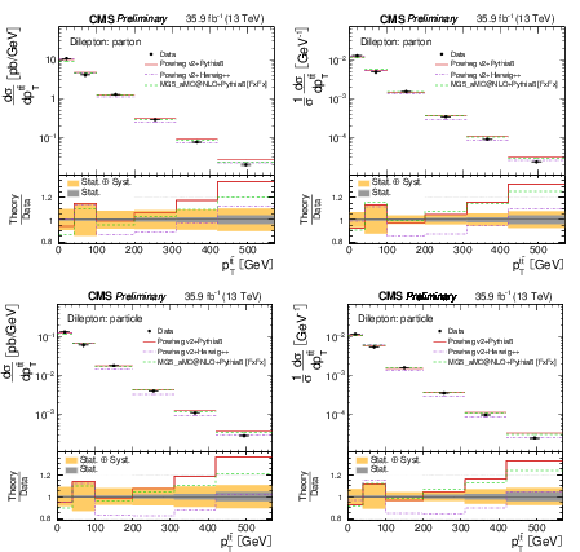
png pdf |
Figure 20:
The differential $ {\text {t}\bar{\text {t}}} $ production cross sections as a function of $ {p_{\mathrm {T}}} ^{{\text {t}\bar{\text {t}}}}$ are shown. The left and right columns correspond to absolute and normalised measurements, respectively. The upper row corresponds to measurements at parton level in the full phase space and the lower row to particle level in a fiducial phase space. The lower panel in each plot shows the ratio of the theoretical prediction to the data. |

png pdf |
Figure 20-a:
The differential $ {\text {t}\bar{\text {t}}} $ production cross sections as a function of $ {p_{\mathrm {T}}} ^{{\text {t}\bar{\text {t}}}}$ are shown. The left and right columns correspond to absolute and normalised measurements, respectively. The upper row corresponds to measurements at parton level in the full phase space and the lower row to particle level in a fiducial phase space. The lower panel in each plot shows the ratio of the theoretical prediction to the data. |
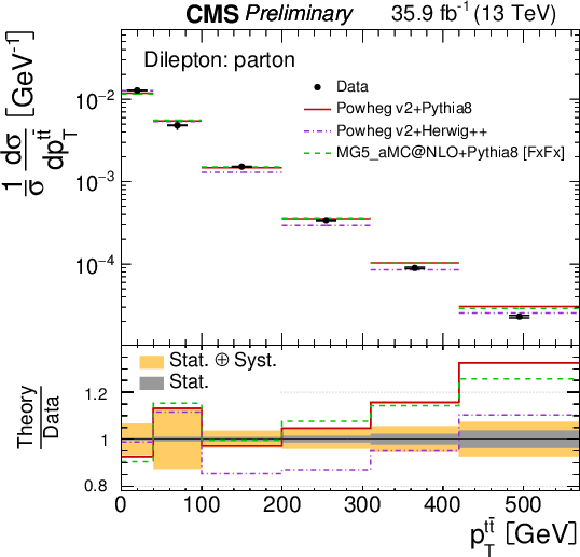
png pdf |
Figure 20-b:
The differential $ {\text {t}\bar{\text {t}}} $ production cross sections as a function of $ {p_{\mathrm {T}}} ^{{\text {t}\bar{\text {t}}}}$ are shown. The left and right columns correspond to absolute and normalised measurements, respectively. The upper row corresponds to measurements at parton level in the full phase space and the lower row to particle level in a fiducial phase space. The lower panel in each plot shows the ratio of the theoretical prediction to the data. |

png pdf |
Figure 20-c:
The differential $ {\text {t}\bar{\text {t}}} $ production cross sections as a function of $ {p_{\mathrm {T}}} ^{{\text {t}\bar{\text {t}}}}$ are shown. The left and right columns correspond to absolute and normalised measurements, respectively. The upper row corresponds to measurements at parton level in the full phase space and the lower row to particle level in a fiducial phase space. The lower panel in each plot shows the ratio of the theoretical prediction to the data. |
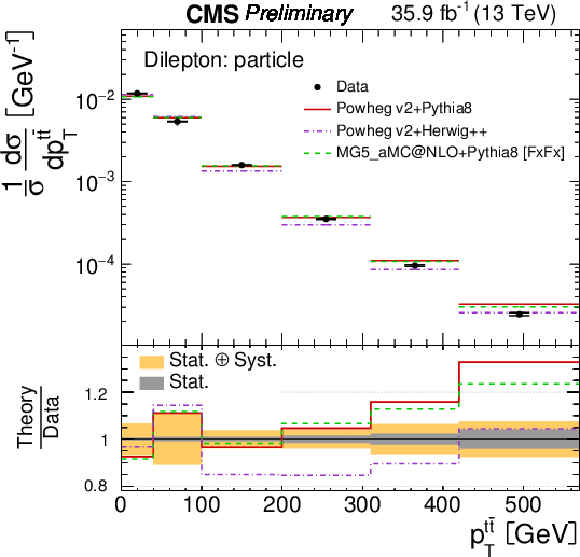
png pdf |
Figure 20-d:
The differential $ {\text {t}\bar{\text {t}}} $ production cross sections as a function of $ {p_{\mathrm {T}}} ^{{\text {t}\bar{\text {t}}}}$ are shown. The left and right columns correspond to absolute and normalised measurements, respectively. The upper row corresponds to measurements at parton level in the full phase space and the lower row to particle level in a fiducial phase space. The lower panel in each plot shows the ratio of the theoretical prediction to the data. |
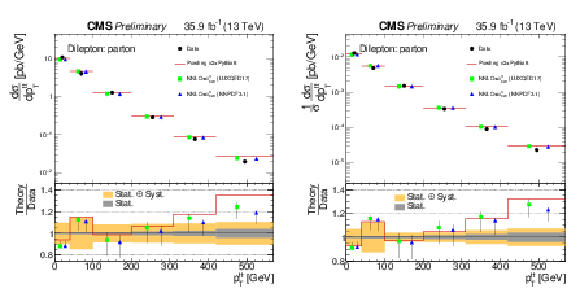
png pdf |
Figure 21:
The differential $ {\text {t}\bar{\text {t}}} $ production cross sections at parton level in full phase space as a function of $ {p_{\mathrm {T}}} ^{{\text {t}\bar{\text {t}}}}$ are compared to theoretical predictions with beyond NLO precision. The left and right plots correspond to absolute and normalised measurements, respectively. The lower panel in each plot shows the ratio of the theoretical prediction to the data. |
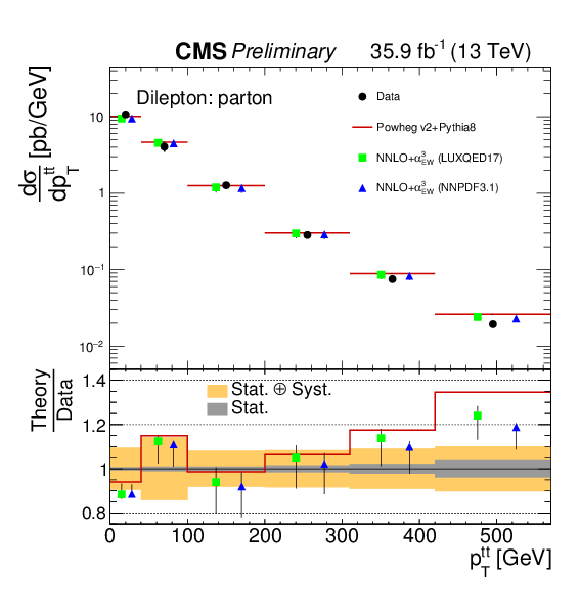
png pdf |
Figure 21-a:
The differential $ {\text {t}\bar{\text {t}}} $ production cross sections at parton level in full phase space as a function of $ {p_{\mathrm {T}}} ^{{\text {t}\bar{\text {t}}}}$ are compared to theoretical predictions with beyond NLO precision. The left and right plots correspond to absolute and normalised measurements, respectively. The lower panel in each plot shows the ratio of the theoretical prediction to the data. |
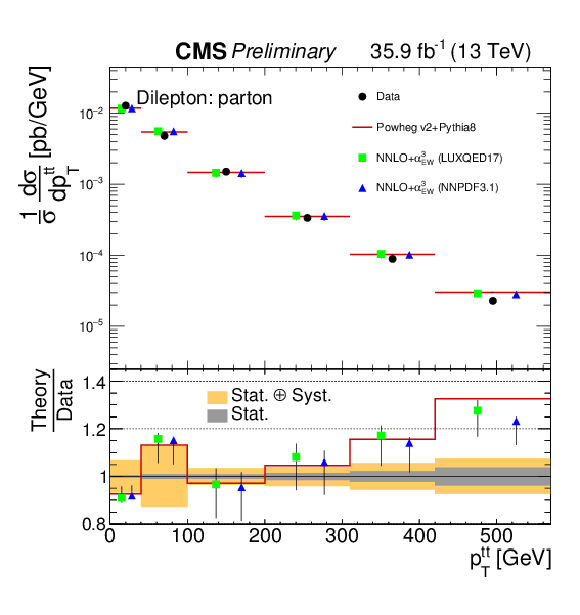
png pdf |
Figure 21-b:
The differential $ {\text {t}\bar{\text {t}}} $ production cross sections at parton level in full phase space as a function of $ {p_{\mathrm {T}}} ^{{\text {t}\bar{\text {t}}}}$ are compared to theoretical predictions with beyond NLO precision. The left and right plots correspond to absolute and normalised measurements, respectively. The lower panel in each plot shows the ratio of the theoretical prediction to the data. |

png pdf |
Figure 22:
The differential $ {\text {t}\bar{\text {t}}} $ production cross sections as a function of $y_{{\text {t}\bar{\text {t}}}}$ are shown. The left and right columns correspond to absolute and normalised measurements, respectively. The upper row corresponds to measurements at parton level in the full phase space and the lower row to particle level in a fiducial phase space. The lower panel in each plot shows the ratio of the theoretical prediction to the data. |
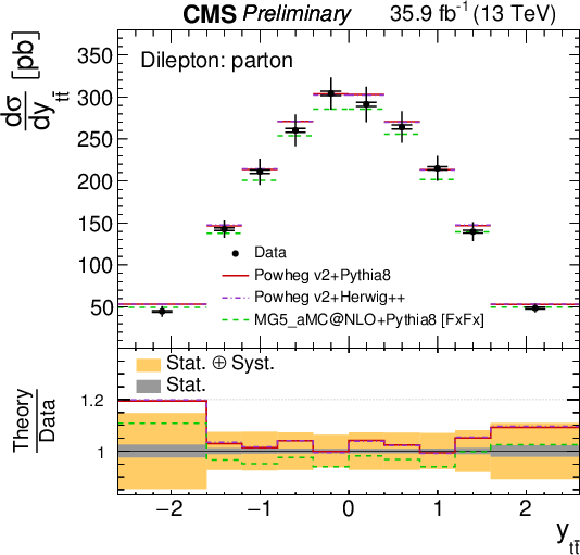
png pdf |
Figure 22-a:
The differential $ {\text {t}\bar{\text {t}}} $ production cross sections as a function of $y_{{\text {t}\bar{\text {t}}}}$ are shown. The left and right columns correspond to absolute and normalised measurements, respectively. The upper row corresponds to measurements at parton level in the full phase space and the lower row to particle level in a fiducial phase space. The lower panel in each plot shows the ratio of the theoretical prediction to the data. |

png pdf |
Figure 22-b:
The differential $ {\text {t}\bar{\text {t}}} $ production cross sections as a function of $y_{{\text {t}\bar{\text {t}}}}$ are shown. The left and right columns correspond to absolute and normalised measurements, respectively. The upper row corresponds to measurements at parton level in the full phase space and the lower row to particle level in a fiducial phase space. The lower panel in each plot shows the ratio of the theoretical prediction to the data. |

png pdf |
Figure 22-c:
The differential $ {\text {t}\bar{\text {t}}} $ production cross sections as a function of $y_{{\text {t}\bar{\text {t}}}}$ are shown. The left and right columns correspond to absolute and normalised measurements, respectively. The upper row corresponds to measurements at parton level in the full phase space and the lower row to particle level in a fiducial phase space. The lower panel in each plot shows the ratio of the theoretical prediction to the data. |
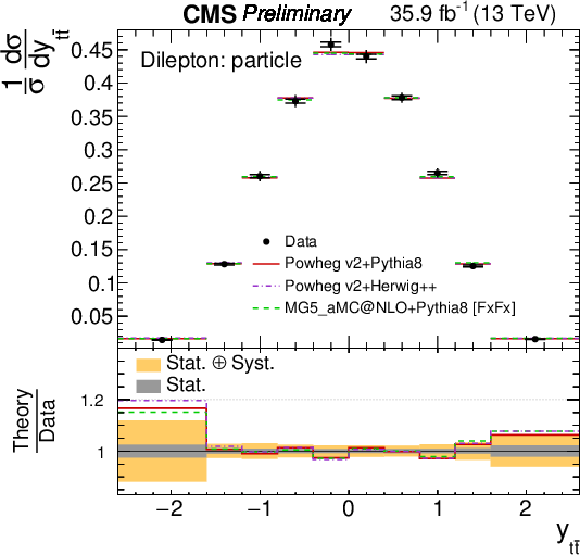
png pdf |
Figure 22-d:
The differential $ {\text {t}\bar{\text {t}}} $ production cross sections as a function of $y_{{\text {t}\bar{\text {t}}}}$ are shown. The left and right columns correspond to absolute and normalised measurements, respectively. The upper row corresponds to measurements at parton level in the full phase space and the lower row to particle level in a fiducial phase space. The lower panel in each plot shows the ratio of the theoretical prediction to the data. |
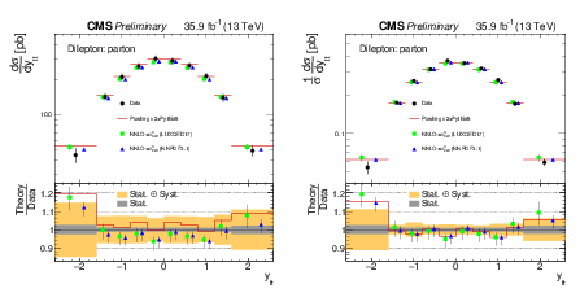
png pdf |
Figure 23:
The differential $ {\text {t}\bar{\text {t}}} $ production cross sections at parton level in full phase space as a function of $y^{{\text {t}\bar{\text {t}}}}$ are compared to theoretical predictions with beyond NLO precision. The left and right plots correspond to absolute and normalised measurements, respectively. The lower panel in each plot shows the ratio of the theoretical prediction to the data. |

png pdf |
Figure 23-a:
The differential $ {\text {t}\bar{\text {t}}} $ production cross sections at parton level in full phase space as a function of $y^{{\text {t}\bar{\text {t}}}}$ are compared to theoretical predictions with beyond NLO precision. The left and right plots correspond to absolute and normalised measurements, respectively. The lower panel in each plot shows the ratio of the theoretical prediction to the data. |

png pdf |
Figure 23-b:
The differential $ {\text {t}\bar{\text {t}}} $ production cross sections at parton level in full phase space as a function of $y^{{\text {t}\bar{\text {t}}}}$ are compared to theoretical predictions with beyond NLO precision. The left and right plots correspond to absolute and normalised measurements, respectively. The lower panel in each plot shows the ratio of the theoretical prediction to the data. |
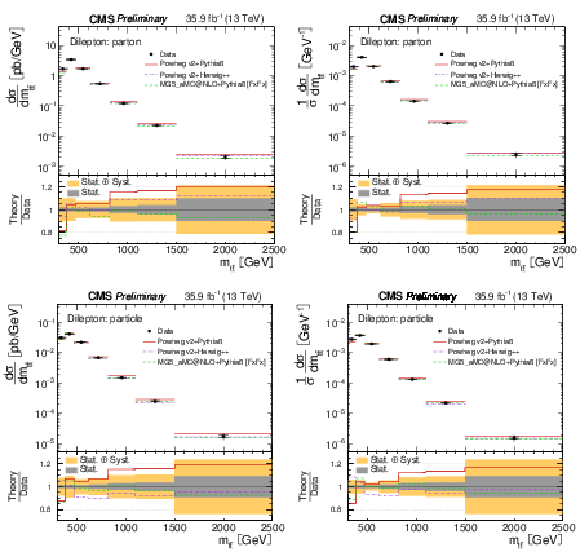
png pdf |
Figure 24:
The differential $ {\text {t}\bar{\text {t}}} $ production cross sections as a function of $m_{{\text {t}\bar{\text {t}}}}$ are shown. The left and right columns correspond to absolute and normalised measurements, respectively. The upper row corresponds to measurements at parton level in the full phase space and the lower row to particle level in a fiducial phase space. The lower panel in each plot shows the ratio of the theoretical prediction to the data. |

png pdf |
Figure 24-a:
The differential $ {\text {t}\bar{\text {t}}} $ production cross sections as a function of $m_{{\text {t}\bar{\text {t}}}}$ are shown. The left and right columns correspond to absolute and normalised measurements, respectively. The upper row corresponds to measurements at parton level in the full phase space and the lower row to particle level in a fiducial phase space. The lower panel in each plot shows the ratio of the theoretical prediction to the data. |
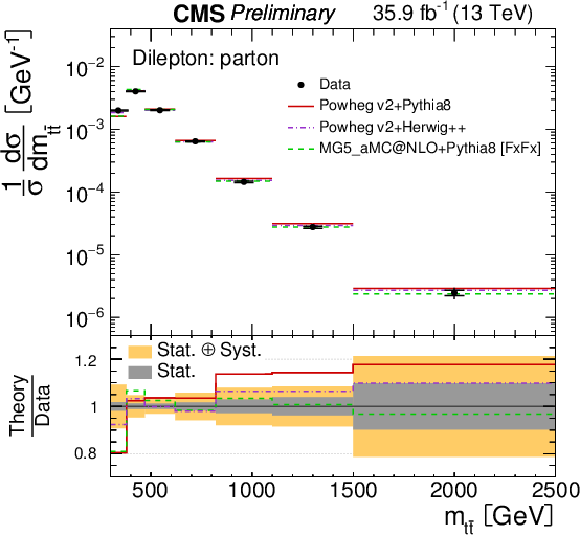
png pdf |
Figure 24-b:
The differential $ {\text {t}\bar{\text {t}}} $ production cross sections as a function of $m_{{\text {t}\bar{\text {t}}}}$ are shown. The left and right columns correspond to absolute and normalised measurements, respectively. The upper row corresponds to measurements at parton level in the full phase space and the lower row to particle level in a fiducial phase space. The lower panel in each plot shows the ratio of the theoretical prediction to the data. |
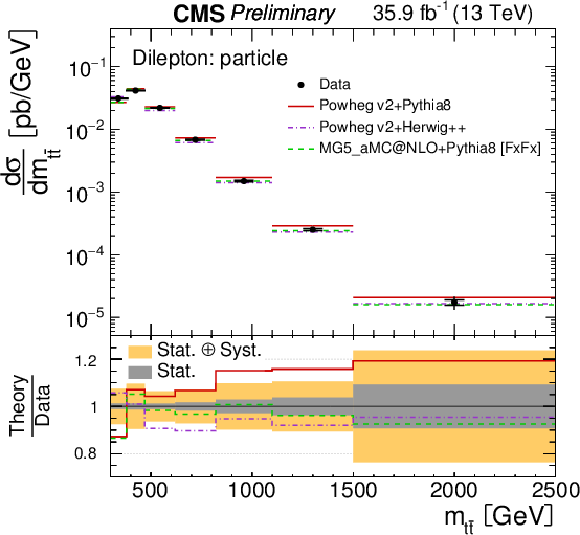
png pdf |
Figure 24-c:
The differential $ {\text {t}\bar{\text {t}}} $ production cross sections as a function of $m_{{\text {t}\bar{\text {t}}}}$ are shown. The left and right columns correspond to absolute and normalised measurements, respectively. The upper row corresponds to measurements at parton level in the full phase space and the lower row to particle level in a fiducial phase space. The lower panel in each plot shows the ratio of the theoretical prediction to the data. |
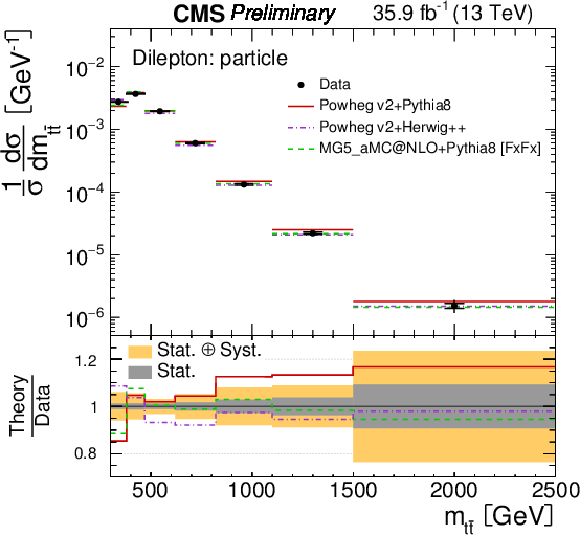
png pdf |
Figure 24-d:
The differential $ {\text {t}\bar{\text {t}}} $ production cross sections as a function of $m_{{\text {t}\bar{\text {t}}}}$ are shown. The left and right columns correspond to absolute and normalised measurements, respectively. The upper row corresponds to measurements at parton level in the full phase space and the lower row to particle level in a fiducial phase space. The lower panel in each plot shows the ratio of the theoretical prediction to the data. |
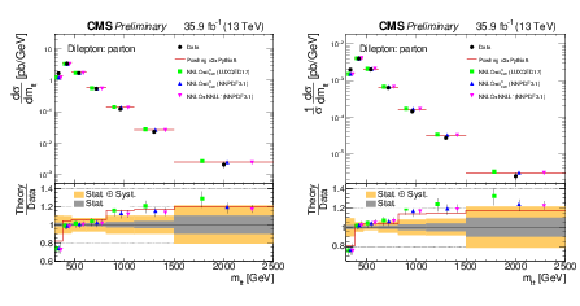
png pdf |
Figure 25:
The differential $ {\text {t}\bar{\text {t}}} $ production cross sections at parton level in full phase space as a function of $m_{{\text {t}\bar{\text {t}}}}$ are compared to theoretical predictions with beyond NLO precision. The left and right plots correspond to absolute and normalised measurements, respectively. The lower panel in each plot shows the ratio of the theoretical prediction to the data. |

png pdf |
Figure 25-a:
The differential $ {\text {t}\bar{\text {t}}} $ production cross sections at parton level in full phase space as a function of $m_{{\text {t}\bar{\text {t}}}}$ are compared to theoretical predictions with beyond NLO precision. The left and right plots correspond to absolute and normalised measurements, respectively. The lower panel in each plot shows the ratio of the theoretical prediction to the data. |
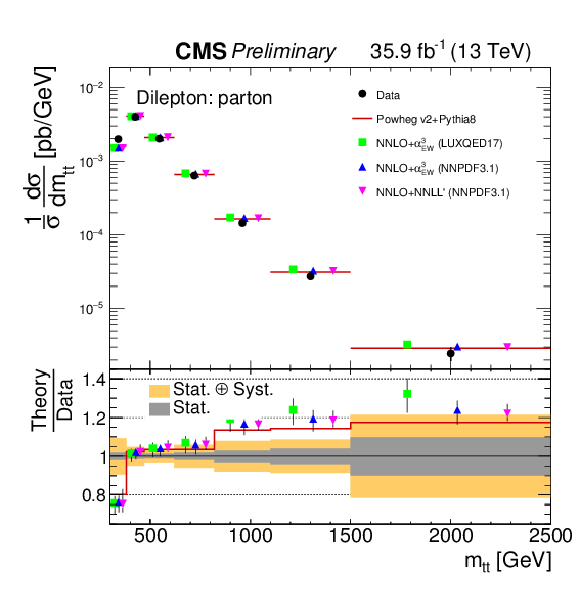
png pdf |
Figure 25-b:
The differential $ {\text {t}\bar{\text {t}}} $ production cross sections at parton level in full phase space as a function of $m_{{\text {t}\bar{\text {t}}}}$ are compared to theoretical predictions with beyond NLO precision. The left and right plots correspond to absolute and normalised measurements, respectively. The lower panel in each plot shows the ratio of the theoretical prediction to the data. |
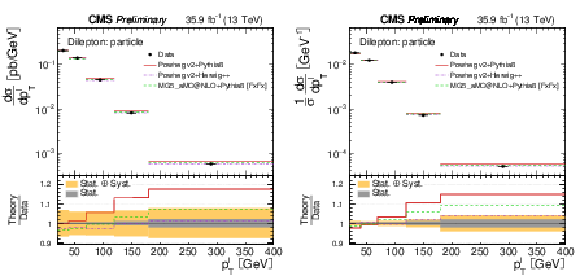
png pdf |
Figure 26:
The differential $ {\text {t}\bar{\text {t}}} $ production cross sections as a function of $ {p_{\mathrm {T}}} ^{\text {l}}$ in a fiducial phase space at particle level are shown. The left and right plots correspond to absolute and normalised measurements, respectively. The lower panel in each plot shows the ratio of the theoretical prediction to the data. |

png pdf |
Figure 26-a:
The differential $ {\text {t}\bar{\text {t}}} $ production cross sections as a function of $ {p_{\mathrm {T}}} ^{\text {l}}$ in a fiducial phase space at particle level are shown. The left and right plots correspond to absolute and normalised measurements, respectively. The lower panel in each plot shows the ratio of the theoretical prediction to the data. |

png pdf |
Figure 26-b:
The differential $ {\text {t}\bar{\text {t}}} $ production cross sections as a function of $ {p_{\mathrm {T}}} ^{\text {l}}$ in a fiducial phase space at particle level are shown. The left and right plots correspond to absolute and normalised measurements, respectively. The lower panel in each plot shows the ratio of the theoretical prediction to the data. |
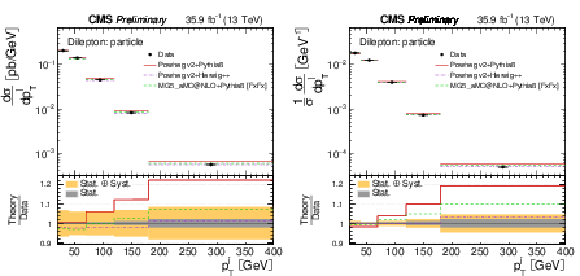
png pdf |
Figure 27:
The differential $ {\text {t}\bar{\text {t}}} $ production cross sections as a function of $ {p_{\mathrm {T}}} ^{{\bar{\text {l}}}}$ in a fiducial phase space at particle level are shown. The left and right plots correspond to absolute and normalised measurements, respectively. The lower panel in each plot shows the ratio of the theoretical prediction to the data. |
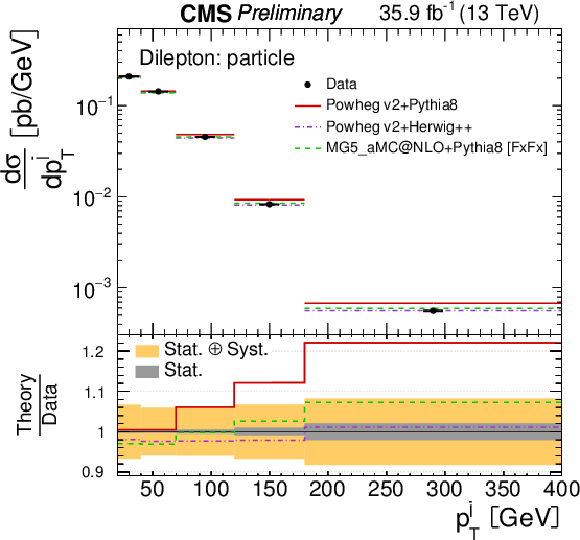
png pdf |
Figure 27-a:
The differential $ {\text {t}\bar{\text {t}}} $ production cross sections as a function of $ {p_{\mathrm {T}}} ^{{\bar{\text {l}}}}$ in a fiducial phase space at particle level are shown. The left and right plots correspond to absolute and normalised measurements, respectively. The lower panel in each plot shows the ratio of the theoretical prediction to the data. |
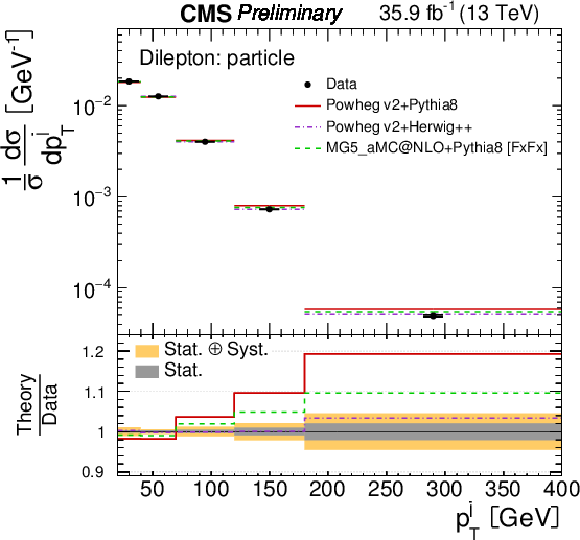
png pdf |
Figure 27-b:
The differential $ {\text {t}\bar{\text {t}}} $ production cross sections as a function of $ {p_{\mathrm {T}}} ^{{\bar{\text {l}}}}$ in a fiducial phase space at particle level are shown. The left and right plots correspond to absolute and normalised measurements, respectively. The lower panel in each plot shows the ratio of the theoretical prediction to the data. |
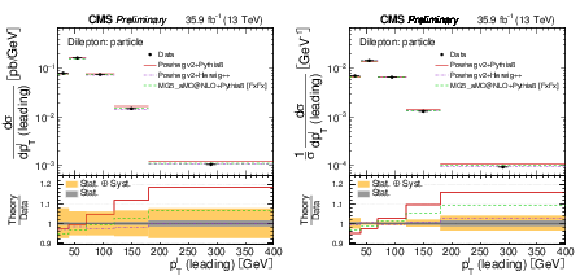
png pdf |
Figure 28:
The differential $ {\text {t}\bar{\text {t}}} $ production cross sections as a function of $ {p_{\mathrm {T}}} ^{\text {l}}$ (leading) in a fiducial phase space at particle level are shown. The left and right plots correspond to absolute and normalised measurements, respectively. The lower panel in each plot shows the ratio of the theoretical prediction to the data. |

png pdf |
Figure 28-a:
The differential $ {\text {t}\bar{\text {t}}} $ production cross sections as a function of $ {p_{\mathrm {T}}} ^{\text {l}}$ (leading) in a fiducial phase space at particle level are shown. The left and right plots correspond to absolute and normalised measurements, respectively. The lower panel in each plot shows the ratio of the theoretical prediction to the data. |
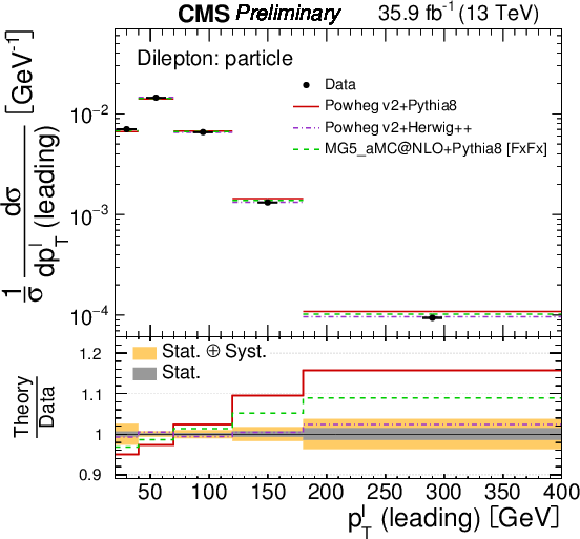
png pdf |
Figure 28-b:
The differential $ {\text {t}\bar{\text {t}}} $ production cross sections as a function of $ {p_{\mathrm {T}}} ^{\text {l}}$ (leading) in a fiducial phase space at particle level are shown. The left and right plots correspond to absolute and normalised measurements, respectively. The lower panel in each plot shows the ratio of the theoretical prediction to the data. |
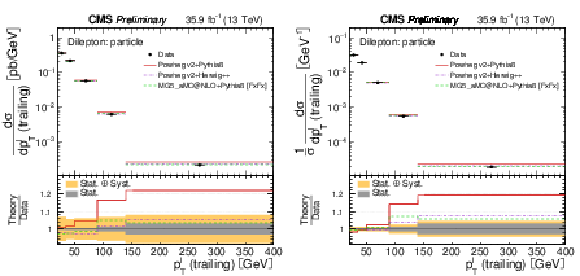
png pdf |
Figure 29:
The differential $ {\text {t}\bar{\text {t}}} $ production cross sections as a function of $ {p_{\mathrm {T}}} ^{\text {l}}$ (trailing) in a fiducial phase space at particle level are shown. The left and right plots correspond to absolute and normalised measurements, respectively. The lower panel in each plot shows the ratio of the theoretical prediction to the data. |

png pdf |
Figure 29-a:
The differential $ {\text {t}\bar{\text {t}}} $ production cross sections as a function of $ {p_{\mathrm {T}}} ^{\text {l}}$ (trailing) in a fiducial phase space at particle level are shown. The left and right plots correspond to absolute and normalised measurements, respectively. The lower panel in each plot shows the ratio of the theoretical prediction to the data. |
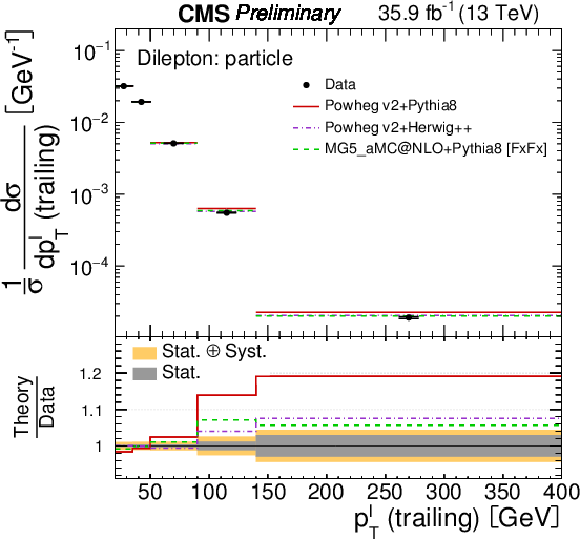
png pdf |
Figure 29-b:
The differential $ {\text {t}\bar{\text {t}}} $ production cross sections as a function of $ {p_{\mathrm {T}}} ^{\text {l}}$ (trailing) in a fiducial phase space at particle level are shown. The left and right plots correspond to absolute and normalised measurements, respectively. The lower panel in each plot shows the ratio of the theoretical prediction to the data. |
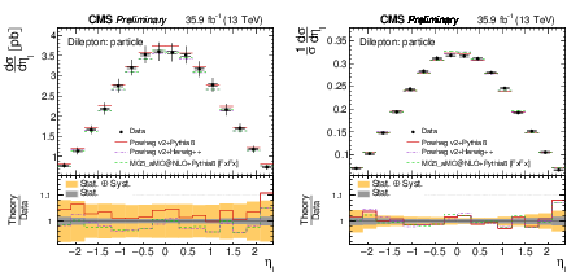
png pdf |
Figure 30:
The differential $ {\text {t}\bar{\text {t}}} $ production cross sections as a function of $\eta _{\text {l}}$ in a fiducial phase space at particle level are shown. The left and right plots correspond to absolute and normalised measurements, respectively. The lower panel in each plot shows the ratio of the theoretical prediction to the data. |
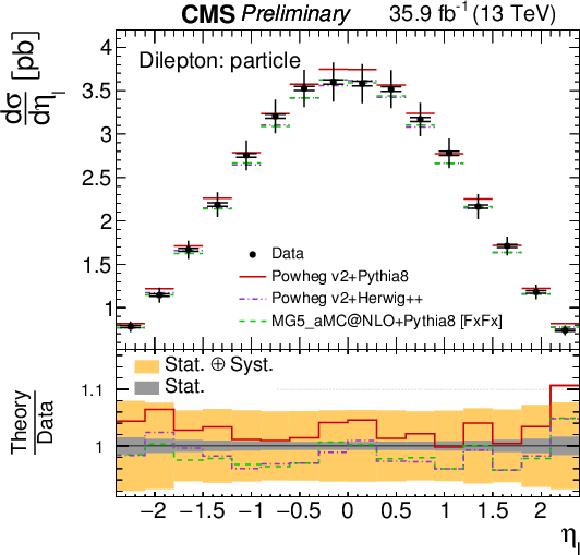
png pdf |
Figure 30-a:
The differential $ {\text {t}\bar{\text {t}}} $ production cross sections as a function of $\eta _{\text {l}}$ in a fiducial phase space at particle level are shown. The left and right plots correspond to absolute and normalised measurements, respectively. The lower panel in each plot shows the ratio of the theoretical prediction to the data. |

png pdf |
Figure 30-b:
The differential $ {\text {t}\bar{\text {t}}} $ production cross sections as a function of $\eta _{\text {l}}$ in a fiducial phase space at particle level are shown. The left and right plots correspond to absolute and normalised measurements, respectively. The lower panel in each plot shows the ratio of the theoretical prediction to the data. |
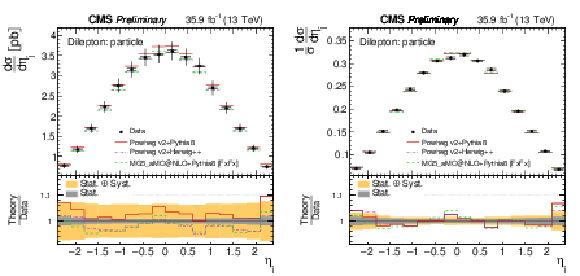
png pdf |
Figure 31:
The differential $ {\text {t}\bar{\text {t}}} $ production cross sections as a function of $\eta _{{\bar{\text {l}}}}$ in a fiducial phase space at particle level are shown. The left and right plots correspond to absolute and normalised measurements, respectively. The lower panel in each plot shows the ratio of the theoretical prediction to the data. |
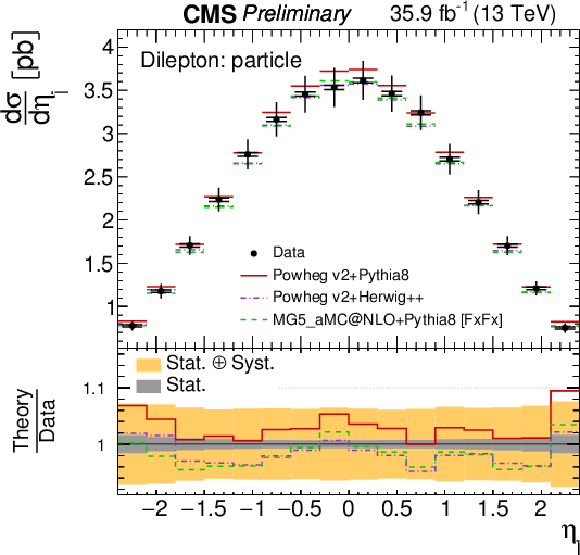
png pdf |
Figure 31-a:
The differential $ {\text {t}\bar{\text {t}}} $ production cross sections as a function of $\eta _{{\bar{\text {l}}}}$ in a fiducial phase space at particle level are shown. The left and right plots correspond to absolute and normalised measurements, respectively. The lower panel in each plot shows the ratio of the theoretical prediction to the data. |
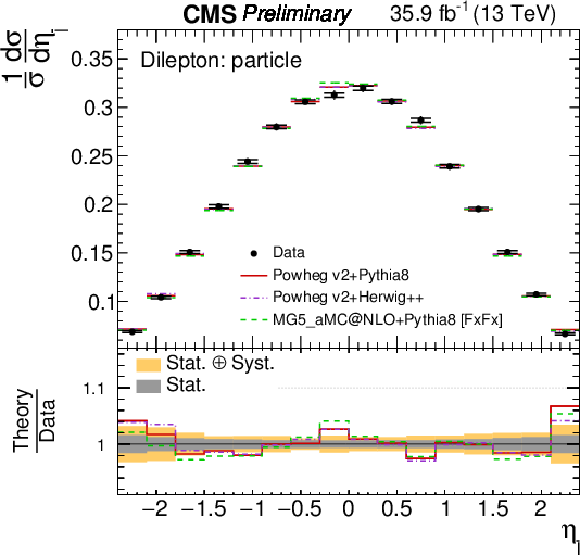
png pdf |
Figure 31-b:
The differential $ {\text {t}\bar{\text {t}}} $ production cross sections as a function of $\eta _{{\bar{\text {l}}}}$ in a fiducial phase space at particle level are shown. The left and right plots correspond to absolute and normalised measurements, respectively. The lower panel in each plot shows the ratio of the theoretical prediction to the data. |
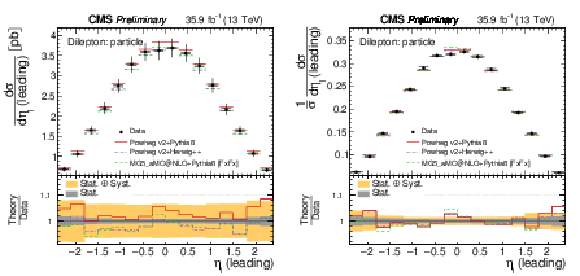
png pdf |
Figure 32:
The differential $ {\text {t}\bar{\text {t}}} $ production cross sections as a function of $\eta _{\text {l}}$ (leading) in a fiducial phase space at particle level are shown. The left and right plots correspond to absolute and normalised measurements, respectively. The lower panel in each plot shows the ratio of the theoretical prediction to the data. |
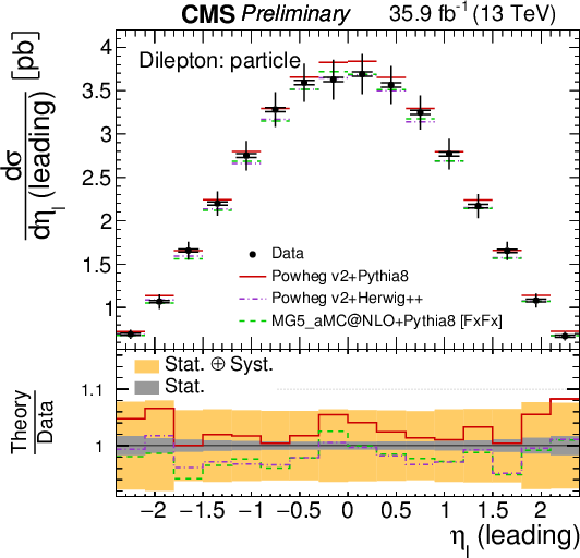
png pdf |
Figure 32-a:
The differential $ {\text {t}\bar{\text {t}}} $ production cross sections as a function of $\eta _{\text {l}}$ (leading) in a fiducial phase space at particle level are shown. The left and right plots correspond to absolute and normalised measurements, respectively. The lower panel in each plot shows the ratio of the theoretical prediction to the data. |
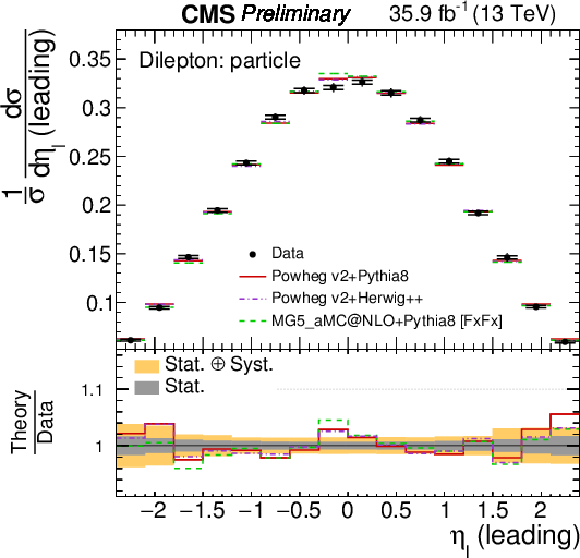
png pdf |
Figure 32-b:
The differential $ {\text {t}\bar{\text {t}}} $ production cross sections as a function of $\eta _{\text {l}}$ (leading) in a fiducial phase space at particle level are shown. The left and right plots correspond to absolute and normalised measurements, respectively. The lower panel in each plot shows the ratio of the theoretical prediction to the data. |
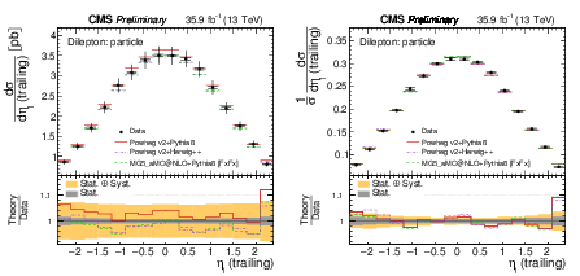
png pdf |
Figure 33:
The differential $ {\text {t}\bar{\text {t}}} $ production cross sections as a function of $\eta _{\text {l}}$ (trailing) in a fiducial phase space at particle level are shown. The left and right plots correspond to absolute and normalised measurements, respectively. The lower panel in each plot shows the ratio of the theoretical prediction to the data. |
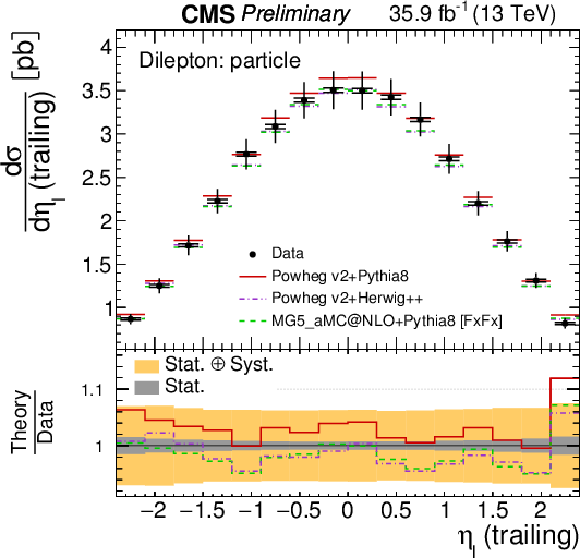
png pdf |
Figure 33-a:
The differential $ {\text {t}\bar{\text {t}}} $ production cross sections as a function of $\eta _{\text {l}}$ (trailing) in a fiducial phase space at particle level are shown. The left and right plots correspond to absolute and normalised measurements, respectively. The lower panel in each plot shows the ratio of the theoretical prediction to the data. |
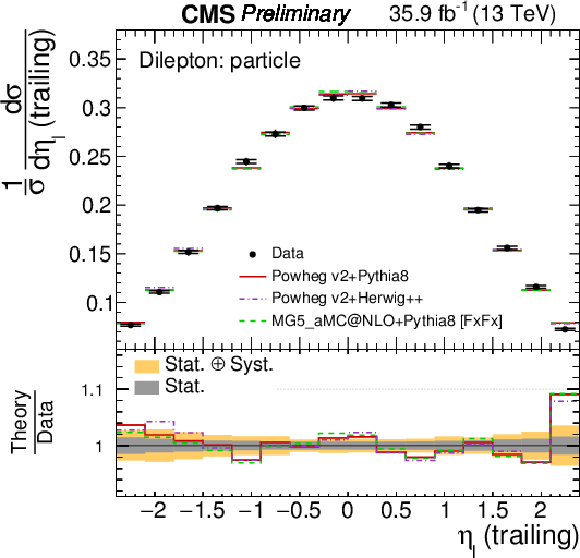
png pdf |
Figure 33-b:
The differential $ {\text {t}\bar{\text {t}}} $ production cross sections as a function of $\eta _{\text {l}}$ (trailing) in a fiducial phase space at particle level are shown. The left and right plots correspond to absolute and normalised measurements, respectively. The lower panel in each plot shows the ratio of the theoretical prediction to the data. |

png pdf |
Figure 34:
The differential $ {\text {t}\bar{\text {t}}} $ production cross sections as a function of $ {p_{\mathrm {T}}} ^{{\text {l}\bar{\text {l}}}}$ in a fiducial phase space at particle level are shown. The left and right plots correspond to absolute and normalised measurements, respectively. The lower panel in each plot shows the ratio of the theoretical prediction to the data. |
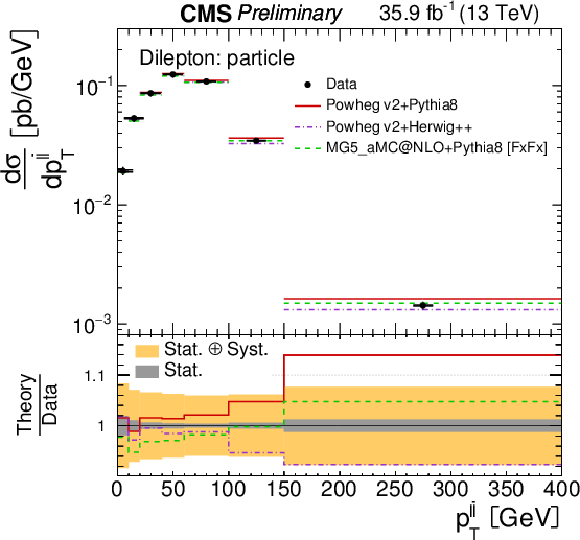
png pdf |
Figure 34-a:
The differential $ {\text {t}\bar{\text {t}}} $ production cross sections as a function of $ {p_{\mathrm {T}}} ^{{\text {l}\bar{\text {l}}}}$ in a fiducial phase space at particle level are shown. The left and right plots correspond to absolute and normalised measurements, respectively. The lower panel in each plot shows the ratio of the theoretical prediction to the data. |
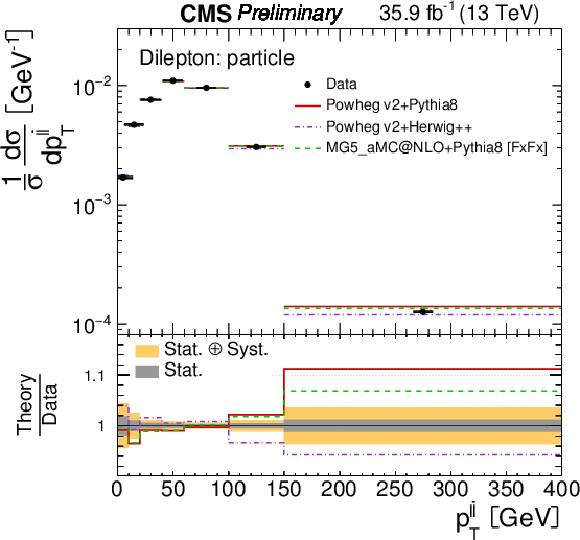
png pdf |
Figure 34-b:
The differential $ {\text {t}\bar{\text {t}}} $ production cross sections as a function of $ {p_{\mathrm {T}}} ^{{\text {l}\bar{\text {l}}}}$ in a fiducial phase space at particle level are shown. The left and right plots correspond to absolute and normalised measurements, respectively. The lower panel in each plot shows the ratio of the theoretical prediction to the data. |
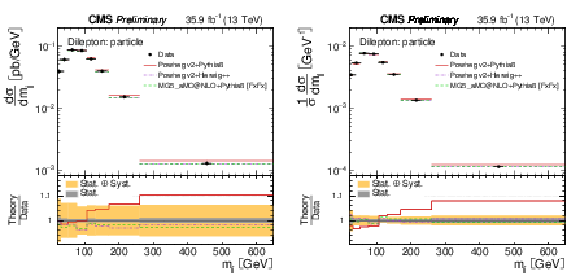
png pdf |
Figure 35:
The differential $ {\text {t}\bar{\text {t}}} $ production cross sections as a function of $m_{{\text {l}\bar{\text {l}}}}$ in a fiducial phase space at particle level are shown. The left and right plots correspond to absolute and normalised measurements, respectively. The lower panel in each plot shows the ratio of the theoretical prediction to the data. |
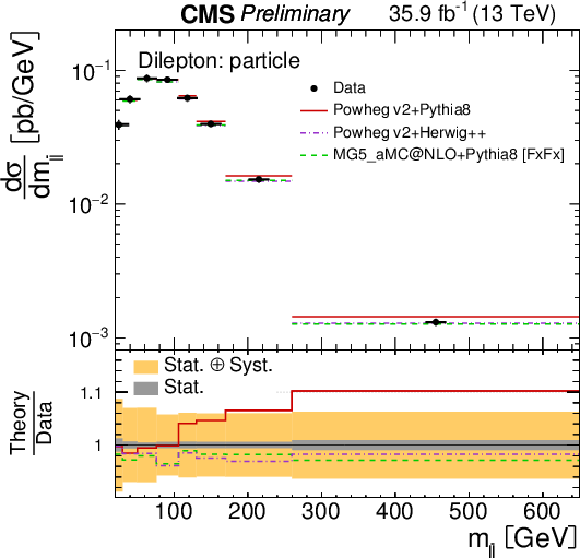
png pdf |
Figure 35-a:
The differential $ {\text {t}\bar{\text {t}}} $ production cross sections as a function of $m_{{\text {l}\bar{\text {l}}}}$ in a fiducial phase space at particle level are shown. The left and right plots correspond to absolute and normalised measurements, respectively. The lower panel in each plot shows the ratio of the theoretical prediction to the data. |
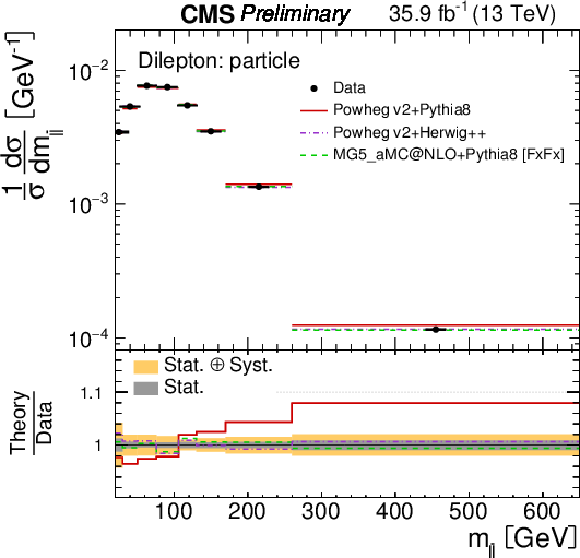
png pdf |
Figure 35-b:
The differential $ {\text {t}\bar{\text {t}}} $ production cross sections as a function of $m_{{\text {l}\bar{\text {l}}}}$ in a fiducial phase space at particle level are shown. The left and right plots correspond to absolute and normalised measurements, respectively. The lower panel in each plot shows the ratio of the theoretical prediction to the data. |
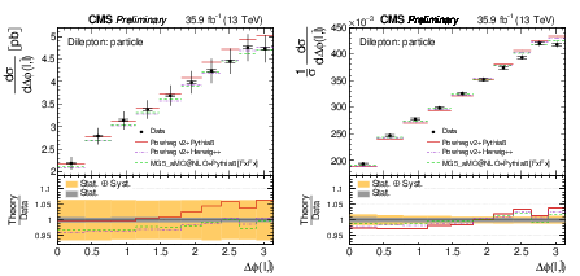
png pdf |
Figure 36:
The differential $ {\text {t}\bar{\text {t}}} $ production cross sections as a function of $\Delta \phi $(l, ${\bar{\text {l}}}$) in a fiducial phase space at particle level are shown. The left and right plots correspond to absolute and normalised measurements, respectively. The lower panel in each plot shows the ratio of the theoretical prediction to the data. |
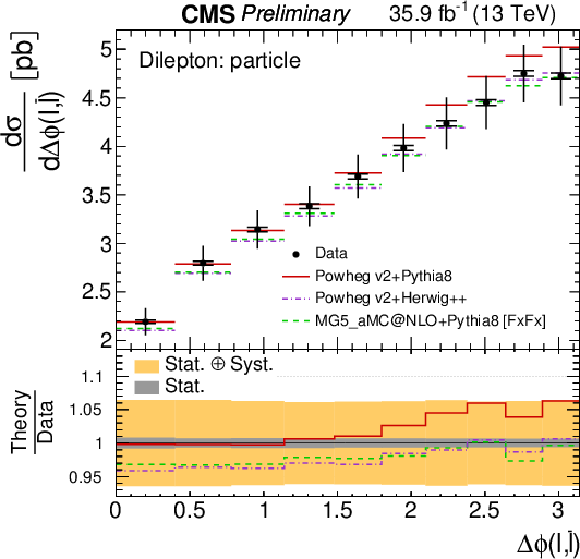
png pdf |
Figure 36-a:
The differential $ {\text {t}\bar{\text {t}}} $ production cross sections as a function of $\Delta \phi $(l, ${\bar{\text {l}}}$) in a fiducial phase space at particle level are shown. The left and right plots correspond to absolute and normalised measurements, respectively. The lower panel in each plot shows the ratio of the theoretical prediction to the data. |
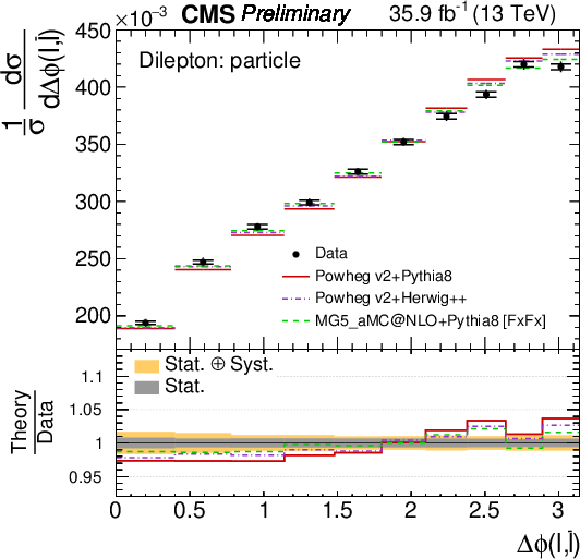
png pdf |
Figure 36-b:
The differential $ {\text {t}\bar{\text {t}}} $ production cross sections as a function of $\Delta \phi $(l, ${\bar{\text {l}}}$) in a fiducial phase space at particle level are shown. The left and right plots correspond to absolute and normalised measurements, respectively. The lower panel in each plot shows the ratio of the theoretical prediction to the data. |
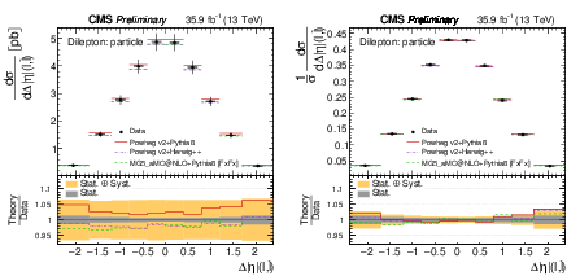
png pdf |
Figure 37:
The differential $ {\text {t}\bar{\text {t}}} $ production cross sections as a function of $\Delta |\eta |$(l,$ {\bar{\text {l}}}$) in a fiducial phase space at particle level are shown. The left and right plots correspond to absolute and normalised measurements, respectively. The lower panel in each plot shows the ratio of the theoretical prediction to the data. |
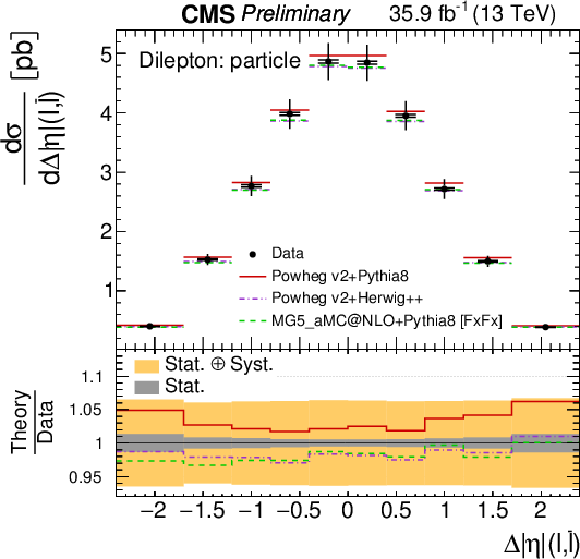
png pdf |
Figure 37-a:
The differential $ {\text {t}\bar{\text {t}}} $ production cross sections as a function of $\Delta |\eta |$(l,$ {\bar{\text {l}}}$) in a fiducial phase space at particle level are shown. The left and right plots correspond to absolute and normalised measurements, respectively. The lower panel in each plot shows the ratio of the theoretical prediction to the data. |
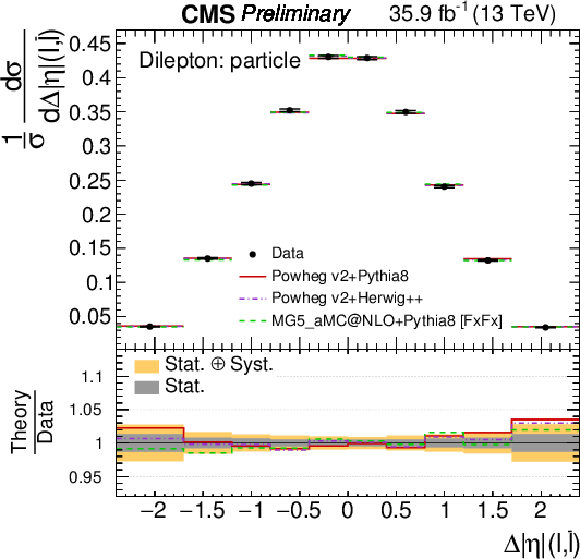
png pdf |
Figure 37-b:
The differential $ {\text {t}\bar{\text {t}}} $ production cross sections as a function of $\Delta |\eta |$(l,$ {\bar{\text {l}}}$) in a fiducial phase space at particle level are shown. The left and right plots correspond to absolute and normalised measurements, respectively. The lower panel in each plot shows the ratio of the theoretical prediction to the data. |

png pdf |
Figure 38:
The differential $ {\text {t}\bar{\text {t}}} $ production cross sections as a function of $N_{\text {jets}}$\ in a fiducial phase space at particle level are shown. The left and right plots correspond to absolute and normalised measurements, respectively. The lower panel in each plot shows the ratio of the theoretical prediction to the data. |
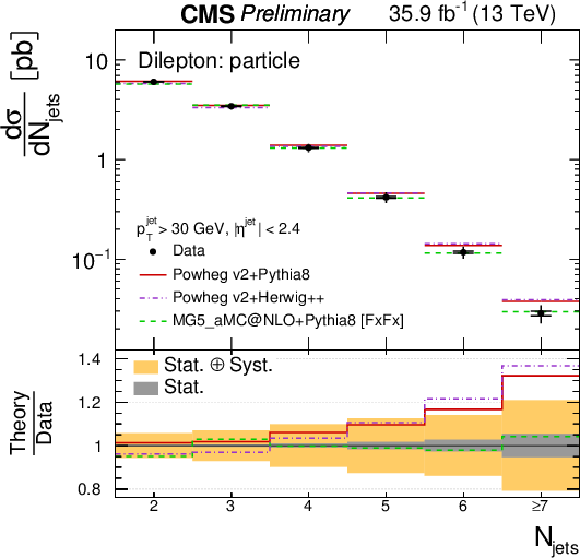
png pdf |
Figure 38-a:
The differential $ {\text {t}\bar{\text {t}}} $ production cross sections as a function of $N_{\text {jets}}$\ in a fiducial phase space at particle level are shown. The left and right plots correspond to absolute and normalised measurements, respectively. The lower panel in each plot shows the ratio of the theoretical prediction to the data. |
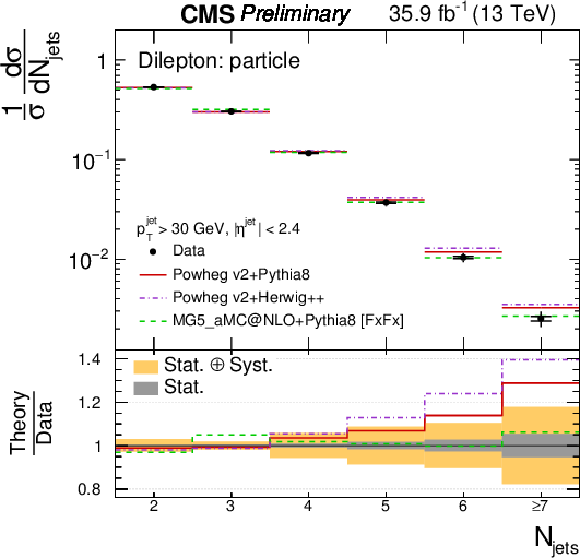
png pdf |
Figure 38-b:
The differential $ {\text {t}\bar{\text {t}}} $ production cross sections as a function of $N_{\text {jets}}$\ in a fiducial phase space at particle level are shown. The left and right plots correspond to absolute and normalised measurements, respectively. The lower panel in each plot shows the ratio of the theoretical prediction to the data. |
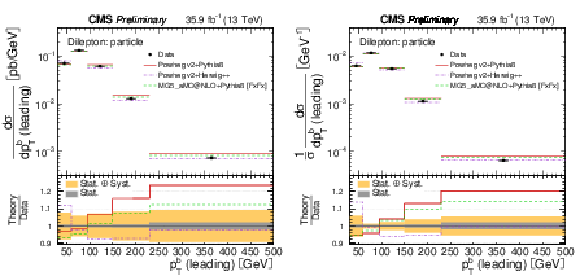
png pdf |
Figure 39:
The differential $ {\text {t}\bar{\text {t}}} $ production cross sections as a function of $ {p_{\mathrm {T}}} ^{\text {b}}$ (leading) in a fiducial phase space at particle level are shown. The left and right plots correspond to absolute and normalised measurements, respectively. The lower panel in each plot shows the ratio of the theoretical prediction to the data. |

png pdf |
Figure 39-a:
The differential $ {\text {t}\bar{\text {t}}} $ production cross sections as a function of $ {p_{\mathrm {T}}} ^{\text {b}}$ (leading) in a fiducial phase space at particle level are shown. The left and right plots correspond to absolute and normalised measurements, respectively. The lower panel in each plot shows the ratio of the theoretical prediction to the data. |
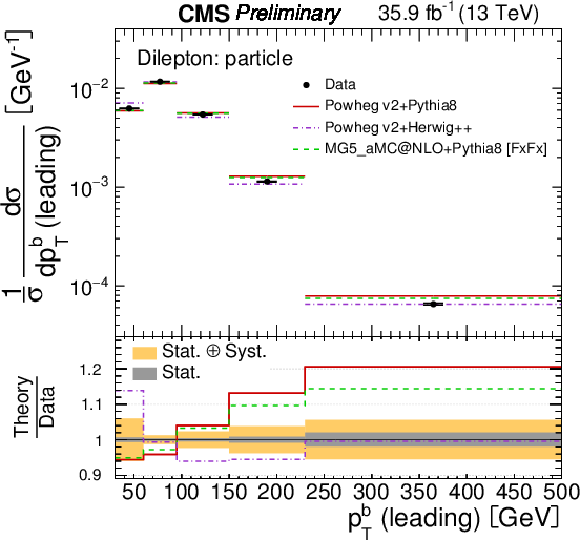
png pdf |
Figure 39-b:
The differential $ {\text {t}\bar{\text {t}}} $ production cross sections as a function of $ {p_{\mathrm {T}}} ^{\text {b}}$ (leading) in a fiducial phase space at particle level are shown. The left and right plots correspond to absolute and normalised measurements, respectively. The lower panel in each plot shows the ratio of the theoretical prediction to the data. |
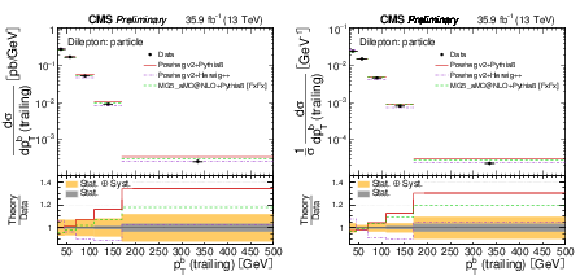
png pdf |
Figure 40:
The differential $ {\text {t}\bar{\text {t}}} $ production cross sections as a function of $ {p_{\mathrm {T}}} ^{\text {b}}$ (trailing) in a fiducial phase space at particle level are shown. The left and right plots correspond to absolute and normalised measurements, respectively. The lower panel in each plot shows the ratio of the theoretical prediction to the data. |
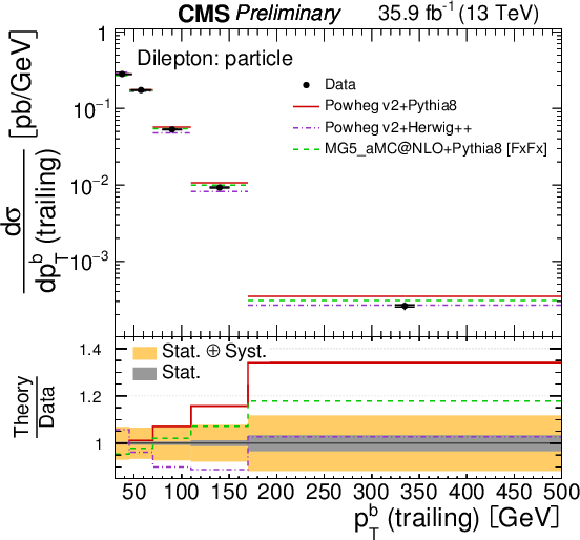
png pdf |
Figure 40-a:
The differential $ {\text {t}\bar{\text {t}}} $ production cross sections as a function of $ {p_{\mathrm {T}}} ^{\text {b}}$ (trailing) in a fiducial phase space at particle level are shown. The left and right plots correspond to absolute and normalised measurements, respectively. The lower panel in each plot shows the ratio of the theoretical prediction to the data. |
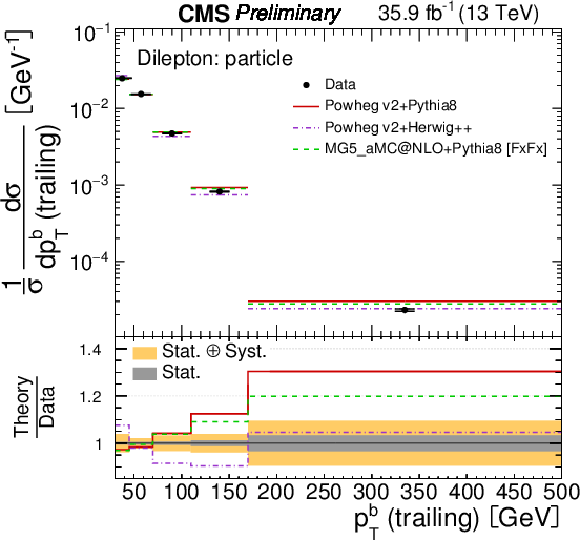
png pdf |
Figure 40-b:
The differential $ {\text {t}\bar{\text {t}}} $ production cross sections as a function of $ {p_{\mathrm {T}}} ^{\text {b}}$ (trailing) in a fiducial phase space at particle level are shown. The left and right plots correspond to absolute and normalised measurements, respectively. The lower panel in each plot shows the ratio of the theoretical prediction to the data. |
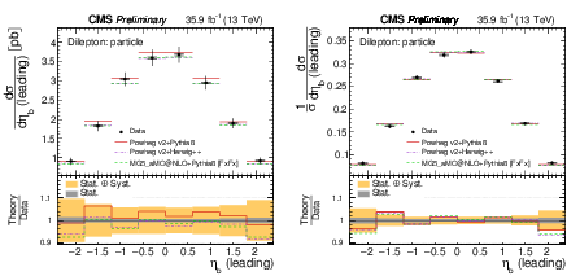
png pdf |
Figure 41:
The differential $ {\text {t}\bar{\text {t}}} $ production cross sections as a function of $\eta _{\text {b}}$ (leading) in a fiducial phase space at particle level are shown. The left and right plots correspond to absolute and normalised measurements, respectively. The lower panel in each plot shows the ratio of the theoretical prediction to the data. |

png pdf |
Figure 41-a:
The differential $ {\text {t}\bar{\text {t}}} $ production cross sections as a function of $\eta _{\text {b}}$ (leading) in a fiducial phase space at particle level are shown. The left and right plots correspond to absolute and normalised measurements, respectively. The lower panel in each plot shows the ratio of the theoretical prediction to the data. |

png pdf |
Figure 41-b:
The differential $ {\text {t}\bar{\text {t}}} $ production cross sections as a function of $\eta _{\text {b}}$ (leading) in a fiducial phase space at particle level are shown. The left and right plots correspond to absolute and normalised measurements, respectively. The lower panel in each plot shows the ratio of the theoretical prediction to the data. |

png pdf |
Figure 42:
The differential $ {\text {t}\bar{\text {t}}} $ production cross sections as a function of $\eta _{\text {b}}$ (trailing) in a fiducial phase space at particle level are shown. The left and right plots correspond to absolute and normalised measurements, respectively. The lower panel in each plot shows the ratio of the theoretical prediction to the data. |
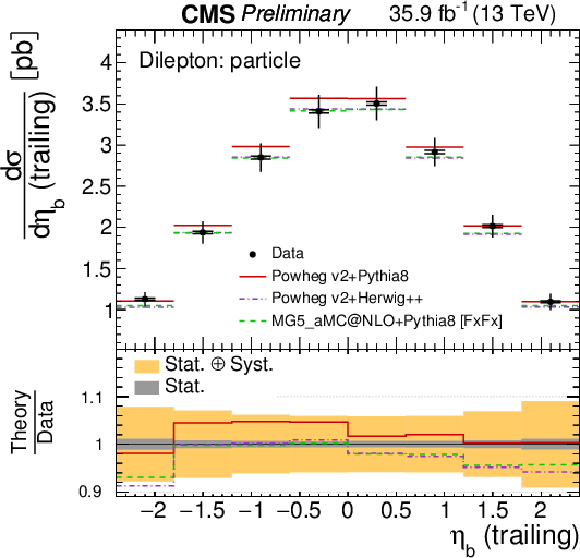
png pdf |
Figure 42-a:
The differential $ {\text {t}\bar{\text {t}}} $ production cross sections as a function of $\eta _{\text {b}}$ (trailing) in a fiducial phase space at particle level are shown. The left and right plots correspond to absolute and normalised measurements, respectively. The lower panel in each plot shows the ratio of the theoretical prediction to the data. |

png pdf |
Figure 42-b:
The differential $ {\text {t}\bar{\text {t}}} $ production cross sections as a function of $\eta _{\text {b}}$ (trailing) in a fiducial phase space at particle level are shown. The left and right plots correspond to absolute and normalised measurements, respectively. The lower panel in each plot shows the ratio of the theoretical prediction to the data. |
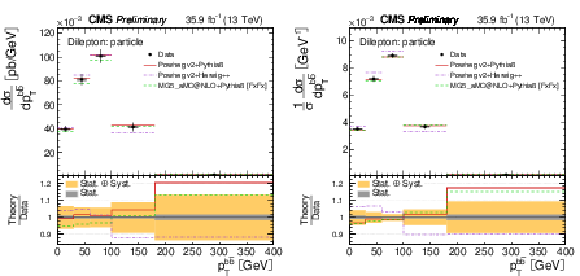
png pdf |
Figure 43:
The differential $ {\text {t}\bar{\text {t}}} $ production cross sections as a function of $ {p_{\mathrm {T}}} ^{{\text {b}\bar{\text {b}}}}$ in a fiducial phase space at particle level are shown. The left and right plots correspond to absolute and normalised measurements, respectively. The lower panel in each plot shows the ratio of the theoretical prediction to the data. |
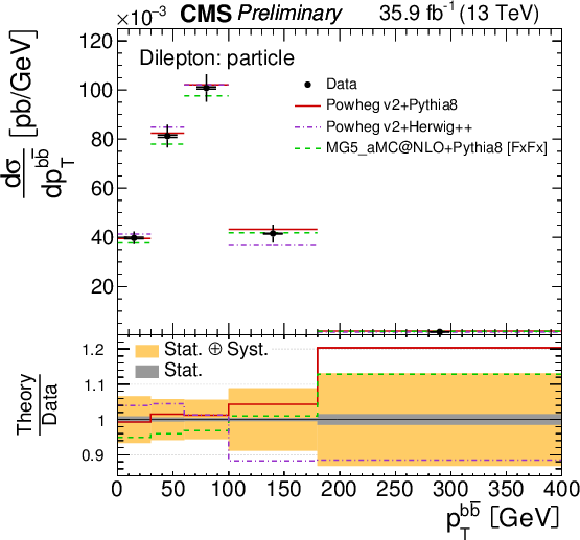
png pdf |
Figure 43-a:
The differential $ {\text {t}\bar{\text {t}}} $ production cross sections as a function of $ {p_{\mathrm {T}}} ^{{\text {b}\bar{\text {b}}}}$ in a fiducial phase space at particle level are shown. The left and right plots correspond to absolute and normalised measurements, respectively. The lower panel in each plot shows the ratio of the theoretical prediction to the data. |
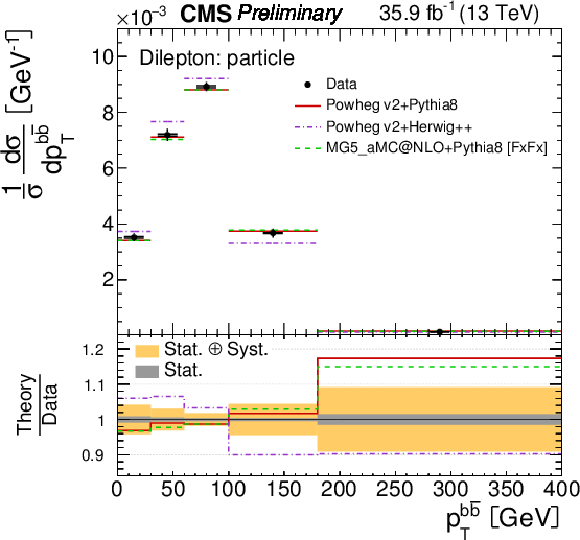
png pdf |
Figure 43-b:
The differential $ {\text {t}\bar{\text {t}}} $ production cross sections as a function of $ {p_{\mathrm {T}}} ^{{\text {b}\bar{\text {b}}}}$ in a fiducial phase space at particle level are shown. The left and right plots correspond to absolute and normalised measurements, respectively. The lower panel in each plot shows the ratio of the theoretical prediction to the data. |
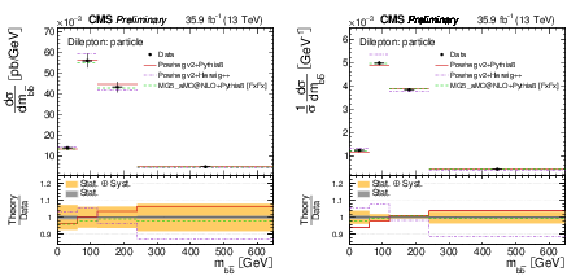
png pdf |
Figure 44:
The differential $ {\text {t}\bar{\text {t}}} $ production cross sections as a function of $m_{{\text {b}\bar{\text {b}}}}$ in a fiducial phase space at particle level are shown. The left and right plots correspond to absolute and normalised measurements, respectively. The lower panel in each plot shows the ratio of the theoretical prediction to the data. |
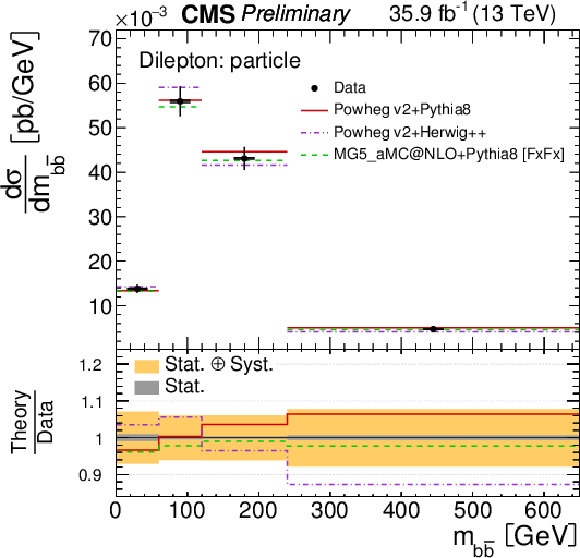
png pdf |
Figure 44-a:
The differential $ {\text {t}\bar{\text {t}}} $ production cross sections as a function of $m_{{\text {b}\bar{\text {b}}}}$ in a fiducial phase space at particle level are shown. The left and right plots correspond to absolute and normalised measurements, respectively. The lower panel in each plot shows the ratio of the theoretical prediction to the data. |

png pdf |
Figure 44-b:
The differential $ {\text {t}\bar{\text {t}}} $ production cross sections as a function of $m_{{\text {b}\bar{\text {b}}}}$ in a fiducial phase space at particle level are shown. The left and right plots correspond to absolute and normalised measurements, respectively. The lower panel in each plot shows the ratio of the theoretical prediction to the data. |
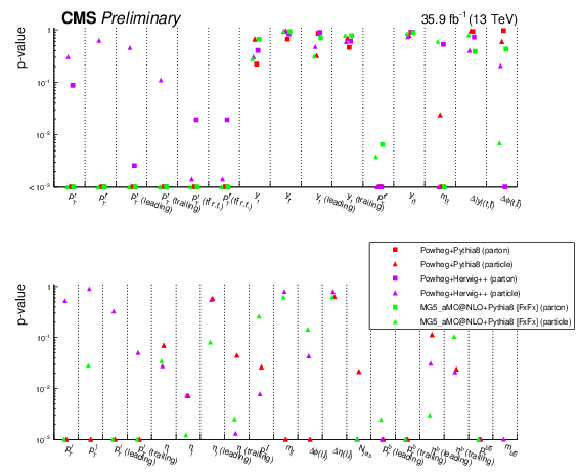
png pdf |
Figure 45:
The p-values quantifying the agreement between data and theoretical predictions from Monte Carlo generators for all normalised measurements are shown. Points situated on the horizontal axes indicate p-values less than 0.001. |
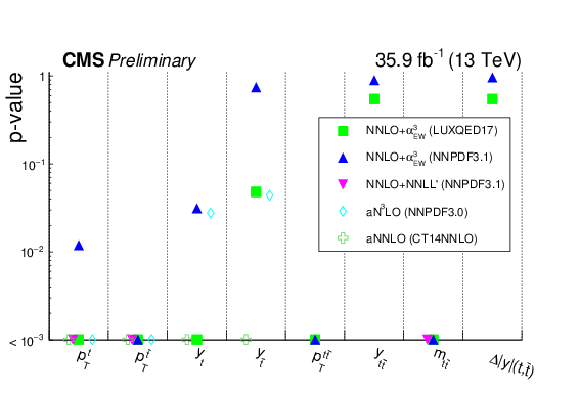
png pdf |
Figure 46:
The p-values quantifying the agreement between theoretical predictions with beyond NLO precision and data for selected normalised measurements at parton-level are shown. Points situated on the horizontal axes indicate p-values of less than 0.001. |
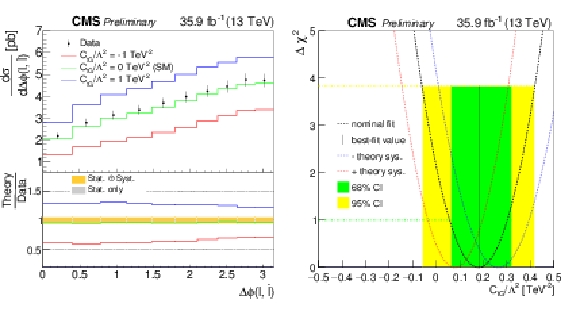
png pdf |
Figure 47:
In the left plot, the differential $ {\text {t}\bar{\text {t}}} $ cross sections as a function of $\Delta \phi $($l$, ${\bar{\text {l}}}$) at particle-level in a fiducial phase space is shown. The points correspond to data and the lines correspond to predictions with $C_\text {tG}/\lambda ^{2} = -1.0,\, 0.0,\, 1.0 $ TeV$^{-1}$, produced with the MG5\_aMC@NLO\ generator at NLO interfaced with PYTHIA8. The right plot shows the $\Delta \chi ^{2}$ as a function of $C_\text {tG}/\lambda ^{2}$. The nominal fit and corresponding 68% and 95% CIs are indicated by the central dashed curve and filled areas, respectively. The other dashed curves represent fits with the variations of the normalisations and shapes of the predictions that yield the largest deviations on the best-fit value of $C_\text {tG}/\lambda ^{2}$. |

png pdf |
Figure 47-a:
In the left plot, the differential $ {\text {t}\bar{\text {t}}} $ cross sections as a function of $\Delta \phi $($l$, ${\bar{\text {l}}}$) at particle-level in a fiducial phase space is shown. The points correspond to data and the lines correspond to predictions with $C_\text {tG}/\lambda ^{2} = -1.0,\, 0.0,\, 1.0 $ TeV$^{-1}$, produced with the MG5\_aMC@NLO\ generator at NLO interfaced with PYTHIA8. The right plot shows the $\Delta \chi ^{2}$ as a function of $C_\text {tG}/\lambda ^{2}$. The nominal fit and corresponding 68% and 95% CIs are indicated by the central dashed curve and filled areas, respectively. The other dashed curves represent fits with the variations of the normalisations and shapes of the predictions that yield the largest deviations on the best-fit value of $C_\text {tG}/\lambda ^{2}$. |

png pdf |
Figure 47-b:
In the left plot, the differential $ {\text {t}\bar{\text {t}}} $ cross sections as a function of $\Delta \phi $($l$, ${\bar{\text {l}}}$) at particle-level in a fiducial phase space is shown. The points correspond to data and the lines correspond to predictions with $C_\text {tG}/\lambda ^{2} = -1.0,\, 0.0,\, 1.0 $ TeV$^{-1}$, produced with the MG5\_aMC@NLO\ generator at NLO interfaced with PYTHIA8. The right plot shows the $\Delta \chi ^{2}$ as a function of $C_\text {tG}/\lambda ^{2}$. The nominal fit and corresponding 68% and 95% CIs are indicated by the central dashed curve and filled areas, respectively. The other dashed curves represent fits with the variations of the normalisations and shapes of the predictions that yield the largest deviations on the best-fit value of $C_\text {tG}/\lambda ^{2}$. |

png pdf |
Figure 48:
The results of the ${A_\text {c}^{\text {x}}}$ extraction (x = $ {\text {t}\bar{\text {t}}} $ or ${\text {l}\bar{\text {l}}}$) from normalised parton- and particle-level differential cross section measurements are shown. The central values for data are indicated by the solid line with the 68% and 95% CI represented by the shaded bands, respectively. The dashed lines indicate the SM predictions produced with the MG5\_aMC@NLO\ and POWHEG generators both interfaced with PYTHIA8and a calculation with NLO precision in QCD and including corrections arising from mixing between QCD and electroweak diagrams, and between QCD and QED diagrams [74]. |
| Tables | |
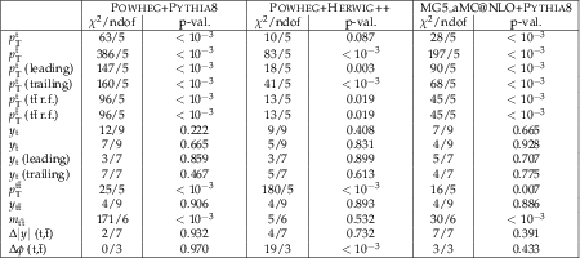
png pdf |
Table 1:
The $\chi ^{2}$/ndof and p values quantifying the agreement between theoretical predictions and data for normalised, parton-level measurements are shown. |
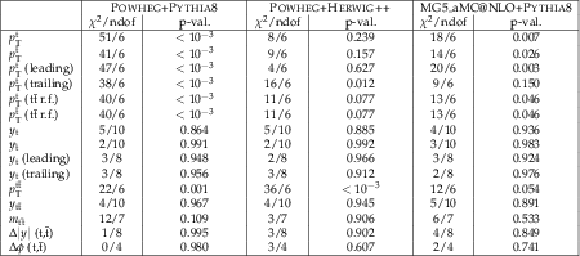
png pdf |
Table 2:
The $\chi ^{2}$/ndof and p values quantifying the agreement between theoretical predictions and data for absolute, parton-level measurements are shown. |
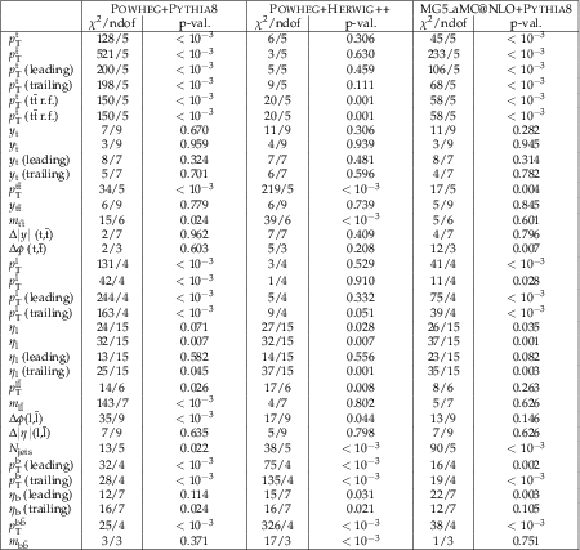
png pdf |
Table 3:
The $\chi ^{2}$/ndof and p values quantifying the agreement between theoretical predictions and data for normalised, particle-level measurements are shown. |

png pdf |
Table 4:
The $\chi ^{2}$/ndof and p values quantifying the agreement between theoretical predictions and data for absolute, particle-level measurements are shown. |

png pdf |
Table 5:
The $\chi ^{2}/ndof$ and p values quantifying the agreement between theoretical predictions and data for normalised, parton-level measurements are shown. |

png pdf |
Table 6:
The $\chi ^{2}/ndof$ and p values quantifying the agreement between theoretical predictions and data for absolute, parton-level measurements are shown. |
| Summary |
| Measurements are presented of absolute and normalised differential cross sections of $ \mathrm{t\bar{t}} $ production based on both particle-level objects in a fiducial phase space and parton-level top quarks in a full phase space using pp collisions at a centre-of-mass energy of 13 TeV recorded by the CMS detector. Most measured differential cross sections are well modelled by theoretical predictions. However, significant disagreement between the data and next-to-leading-order Monte Carlo is observed for the transverse momentum of top quarks, leptons, b jets, and $ \mathrm{t\bar{t}} $, $ {\text{l}\bar{\text{l}}} $, and $ \mathrm{b\bar{b}} $ systems and for the invariant mass of the $ \mathrm{t\bar{t}} $, $ {\text{l}\bar{\text{l}}} $, and $ \mathrm{b\bar{b}} $ systems. Similar levels of disagreement are observed for predictions with beyond NLO precision. The jet multiplicity distribution is not well described by any of the next-leading-order Monte Carlo predictions for high multiplicities with the exception of a prediction based on MG5\_aMC@NLO and Pythia8. The absolute particle-level differential cross section as a function of $\Delta\phi$(l,${\bar{\text{l}}}$) is used to constrain the top quark chromomagnetic dipole moment at next-to-leading order in quantum chromodynamics using an effective field theory framework. The normalised differential cross sections as a function of $\Delta|\text{y}|$(t,${\bar{\text{t}}}$) and $\Delta|\eta|$(l,${\bar{\text{l}}}$) are used to measure the $ \mathrm{t\bar{t}} $ and leptonic charge asymmetries for the first time using 13 TeV data. |
| References | ||||
| 1 | ATLAS Collaboration | Measurements of top quark pair relative differential cross-sections with ATLAS in pp collisions at $ \sqrt{s} = $ 7 TeV | EPJC 73 (2013) 2261 | 1207.5644 |
| 2 | ATLAS Collaboration | Measurement of the $ t\overline{t} $ production cross-section as a function of jet multiplicity and jet transverse momentum in 7 TeV proton-proton collisions with the ATLAS detector | JHEP 01 (2015) 020 | 1407.0891 |
| 3 | CMS Collaboration | Measurement of differential top-quark pair production cross sections in pp collisions at $ \ \sqrt{s} = $ 7 TeV | EPJC 73 (2013) 2339 | CMS-TOP-11-013 1211.2220 |
| 4 | ATLAS Collaboration | Measurements of top-quark pair differential cross-sections in the lepton+jets channel in pp collisions at $ \sqrt{s}= $ 8 TeV using the ATLAS detector | EPJC 76 (2016) 538 | 1511.04716 |
| 5 | CMS Collaboration | Measurement of the differential cross section for top quark pair production in pp collisions at $ \sqrt{s} = $ 8 TeV | EPJC 75 (2015) 542 | CMS-TOP-12-028 1505.04480 |
| 6 | CMS Collaboration | Measurement of $ \mathrm {t}\overline{\mathrm {t}} $ production with additional jet activity, including $ \mathrm {b} $ quark jets, in the dilepton decay channel using pp collisions at $ \sqrt{s} = $ 8 TeV | EPJC 76 (2016) 379 | CMS-TOP-12-041 1510.03072 |
| 7 | ATLAS Collaboration | Measurement of lepton differential distributions and the top quark mass in $ t\bar{t} $ production in pp collisions at $ \sqrt{s}= $ 8 TeV with the ATLAS detector | EPJC 77 (2017) 804 | 1709.09407 |
| 8 | ATLAS Collaboration | Measurements of top-quark pair differential cross-sections in the lepton+jets channel in pp collisions at $ \sqrt{s} = $ 13 TeV using the ATLAS detector | JHEP 11 (2017) 191 | 1708.00727 |
| 9 | CMS Collaboration | Measurement of the differential cross sections for top quark pair production as a function of kinematic event variables in pp collisions at $ \sqrt{s} = $ 7 and 8 TeV | PRD 94 (2016) 052006 | CMS-TOP-12-042 1607.00837 |
| 10 | ATLAS Collaboration | Measurement of the differential cross-section of highly boosted top quarks as a function of their transverse momentum in $ \sqrt{s} = $ 8 TeV proton-proton collisions using the ATLAS detector | PRD 93 (2016) 032009 | 1510.03818 |
| 11 | CMS Collaboration | Measurement of the integrated and differential $ t \bar t $ production cross sections for high-$ p_t $ top quarks in pp collisions at $ \sqrt s = $ 8 TeV | PRD 94 (2016), no. 7, 072002 | CMS-TOP-14-012 1605.00116 |
| 12 | CMS Collaboration | Measurement of double-differential cross sections for top quark pair production in pp collisions at $ \sqrt{s} = $ 8 TeV and impact on parton distribution functions | EPJC 77 (2017) 459 | CMS-TOP-14-013 1703.01630 |
| 13 | CMS Collaboration | Measurement of differential cross sections for top quark pair production using the lepton+jets final state in proton-proton collisions at 13 TeV | PRD 95 (2017) 092001 | CMS-TOP-16-008 1610.04191 |
| 14 | ATLAS Collaboration | Measurement of jet activity produced in top-quark events with an electron, a muon and two $ b $-tagged jets in the final state in pp collisions at $ \sqrt{s}= $ 13 TeV with the ATLAS detector | EPJC 77 (2017) 220 | 1610.09978 |
| 15 | ATLAS Collaboration | Measurements of top-quark pair differential cross-sections in the $ e\mu $ channel in pp collisions at $ \sqrt{s} = $ 13 TeV using the ATLAS detector | EPJC 77 (2017) 292 | 1612.05220 |
| 16 | CMS Collaboration | CMS luminosity measurements for the 2016 data taking period | CMS-PAS-LUM-17-001 | CMS-PAS-LUM-17-001 |
| 17 | M. Guzzi, K. Lipka, and S.-O. Moch | Top-quark pair production at hadron colliders: differential cross section and phenomenological applications with DiffTop | JHEP 01 (2015) 082 | 1406.0386 |
| 18 | N. Kidonakis | NNNLO soft-gluon corrections for the top-quark $ {p_{\mathrm{T}}} $ and rapidity distributions | PRD 91 (2015) 031501 | 1411.2633 |
| 19 | M. Czakon, D. Heymes, and A. Mitov | High-precision differential predictions for top-quark pairs at the LHC | PRL 116 (2016) 082003 | 1511.00549 |
| 20 | B. D. Pecjak, D. J. Scott, X. Wang, and L. L. Yang | Resummed differential cross sections for top-quark pairs at the LHC | PRL 116 (2016) 202001 | 1601.07020 |
| 21 | X.-Q. Li et al. | Light top squark in precision top quark sample | PRD 89 (2014) 077703 | 1311.6874 |
| 22 | R. Frederix and F. Maltoni | Top pair invariant mass distribution: a window on new physics | JHEP 01 (2009) 047 | 0712.2355 |
| 23 | R. M. Harris and S. Jain | Cross sections for leptophobic topcolor Z' decaying to top-antitop | EPJC 72 (2012) 2072 | 1112.4928 |
| 24 | D. Buarque Franzosi and C. Zhang | Probing the top-quark chromomagnetic dipole moment at next-to-leading order in QCD | PRD 91 (2015) 114010 | 1503.08841 |
| 25 | R. Martinez, M. A. Perez, and N. Poveda | Chromomagnetic dipole moment of the top quark revisited | EPJC 53 (2008) 221 | hep-ph/0701098 |
| 26 | S. Frixione, P. Nason, and G. Ridolfi | A positive-weight next-to-leading-order Monte Carlo for heavy flavour hadroproduction | JHEP 09 (2007) 126 | 0707.3088 |
| 27 | S. Frixione, P. Nason, and C. Oleari | Matching NLO QCD computations with parton shower simulations: the POWHEG method | JHEP 11 (2007) 070 | 0709.2092 |
| 28 | S. Alioli et al. | A general framework for implementing NLO calculations in shower Monte Carlo programs: the POWHEG BOX | JHEP 06 (2010) 043 | 1002.2581 |
| 29 | T. Sjostrand et al. | An introduction to PYTHIA 8.2 | CPC 191 (2015) 159 | 1410.3012 |
| 30 | CMS Collaboration | Investigations of the impact of the parton shower tuning in PYTHIA in the modelling of $ \mathrm{t\overline{t}} $ at $ \sqrt{s}= $ 8 and 13 TeV | CMS-PAS-TOP-16-021 | CMS-PAS-TOP-16-021 |
| 31 | CMS Collaboration | Underlying event tunes and double parton scattering | CDS | |
| 32 | P. Skands, S. Carrazza, and J. Rojo | Tuning PYTHIA 8.1: the Monash 2013 Tune | EPJC 74 (2014) 3024 | 1404.5630 |
| 33 | J. Alwall et al. | The automated computation of tree-level and next-to-leading order differential cross sections, and their matching to parton shower simulations | JHEP 07 (2014) 079 | 1405.0301 |
| 34 | P. Artoisenet et al. | Automatic spin-entangled decays of heavy resonances in monte carlo simulations | JHEP 03 (2013) 015 | 1212.3460 |
| 35 | R. Frederix and S. Frixione | Merging meets matching in MC@NLO | JHEP 12 (2012) 061 | 1209.6215 |
| 36 | M. Bahr et al. | Herwig++ Physics and Manual | EPJC 58 (2008) | 0803.0883 |
| 37 | M. H. Seymour and A. Siodmok | Constraining MPI models using $ \sigma_{eff} $ and recent Tevatron and LHC underlying event data | JHEP 10 (2013) 113 | 1307.5015 |
| 38 | NNPDF Collaboration | Unbiased global determination of parton distributions and their uncertainties at NNLO and LO | NPB 855 (2012) 153 | 1107.2652 |
| 39 | J. Alwall et al. | Comparative study of various algorithms for the merging of parton showers and matrix elements in hadronic collisions | EPJC 53 (2008) 437 | 0706.2569 |
| 40 | S. Alioli et al. | NLO single-top production matched with shower in POWHEG: $ s $- and $ t $-channel contributions | JHEP 09 (2009) 111 | 0907.4076 |
| 41 | E. Re | Single-top Wt-channel production matched with parton showers using the POWHEG method | EPJC 71 (2011) 1547 | 1009.2450 |
| 42 | N. Kidonakis | Two-loop soft anomalous dimensions for single top quark associated production with $ \mathrm{W^-} $ or $ \mathrm{H^-} $ | PRD 82 (2010) 054018 | hep-ph/1005.4451 |
| 43 | J. M. Campbell, R. K. Ellis, and C. Williams | Vector boson pair production at the LHC | JHEP 07 (2011) 018 | 1105.0020 |
| 44 | F. Maltoni, D. Pagani, and I. Tsinikos | Associated production of a top-quark pair with vector bosons at NLO in QCD: impact on $ \mathrm{t}\overline{\mathrm{t}}\mathrm{H} $ searches at the LHC | JHEP 02 (2016) 113 | 1507.05640 |
| 45 | M. Czakon and A. Mitov | Top++: A Program for the Calculation of the Top-Pair Cross-Section at Hadron Colliders | Comput.Phys.Commun. 185 (2014) 2930 | 1112.5675 |
| 46 | GEANT4 Collaboration | GEANT4---a simulation toolkit | NIMA 506 (2003) 250 | |
| 47 | CMS Collaboration | Particle-flow reconstruction and global event description with the CMS detector | JINST 12 (2017) P10003 | CMS-PRF-14-001 1706.04965 |
| 48 | M. Cacciari, G. P. Salam, and G. Soyez | The catchment area of jets | JHEP 04 (2008) 005 | 0802.1188 |
| 49 | CMS Collaboration | Performance of electron reconstruction and selection with the CMS detector in proton-proton collisions at $ \sqrt{s} = $ 8 TeV | JINST 10 (2015) P06005 | CMS-EGM-13-001 1502.02701 |
| 50 | M. Cacciari, G. P. Salam, and G. Soyez | The anti-$ k_t $ jet clustering algorithm | JHEP 04 (2008) 063 | 0802.1189 |
| 51 | M. Cacciari, G. P. Salam, and G. Soyez | FastJet user manual | EPJC 72 (2012) 1896 | 1111.6097 |
| 52 | CMS Collaboration | Identification of heavy-flavour jets with the CMS detector in pp collisions at 13 TeV | JINST 13 (2018) P05011 | |
| 53 | Particle Data Group Collaboration | Review of Particle Physics | CPC40 (2016) 100001 | |
| 54 | CMS Collaboration | Measurement of the top quark pair production cross section in proton-proton collisions at $ \sqrt{s} = $ 13 TeV with the CMS detector | PRL 116 (2016) 052002 | arXiv:1510.05302 |
| 55 | CMS Collaboration | Measurement of the Drell--Yan cross sections in pp collisions at $ \sqrt{s} = $ 7 TeV with the CMS experiment | JHEP 10 (2011) 007 | CMS-EWK-10-007 1108.0566 |
| 56 | CMS Collaboration | Jet energy scale and resolution in the CMS experiment in pp collisions at 8 TeV | JINST 12 (2017) P02014 | CMS-JME-13-004 1607.03663 |
| 57 | ATLAS Collaboration | Measurement of the inelastic proton-proton cross section at $ \sqrt{s} = $ 13 TeV with the ATLAS detector at the LHC | PRL 117 (2016) 182002 | 1606.02625 |
| 58 | S. Argyropoulos and T. Sjostrand | Effects of color reconnection on $ t\bar{t} $ final states at the LHC | JHEP 11 (2014) 043 | 1407.6653 |
| 59 | J. R. Christiansen and P. Z. Skands | String formation beyond leading colour | JHEP 08 (2015) 003 | 1505.01681 |
| 60 | C. Peterson, D. Schlatter, I. Schmitt, and P. M. Zerwas | Scaling violations in inclusive $ {e}^{+}{e}^{{-}} $ annihilation spectra | PRD 27 (1983) 105 | |
| 61 | CMS Collaboration | First measurement of the differential cross section for top quark pair production proton-proton collisions at $ \sqrt{s} = $ 13 TeV | ||
| 62 | A. Hoecker and V. Kartvelishvili | SVD approach to data unfolding | NIMA A372 (1996) 469 | hep-ph/9509307 |
| 63 | V. Blobel | An unfolding method for high-energy physics experiments | in Advanced Statistical Techniques in Particle Physics. Proceedings, Conference, Durham, UK, March 18-22, 2002, p. 258 2002 | hep-ex/0208022 |
| 64 | F. James | World Scientific, second edition | ||
| 65 | CMS Collaboration | Object definitions for top quark analyses at the particle level | CDS | |
| 66 | M. Czakon et al. | Top-pair production at the LHC through NNLO QCD and NLO EW | JHEP 10 (2017) 186 | 1705.04105 |
| 67 | M. Czakon et al. | Resummation for (boosted) top-quark pair production at NNLO+NNLL' in QCD | 1803.07623 | |
| 68 | S. Dulat et al. | New parton distribution functions from a global analysis of quantum chromodynamics | PRD 93 (2016) 033006 | 1506.07443 |
| 69 | A. Buckley et al. | Rivet user manual | CPC 184 (2013) 2803--2819 | 1003.0694 |
| 70 | M. Czakon, P. Fiedler, and A. Mitov | Total top-quark pair-production cross section at hadron colliders through $ O({\alpha_S}^4) $ | Phys.Rev.Lett. 110 (2013) 252004 | 1303.6254 |
| 71 | CMS Collaboration | Measurements of $ \mathrm{t\bar{t}}\ $ spin correlations and top quark polarization using dilepton final states in pp collisions at $ \sqrt{s} = $ 8 TeV | PRD 93 (2016) 052007 | CMS-TOP-14-023 1601.01107 |
| 72 | W. Bernreuther and Z.-G. Si | Top quark spin correlations and polarization at the LHC: standard model predictions and effects of anomalous top chromo moments | PLB 725 (2013) 115 | 1305.2066 |
| 73 | J. A. Aguilar-Saavedra and M. P\'erez-Victoria | Simple models for the top asymmetry: constraints and predictions | JHEP 09 (2011) 097 | |
| 74 | W. Bernreuther, D. Heisler, and Z.-G. Si | A set of top quark spin correlation and polarization observables for the LHC: Standard Model predictions and new physics contributions | JHEP 12 (2015) 026 | 1508.05271 |

|
Compact Muon Solenoid LHC, CERN |

|

|

|

|

|

|